-
Posts
2,101 -
Joined
-
Last visited
-
Days Won
2
Content Type
Profiles
Forums
Blogs
Gallery
Events
Store
Posts posted by Rusty Greaves
-
-
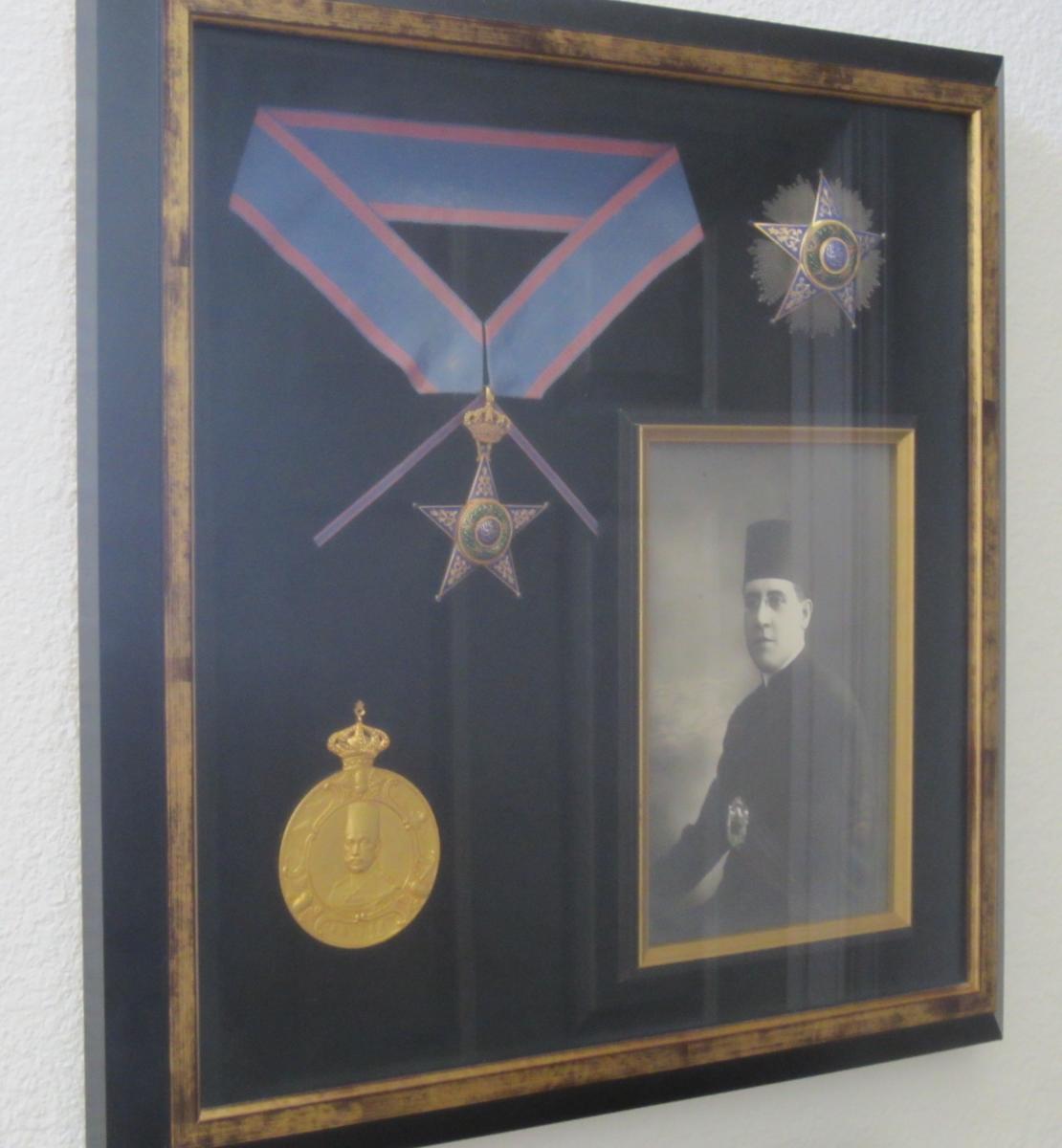
Photograph of the framed Pierre Crabités memorabilia that includes: his 2nd Class Grand Officer Class Order of Ismail neck badge and ribbon (upper left); the Order of Ismail breast star (upper right); the obverse of the bronze Abbas Hilmi II medal commemorating the Khedive’s coronation anniversary and return from the haj, probably struck in January 1909 (lower left); and a 1911 photograph of Crabités wearing the regalia of his role as judge on the Egyptian Mixed Courts’ District Court of Cairo where he served from 1911-1936, consisting of a maroon tarboosh, black stambouline coat, a red sash over his right shoulder running to the decorative bow on the left hip (the sash is barely visible in this image, but the decorative bow is not shown in this photo) and the beautiful gold & silver judicial badge of office is pinned to that sash (lower right). Unfortunately, the mounting places the Order of Ismail neck badge at the back portion of the ribbon with the ties. I had to take the photograph from an oblique angle as the non-musuem-quality glass is highly reflective and I have had poor luck getting any good photographs of this ensemble in its mounting.
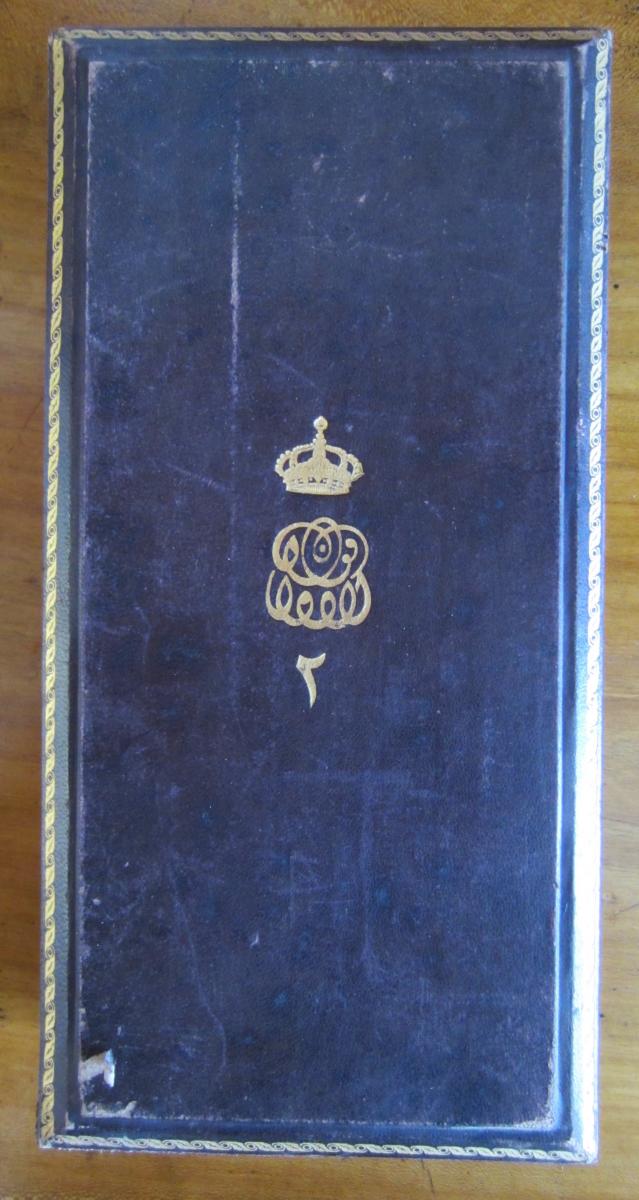
While visiting a member of my wife’s family, I did find the presentation case for the 2nd Class Grand Officer Order of Ismail award to my wife’s great grandfather, Pierre Crabités. The outer lid of the case is shown in the photo above. The blue color is how it appears. To my quantifying, science-minded chagrin, the family member did not have a measuring tape, and the only measuring device I could find in the house was only marked in full inches, not even fractions of an inch. I was not carrying a measuring tape for this visit on the US holiday of Thanksgiving (the anniversary of when I joined GMIC in 2016 after being asked by the family to help identify the medals shown in the frame above, and when another family member showed me the Crabités gold & silver Rudolf Stobbe-made judicial badge in 2019), but will do so on my next visit. Although cases are not as interesting as the awards themselves, I wish to provide a series of photos I took of this case to complement posts I made in October of 2019 about Lattes case construction variations. All of these photos of the Crabités Order of Ismail case can be zoomed for greater detail.
I am not yet able to open the frame and check the date hallmark on the neck badge and breast star, but the cipher of King Fuad I on the case lid does at least bracket when Crabités would have received this award. I have been uncertain whether it would have been prior to, or after his term on the District Courts of Cairo ended in June of 1936. One of the principal authors about the Egyptian Mixed Courts, the American jurist Jasper Yeates Brinton, a judge appointed to the Appeals Court in 1921, made the President of that Court in 1943 and served in that role until 1948, is one of the few writers who not only describes the Mixed Courts’ regalia, but also mentions practices relevant to judges and other Mixed Courts officials being awarded honors by the Egyptian government. His book The Mixed Courts of Egypt, 1930 Yale University Press, New Haven (revised edition published in 1931) states (on page 87 and in note 14 of the 1931 edition) states that there was a general proviso that judges not receive any honorary or material distinctions from the Egyptian Government during their tenure on the Mixed Courts. A formal proposal was made in 1927 to codify this practice and extend such restrictions to other officials on the Mixed Courts, especially in relation to the awarding of the title of "Bey" in recognition long service. At the time of the publication of Brinton's book, this proposal by the Egyptian government had not yet been voted on by the different foreign governments with legal representatives on the Courts, and while still being mooted when Brinton published his book, such a restriction was not supported by many members of the Courts. Brinton notes a customary practice of awarding the outgoing President of the Appeals Court the “highest available decoration” (meaning that if the rolls of recipients of the Order of Mohammed Ali are not yet filled -15 for the Grand Cordon-that would be the honor, otherwise the Grand Cordon of the Order of Ismail-limited to 30 recipients, and then the Grand Cordon of the Order of the Nile, limited to 30 recipients, would probably be offered if all other rolls were filled). I have included several images of a few Mixed Courts’ officers (not necessarily judges in the early 20th century) whose official portraits for the 1926 publication celebrating the 50th anniversary of the Mixed Courts (Les Juridictions Mixtes d'Égypte 1876-1926: Livre d'or Édité sous le Patronage du Conseil de l’Ordre des Avocats á l’Occasion du Cinquantenaire des Tribunaux de la Réforme, par le: Journal des Tribunaux Mixtes. Alexandrie, Egypte, Février 1926) shows them wearing both European and Egyptian medals with their court finery in my thread on the Mixed Court badges (see the 4th photo in my post of 29 April, 2019 of the Belgian Procureur Général Firman Von Den Bosch wearing the Order of the Nile and 2 Belgian awards; the 14th & 15th photos in my post of 6 September, 2019 showing the Greffier en Chef Adib Maakad Bey wearing the Order of the Nile and the 16th photo in that same post showing him in a 1929 portrait sporting the order of the Nile and 3 European awards; and the studio portrait of an unnamed judge or official of the Courts wearing the Order of the Nile in the 1st & 2nd photos of my post of 6 April, 2019, all in the thread I started on 17 November, 2017: “Egypt Khedivate Judge’s Badge question”, here in the Middle East & Arab States section). There are additional portraits of members of the Mixed Courts, including judges, wearing awards with their Court regalia in that 50th Anniversary Les Juridictions Mixtes d'Égypte 1876-1926 volume, principally from the late 19th century before the debated prohibition that Brinton mentions was mooted (see the 8th photo showing the Parquet in 1891 in my post of 29 April, 2019 in the “Egypt Khedivate Judge’s Badge question” thread). I include this long-winded background because I have expected that when I am able to see the reverse of the Crabités neck badge and breast star that the assay hallmark will date to after June 1936 when Crabités resigned from the court. The cipher of Fuad I on the case lid indicates that Crabités was honored with this award during his time sitting on the bench, prior to Fuad I’s death on 28 April, 1936. Crabités was quite friendly with the royal family and was allowed to make liberal use of King Fuad I’s library. As the Order of Ismial was awarded specifically “…to those who rendered eminent services to the nation”, as Owain Raw-Reese writes on page 20 of his 2006 article in Journal of the Orders and Medals Society of America (JOMSA). Vol 57 (4):15-23, I have always suspected that his Order of Ismail may have been awarded for his written works lionizing Khedive Ismail (1927, "Ismail the Magnificent.” Nineteenth Century 102 (1927): 108-119; Crabités later expansion of this into a book post-dates his departure from Egypt: 1938, Ismail, The Maligned Khedive. London: Routledge, the only biography of Khedive Ismail) whose reputation was significantly tarnished by several European authors, a perspective that currently considered much more harsh than warranted, focusing on debts created under his realm and downplaying his attempts at reform in Egypt. I don’t know if I will ever learn why Crabités was awarded the Order of Ismail, whether it was for a specific act(s) or just his service on the Mixed Courts and friendship with King Fuad I. However, perhaps when I can examine the date hallmark identifying when in his career as jurist and author he was honored, it may suggest a reason for his recognition by King Fuad I.
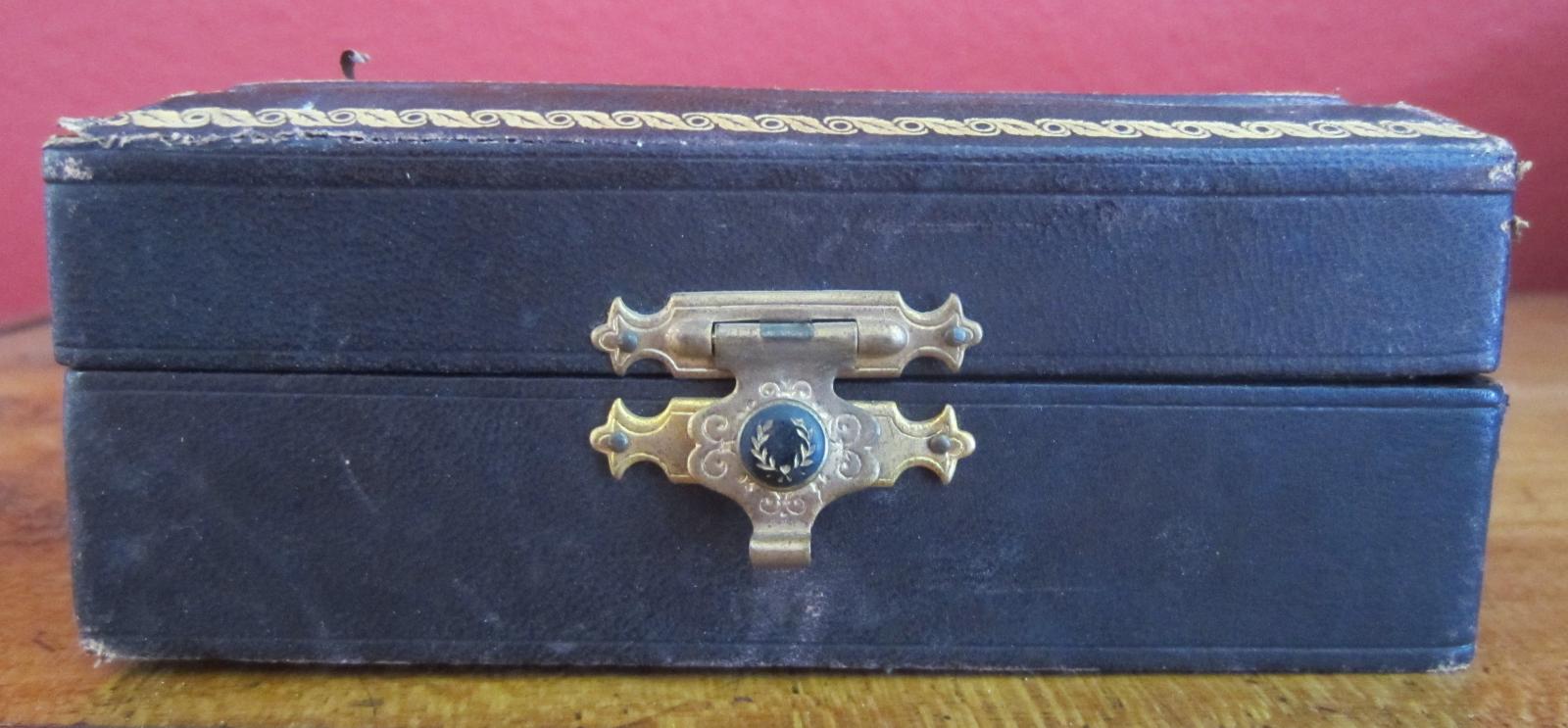
Image of the pull release catch hardware on the Crabités case for his 2nd Class Order of Ismail. I previously illustrated 2 examples of this decorated form of release catch on this thread; as the 3rd-to-last photo in my post of 19 October, 2019 showing the same form of catch on a cased 1st Class Grand Cordon set of the Order of Ismail, and as the 15th, 16th & 18th photos (most detailed in the 16th, photo) in my first of 2 posts on 21 October, 2019 showing the catch on a third Class Order of the Nile case from an eMedals auction. When zoomed, this image provides better detail of this pull release catch than those photos. This example (and the other 2 referenced above in previous photos on this thread) is the most elaborate form of the release catch I have seen on Lattes cases for the Order of Ismail or the Order of the Nile.
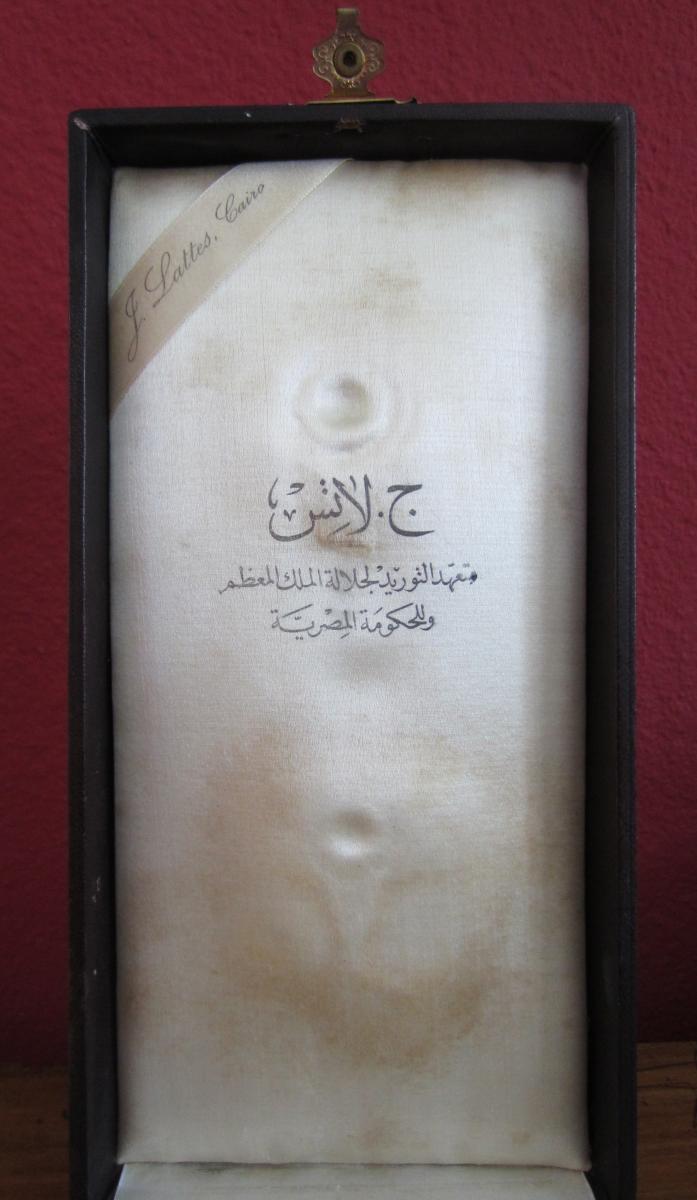
Interior of the lid of the Crabités Order of Ismail case showing the J. Lattes label. Some details of the interior of the decorated pull release catch can be seen in the upper margin of this photograph.
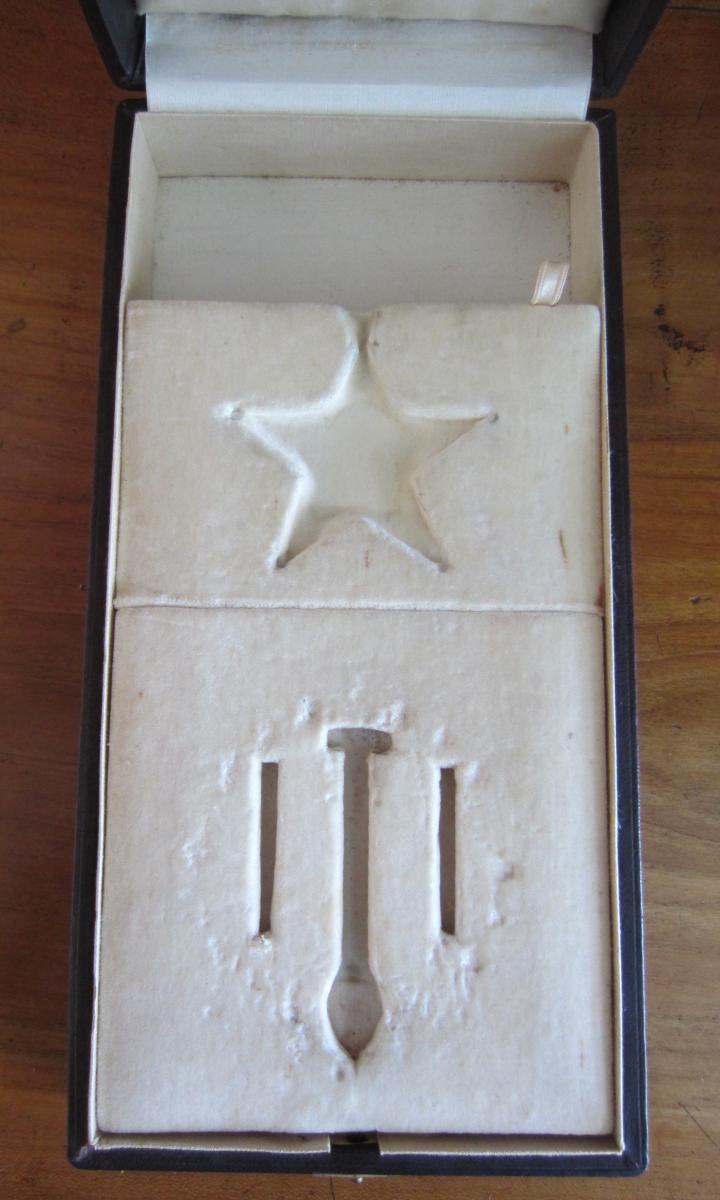
Photo of the medal bed of the Crabités case for his 2nd Class Order of Ismail. This medal bed shows the interior cutout at the inferior margin of the resting spot for the breast star (contiguous with the cutout for the central tunic pin) for easier removal of the star. Such cutouts are not present on all Lattes cases. Note the silk pull ribbon on the upper right margin of the folding cover for the neck ribbon to open the compartment (shown below). I illustrated two other examples of this configuration in several photos of my post of 19 October, 2019 on this thread: the 2nd-to-last photo of that post of showing Dr. Giovanni Quirico's 2nd Class Order of Ismail from a La Galerie Numismatique auction; and in the 4th-to-last, 6th-to-last, & 7th-to-last photos in the same 19 October post of a 2nd Class set of the Order of Ismail from a December 2017 eBay auction. Those previously posted photos also show the complete set of neck badge with ribbon and breast star of the Grand Officer insignia in place within their cases.
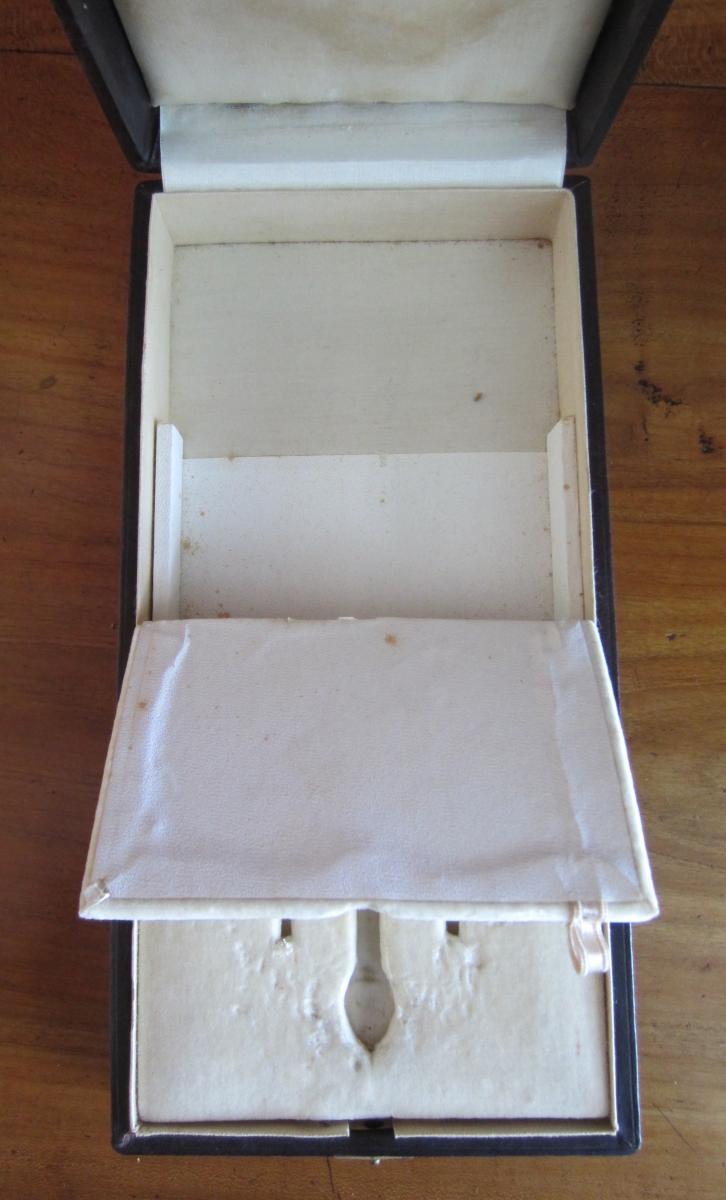
Photo of the medal bed of the Crabités Grand Officer Order of Ismail case showing the hinged cover for the compartment where the folded neck ribbon is stored. The same previously referenced images for the preceding image of the medal bed, from my 19 October, 2019 post on this thread, show the neck ribbon tucked into this compartment, although the hinged cover is shown closed, not in the open position.

Image of the interior of the Crabités Grand Officer Order of Ismail case with the medal bed removed showing some construction details of the case interior. I posted a comparable image of an empty Order of Ismail case from a past eMedals auction (only the case without the medal bed was offered in that auction) as the 4th photo in my 2nd post on 21 October, 2019 on this thread (although the class is unspecified in the eMedals auction description that empty case, the Arabic number on the exterior case lid indicates it was for a 1st Class Grand Cordon Class award). That photo posted on 21 October shows the grooved wooden block (that sits above the sliding mechanism seen in lower edge this photo above) removed to reveal the interior push catch mechanism below this wooden block (in addition to missing some of the fabric lining present on the rests for the medal bed in the above image of the Crabités case). Although the entire medal bed now lifts out easily, a small amount of yellowed glue is visible on the cloth of the narrow ledges of each lateral edge just to viewer's direction of where the lining of the interior stops, indicating that the bed previously was glued into place. This image also shows the thin, lightweight wood used for the case construction.

The underside of the Crabités Grand Officer Order of Ismail case showing the different material covering the base of the case compared with the coated cloth “mock leather” of the sides and upper lid. The latch is oriented at the bottom of the above photo. I posted a similar photo as the 2nd image in my 2nd post on 21 October, 2019 on this thread showing the underside of an Order of Ismail case from the same eMedals auction of an empty case without its medal bed as discussed for the previous image of the Crabités case interior.
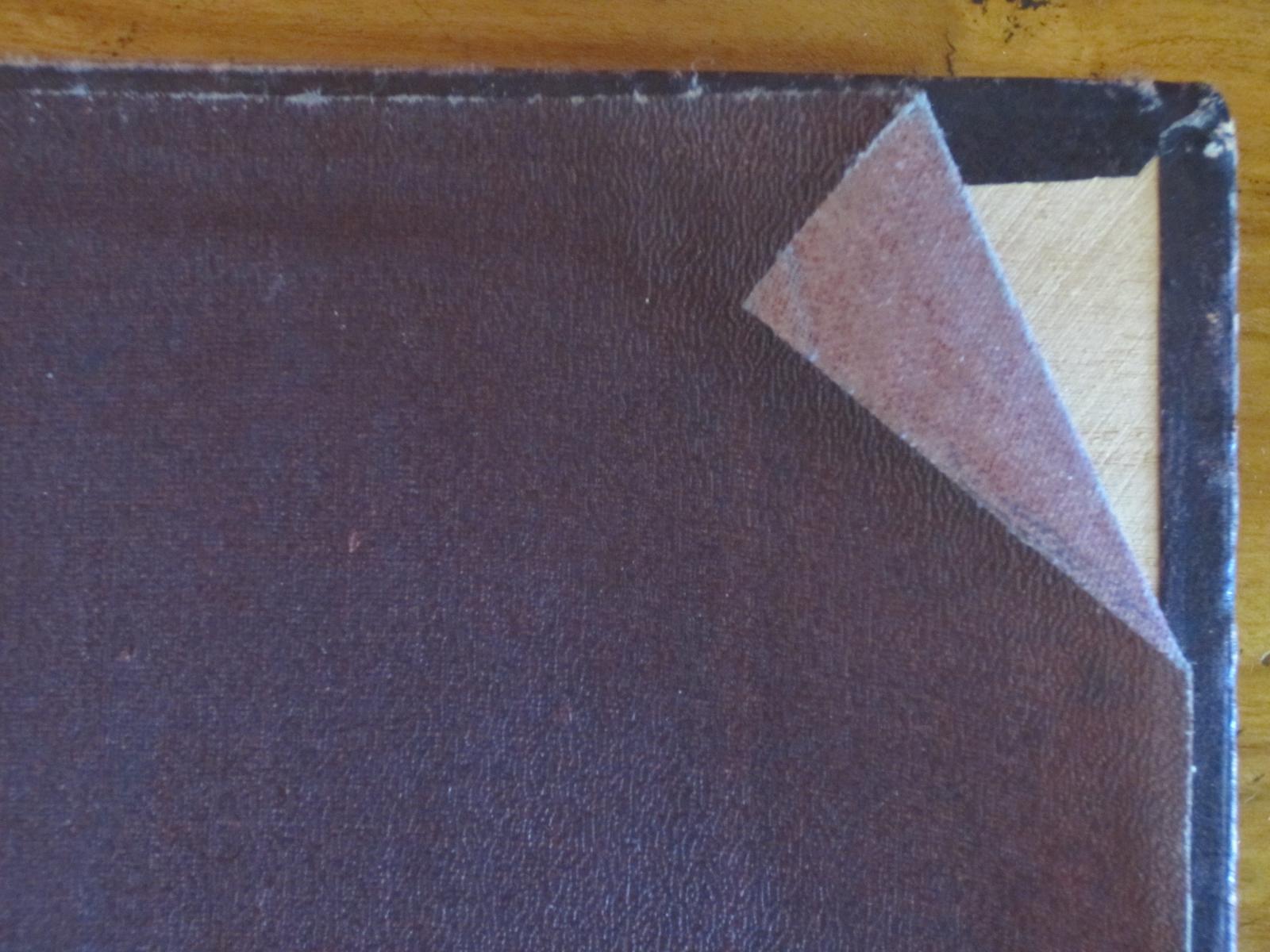
Close up of the covering of the underside of the Crabités Order of Ismail case where the material has been loosened and has been stored folded over. This permits an opportuniyt to see both sides of this covering. This material appears to be a coated paper cover on the underside, not a coated cloth cover. The folded-down corner reveals the light wood base of the case’s interior construction.
0 -
Below are a few good illustrations of a 3rd Class Commander neck badge of the Order of Ismail made by Tewfik Bichay. This is a good example of the Bichay workmanship that is very comparable to that performed in the Lattes workshop. These photos come from a 4 December, 2020 auction listing (No. 43), Lot 193, on the La Gazette Drout website (https://www.gazette-drouot.com/lots/8238067). The offering included the neck ribbon and case. Although the recipient is named, no information is provided whether a brevet is associated with this award. The illustrations on the website can be zoomed for greater detail than the images I was able to download. However, the images below can be enlarged for additionally detailed views of this piece (except the cropped photo of the silver foil Tewfik Bichay interior case label).
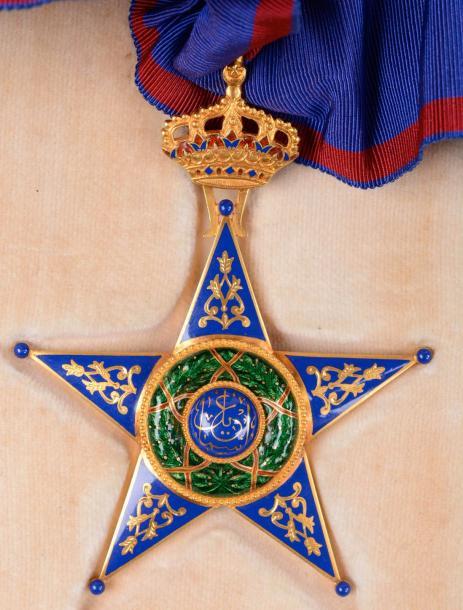
Moderate-resolution image of this Tewfik Bichay-made Commander neck badge. the auction listing correctly identifies this neck badge as a 3rd Class regalia made of 18 k gold. It provides an approximate weight of ~50 g, but no dimensions are given. The description identifies the recipient as Monsieur René Ossola, the General Manager of the Cairo Electric Railways Heliopolois Oases Co (a property development company founded in February, 1906). The listing includes a date of 1946 that may either the award date or the assay date for this badge. No images are provided showing the reverse of this neck badge. A photo of the exterior cover of the case has the cipher of King Farouk I.
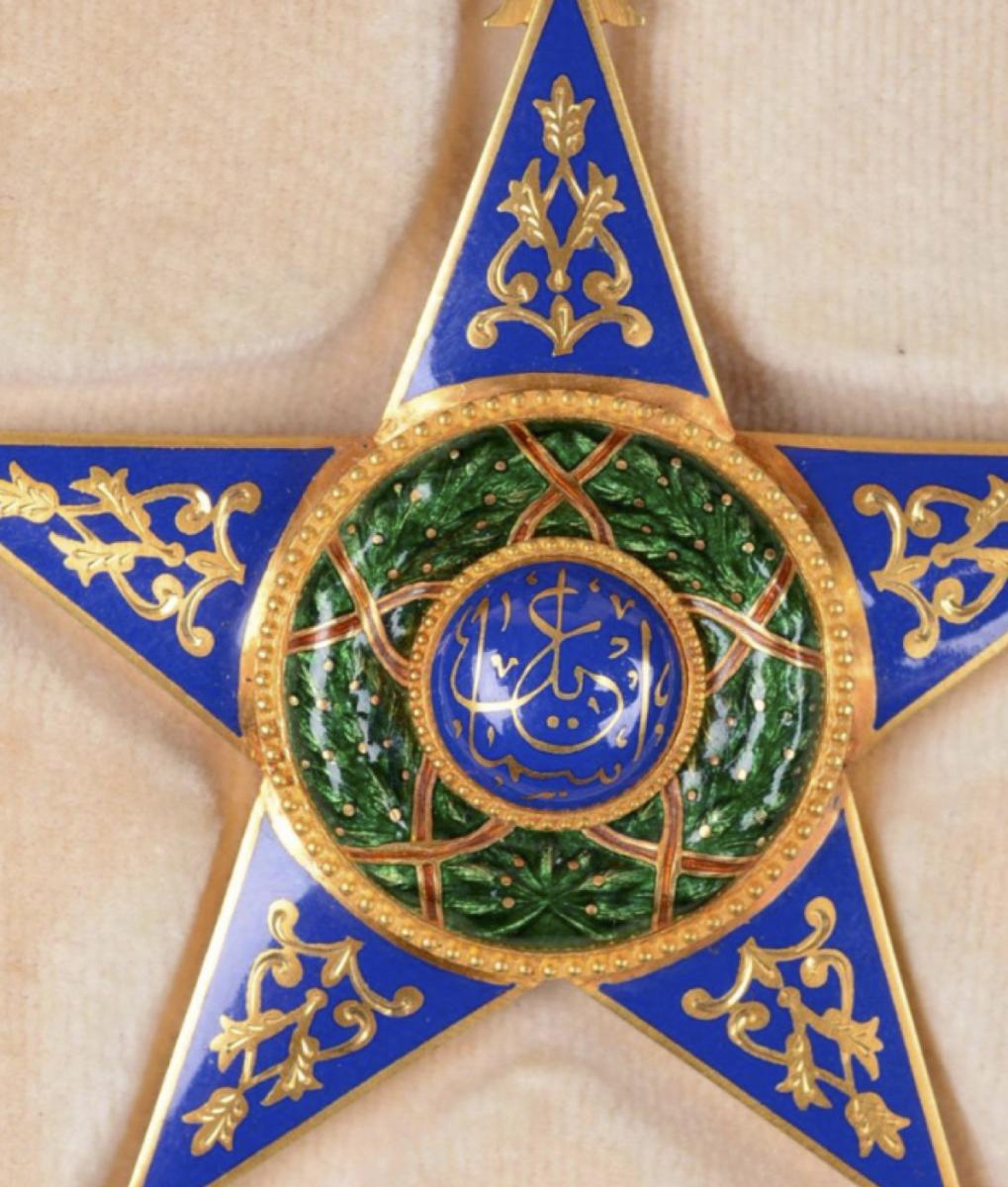
Cropped close-up of the image of the obverse of this Tewfik Bichay neck badge detailing workmanship and design of this Bichay example of the Order of Ismail. This image can be zoomed for comparison of the design and execution of this insignia with other J. Lattes, Tewfik Bichay neck & sash badges, and the one Fahmy Tewfik Bichay neck badge shown in this thread. The engraving on the gold floral designs of the blue enamel arms is identical in design layout to those of many J. Lattes examples, and well-executed. The most distal flower exhibits 3 lateral engraving marks on each half of that blossom and a single distal mark ornamenting the central petal. The 2 central flowers have three lateral engraving marks and a single mark oriented just proximal of the separation between the most medial petal and the central petal of each of these blossoms. A single mark is present at the proximal joint of these 2 central flowers that is a bit unlike some Lattes examples using a single dot or punch, this is a "comma"-shaped that is quite delicate & elegant on the left lateral arm (~9:30 position), the right lateral arm (~2:30 position), and probably on the lower left arm (~7:00 position). This mark on this origin point of the 2 central flowers of the other 2 arms (superior 12:00 position & the lower right ~5:00 position) appears to be single punches, and may be slightly off-center on the lower right arm. The single engraved line in the most proximal "bud" component of the 2 most proximal leaf elements is thinner than on many Lattes examples. The curling engraved lines in the leaf elements of the gold ornamenting the blue enamel arms exhibit a grace & moving flow as sen on the best engraving of pieces made by the Lattes workshop. The wreath element surrounding the central inscribed medallion boss shows a different number and arrangement of gold laurel-fruit dots in each panel of the great compared to Lattes examples. The distribution and number of these fruit dots is identical to those shown in the high-resolution image of a Tewfik Bichay 1st Class sash badge from a fall 2014 Fritz Rudolf Künker GmbH & Co. KG auction (that has the wreath slightly rotated out of correct orientation to the left) shown in the 3rd-to-last photo of my post of 28 March, 2020 discussing design variation in the Commander neck badges of this Order. The wreath configuration also is apparently identical to the lower resolution photo (5th-to-last) in my 28 March post from Hassan Kamal-Kelisi Morali’s flickr photostream that I believe is an example of a Tewfik Bichay piece. The wreath also is identical to that on the odd neck badge shown as the 4th illustration of my 28 March post and again discussed in my post of 13 August, 2020 that Owain alerted me to on a Spink Auction (Auction 20002, Lot 985) and shown in detail as the 3rd photo in that post, which exhibits a "LATTES" maker's mark on the reverse of the central medallion boss, but appears to have been refit with a Bichay central medallion's wreath (and possibly the central inscribed boss portion of the medallion). The green enamel of the wreath on this example appears quite thick, but the molded laurel leaves seen through the enamel do not appear 3-dimensional as is commonly seen on the Lattes examples, but also on the Tewfik Bichay examples referenced above. The smooth surface of the wreath may just be due to thicker enamel on this piece and not any design difference in the Bichay execution. As noted, the Fritz Rudolf Künker sash badge & breast star, the Hassan Kamal-Kelisi Morali neck badge, and the wreath from what I think is a bit of a chimera reconstruction combining a Bichay medallion (or at least the wreath element) with a Lattes-made components do show the uneven surface of the leaves in the enamel, as on all J. Lattes insignia. The above illustration when zoomed (or enlarged even more on the La Gazette Drout auction listing's illustrations) also shows well the differences seen in the design of the Tewfik Bichay gold & red enable bands around the wreath compared to their execution on Lattes-made pieces. The illustration above clearly appears to show thinner & slightly more irregular gold margins, a thinner channel of red enamel, and this example shows well that several bands are not completely filled with enamel, all in contrast with the execution of these bands under the Lattes workshop name.
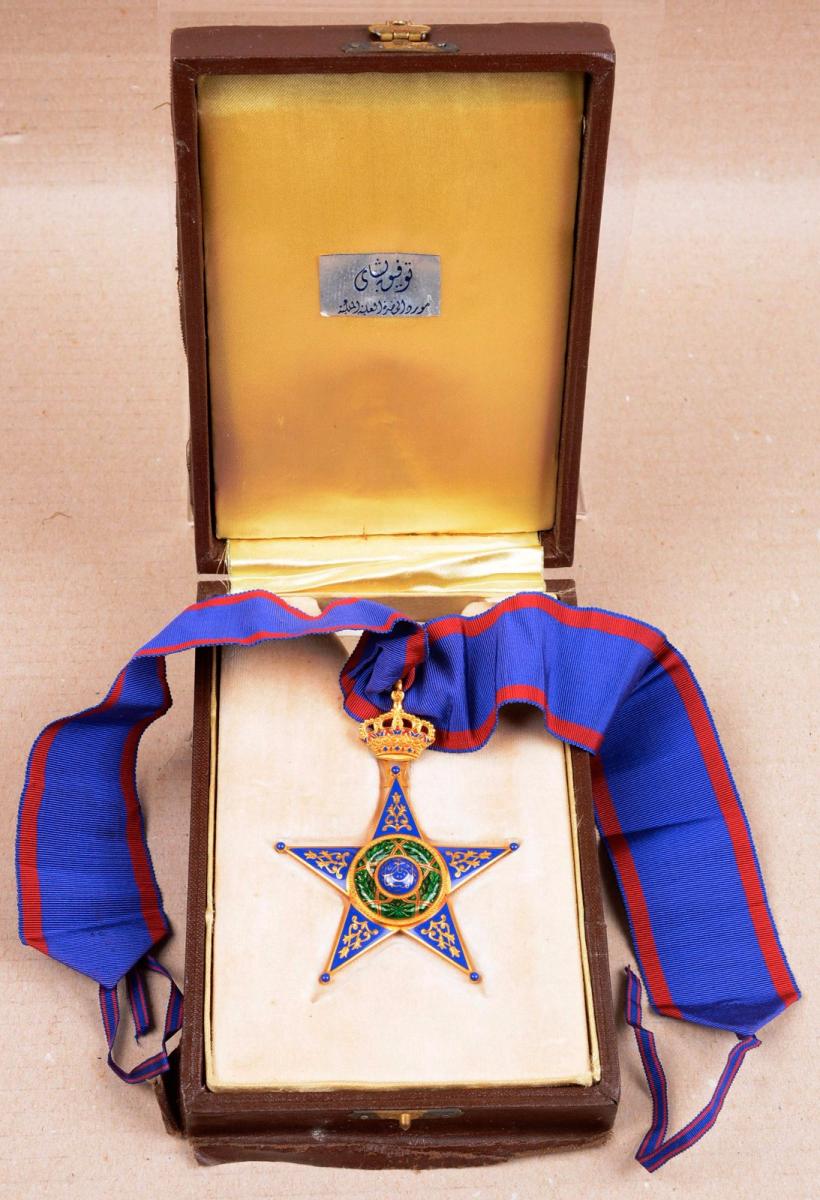
Image of the same 3rd Class neck badge resting in the medal bed of its case. This photo nicely shows the 2 ties for the ties at the back of the neck ribbon. A silver foil label with the name of Tewfik Bichay is present on the interior of the lid. I have not seen this form of the Tewfik Bichay label in illustrations of other examples of the Order of Ismail or the Order of the Nile (many more auction listings are available to see cases and labels of Tewfik Bichay for the more commonly awarded Order of the Nile than for the Order of Ismail).
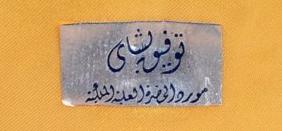
Cropped slight enlargement of the Tewfik Bichay silver foil label in the case for this 3rd Class Commander neck badge.
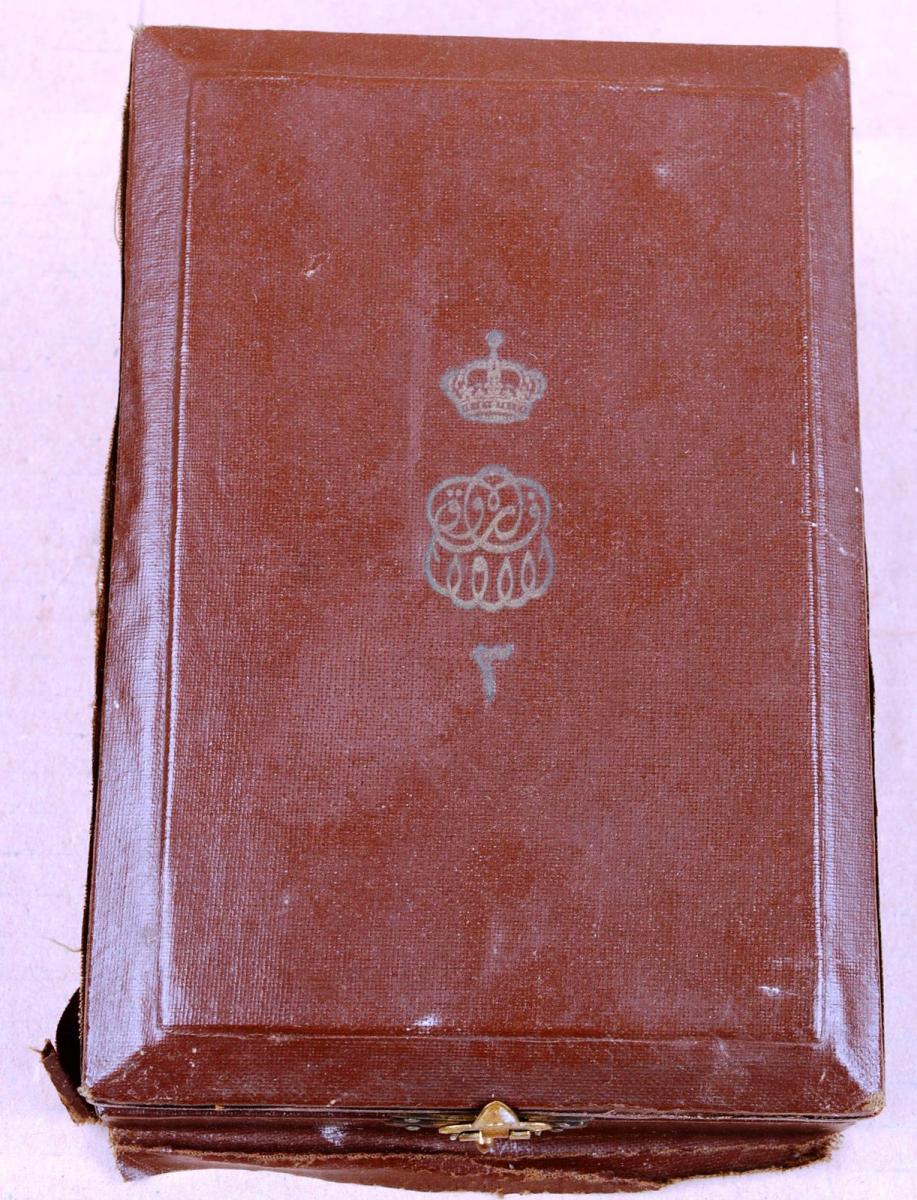
Good resolution photo of the outer case lid of this Order of Ismail neck badge showing the cipher of King Farouk I. Although the case is a bit disheveled, it does show well the threads of the coated cloth cover of the case. Compared with other better-quality illustrations I have found of J. Lattes cases (for both the Order of Ismail and the more common cases for the Oder of the Nile), this coating does not effectively create a mock leather look as well as many of the Lattes cases (however, see the case that Owain illustrated as the 1st photo for a Fahmy Tewfik Bichay-made 3rd Class neck badge in his post of 5 April, 2018 on this thread).
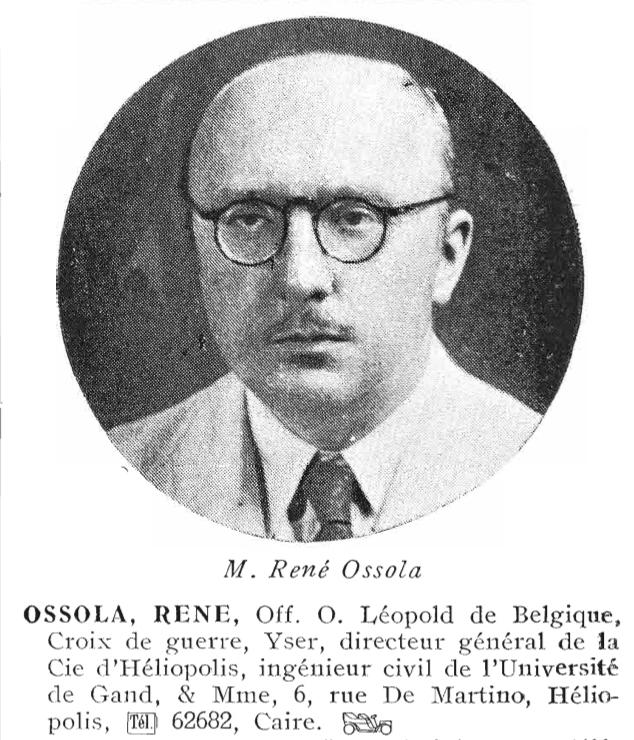
Above is the biography of Monsieur René Ossola, from pg 207 of Le Mondain Egyptian: The Egyptian Who’s Who. 1943. L’Annuaire de l’Elite d’ Egypte. Part II. F. E. Noury et Fils, Le Caire. It notes that he is a recipient of the 4th Class Officer Order of Leopold, Officer's Cross, Military Division. This is prior to his award of the 3rd Class Order of Ismail, or it would be listed in this biographical sketch. The same bio also appears in the 1939 (pg. 304) and 1941 (pg. 228) editions of Le Mondain Egyptien.
I was quite interested to see these good illustrations of this Tewfik Bichay-made Commander neck badge in relation to points brought up by Owain in his his interview notes with Fahmy Tewfik Bichay on his post of 19 August, 2020 on this thread. Pursuant to conversations with Owain and 922F, it would be interesting to compare the date hallmarks on the latest J. Lattes made-Egyptian awards with the earliest assay date hallmarks for Bichay-made pieces to see when Tewfik Bichay took over running the workshop and began placing his name on these awards. Owain has suggested such a task would involve comparisons across a range of Egyptian awards from the 1930s-early 1940s, as no single award may be represented adequately through my research reliant on using auction listings. That also would allow a better sample view of the total repertoire change from Lattes marked awards to Bichay pieces, sometime in the 1930s. Supposedly, the Tewfik Bichay marked 1st Class sash badge & breast star from the fall 2014 Fritz Rudolf Künker GmbH & Co. KG auction (discussed above and the sash badge was illustrated as the 3rd-to-last photo in my post of 28 March, 2020 and discussion of the breast star shown as the 8th photo in my post of 31 January, 2020 detailing design variation in breast stars) carries an assay hallmark of 1929-1930 ("D"). The auction description only states that the date hallmark is a "D" and the accompanying photo of the hallmark is unclear to me (as noted in my discussion in those posts). This seems an unlikely early date for Bichay-marked pieces, several well-illustrated Lattes-made Order of Ismail insignia show "F" assay date hallmarks from 1931-1932. I illustrated a 4th Class Knight breast badge from a past Spink Auction (Auction 19001, Lot 1179) as the 4th image in my post of 8 July, 2020 discussing design variation of the Knights' badge design that states (no photos of the revers are provided in the listing) it has a Lattes mark on the reverse and a date hallmark of "K" (1935-1936) that would be the latest date hallmark I have encountered on a Lattes-made Order of Ismail. Perhaps, if I have any initial success I may be able to start a new thread focused on this chronological question and solicit contributions from collectors in the GMIC community. So many aspect of the life of J. Lattes are obscure that even such a simple question as when Tewfik Bichay took over the manufacture of Egyptian insignia from Maison Lattes would be of some interest.
0 -
An historically interesting story was reported today about a medal sale that has resulted in the recognition of the first mixed-race individual commissioned as an officer in the British Army in WWI and the first black British Army officer killed during that war, Second Lieutenant Euan Lucie-Smith of Jamaica. The commemorative plaque of his death was recently purchased by the The Royal Regiment of Fusiliers Museum (Warwickshire) from a November, 2020 auction by Dix Noonan Webb (https://www.dnw.co.uk/news-and-events/latest-news/article.php?article_id=446). The commemorative plaque sparked research (much of it by the collector to offered it for auction) about Lt. Euan Lucie-Smith of the Royal Regiment of Fusiliers Museum (Warwickshire), confirming him as the first black British Army casualty of WWI. The plaque was put up for auction by a British collector, James Carver, who specializes in medals relating to West African soldiers of the Victorian and Edwardian era. Mr. Carver felt that the plaque's historical value would be augmented through the publicity of its sale, and its eventual purchase by the Royal Regiment of Fusiliers Museum is a very fitting home for this historical piece. A BBC news story today (https://www.bbc.com/news/uk-england-coventry-warwickshire-54964074), a 23 October, 2020 story in the metro.news website about the Dix Noonan Webb offering (https://www.metro.news/plaque-to-first-black-officer-in-british-army-rewrites-history/2192968/), among other news sources (i.e., a 17 November, 2020 story on the Military & History website: https://www.militaria-history.co.uk/news/record-price-for-wwi-plaque/), provide additional details on this valuable phaleristics story.
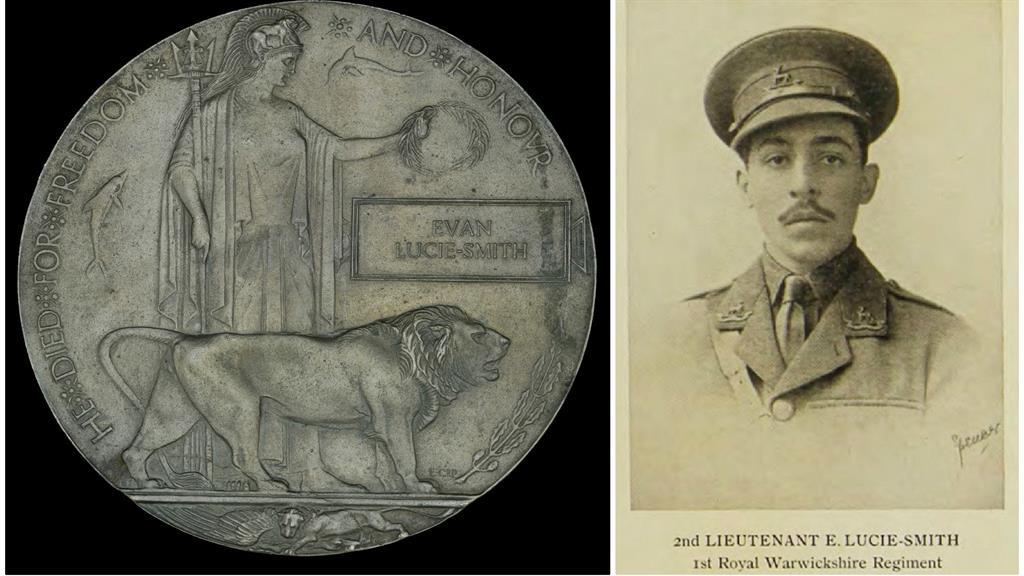
image of the commemorative plaque (L) and a photo of 2nd Lieutenant Euan Lucie-Smith from the world.press website (https://www.metro.news/plaque-to-first-black-officer-in-british-army-rewrites-history/2192968/).
1 -
To return to information about the real Order of Ismail, I am including a photo below of an individual wearing the neck badge and breast star of the Order of Ismail, probably the 2nd Class Grand Officer. The individual is not named in the captions I have been able to find for this image that shows the Prime Minister Mahmoud El Nokrashy Pasha during part of the Mahmal ceremony in Cairo.

This photo shows Prime Minister Mahmoud Pasha El-Nokrashy being handed the reigns of the camel that is carrying the Mahmal as part of the Holy Carpet ceremony before the Mahmal makes its journey from Cairo with pilgrims to Mecca. This photo comes from Ash Baraka's Twitter site (https://twitter.com/Ash_Baraka/status/1261051446365171718/photo/1) and the same image also is available on Getty Images. Both sources provide the same information. The unidentified man on the viewer's far right is wearing the breast star of the Order of Ismail and it appear that he also is wearing the neck badge of this order as well. The reflection on the neck badge does not make it clear that it is the Order of Ismail, but that is almost certainly the Ismail neck badge as the Order of Ismail breast star is the only decoration he is wearing other than his ribbon bar. This photo is probably from 20 January, 1947. Getty images identifies the photo source as Keystone/Hulton Archive. A film of this event also is available online that shows the same man on the far right with the Order of Ismail regalia, Prime Minister Mahmoud Pasha El-Nokrashy (including this scene of him receiving the camel's begins), and parade events associated with the Holy Carpet ceremony. That film can be seen through the British Pathé newsreel on YouTube (https://www.youtube.com/watch?v=FYg783dyoFE). The man wearing the Order of Ismail in the above photo is shown from 55 seconds in to 1 min and 1 sec into the film, and from 1 min 36 sec to 1 min 38 seconds into the 2 min 7 second news clip. Another man in military uniform appears to be wearing a 4th Class Knight breast badge of the Order of Ismail from 8-11 seconds into the film, riding in a carriage and seated next to Prime Minister Mahmoud Pasha El-Nokrashy. He also appears in the following shot from 11-16 seconds into the film standing to the viewer's right of Mahmoud Pasha El-Nokrashy and saluting. This news reel film is titled "Holy Carpet Leaves for Mecca (1946)" the date is probably incorrect and January 1947 is the more likely date of this event.
British Pathé on YouTube also has a 2 minute 26 second film of King Adulaziz Ibn Saud of Arabia visiting Egypt on January 11, 1946 (titled "King Ibn Saud in Egypt [1946]") that shows King Farouk I and Ahmed Hassanenin Pasha wearing the Order of Ismail (https://www.youtube.com/watch?v=HW9yXtU-B9s). I included a still photo of this event showing King Farouk I and Ahmed Hassanein each wearing the Grand Cordon breast star of the Order of Ismail as the 6th photo in the post of 24 March, 2019 on this thread. The British Pathé/YouTube news reel shows both King Farouk I and Ahmed Hassanein with clear images of the Order of Ismai, and several other of their awards, multiple times in parade with the Saudi King and at later events. This film also is interesting in relation to this thread as I believe it shows Abdullah al-Nagoumi Pasha walking with the parading group. I illustrated Abdullah al-Nagoumi Pasha wearing the neck badge of the 3rd Class Commander Order of Ismail as the 1st photo in my post of 29 August, 2019 (and in the 2nd, 3rd, & 4th photos of that post as well, without the Order of Ismail decoration). In the film, al-Nagoumi Pasha is wearing the neck badge of the Order of the Nile, but not the Order of Ismail while visible from 1 minute 4 second to 1 minute 9 seconds into the film on the left side of the frame walking just ahead of King Adulaziz Ibn Saud and King Farouk I. Another person shown parading in a Royal Guard uniform (on the viewer's right side of the frame) in this film clip is wearing the 4th Class breast badge of the Order Ismail between 1 min 23 seconds and 1 minute 28 seconds. I believe that individual probably is Osman El Mahdi Pasha, who is pictured wearing the 4th Class Knight Order of Ismail breast badge in a previous illustration of him as the 3rd man from the left seated on a couch in the 4th photo of my post of 29 August, 2019. A cropped and slightly enlarged version of that image of Osman El Mahdi Pasha is shown in my post of 4 September, 2019 on this thread. Another photo that I think may show a portrait of Osman El Mahdi as a younger man, also wearing the 4th class breast badge of the Order of Ismail, is the 5th image in my post of 29 August, 2019.
0 -
A second eBay seller from the Russian Federation also is offering a modern copy of the Egyptian Order of Ismail, this seller is identified as running the MedalsShop (https://www.ebay.com/str/RusMedals?_trksid=p2047675.l2563). This appears to be the same workmanship as the example I illustrated yesterday, which is a good-quality copy of the design elements of authentic regalia of this award. This listing also identifies this as a copy and describes the materials as a "molding color alloy" of nickel, tin, brass, & zinc and calls the colored portions "enamel". The dimensions are given as 8 xm X 8 cm and has a weight of 53 g. "Cold enamel" (as described for the AwardsEmpire copy) is a pigmented epoxy resin that is painted on, it does not require curing with high temperatures, and adheres to a range of materials . This additional eBay offering of this copy provides a few slightly higher-resolution images that I am including below.
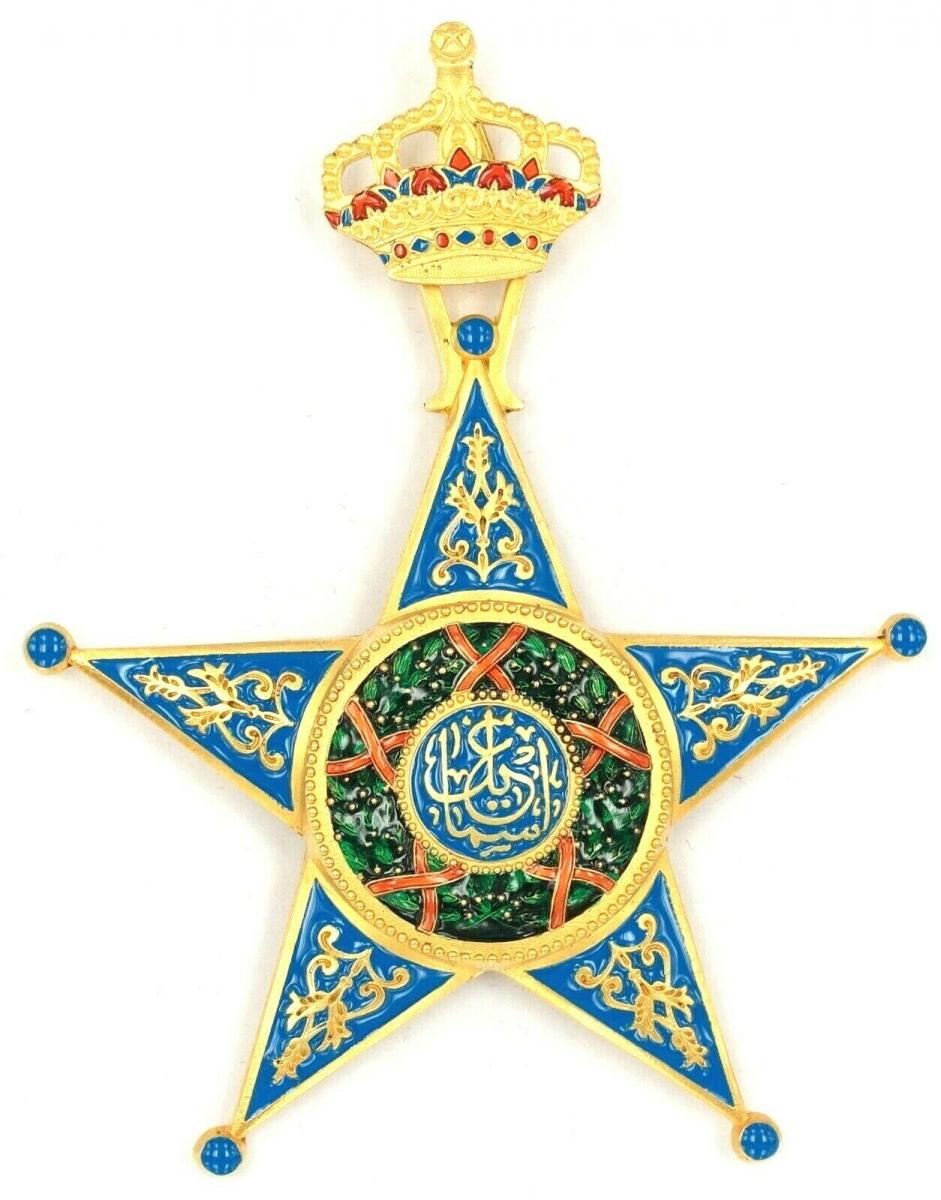
Obverse of the MedalsShop copy of the Order of Ismail that is the same workmanship and design as the AwardsEmpire offering I posted here yesterday.

Reverse of the same MedalsShop copy of an Egyptian Order of Ismail on the eBay website.
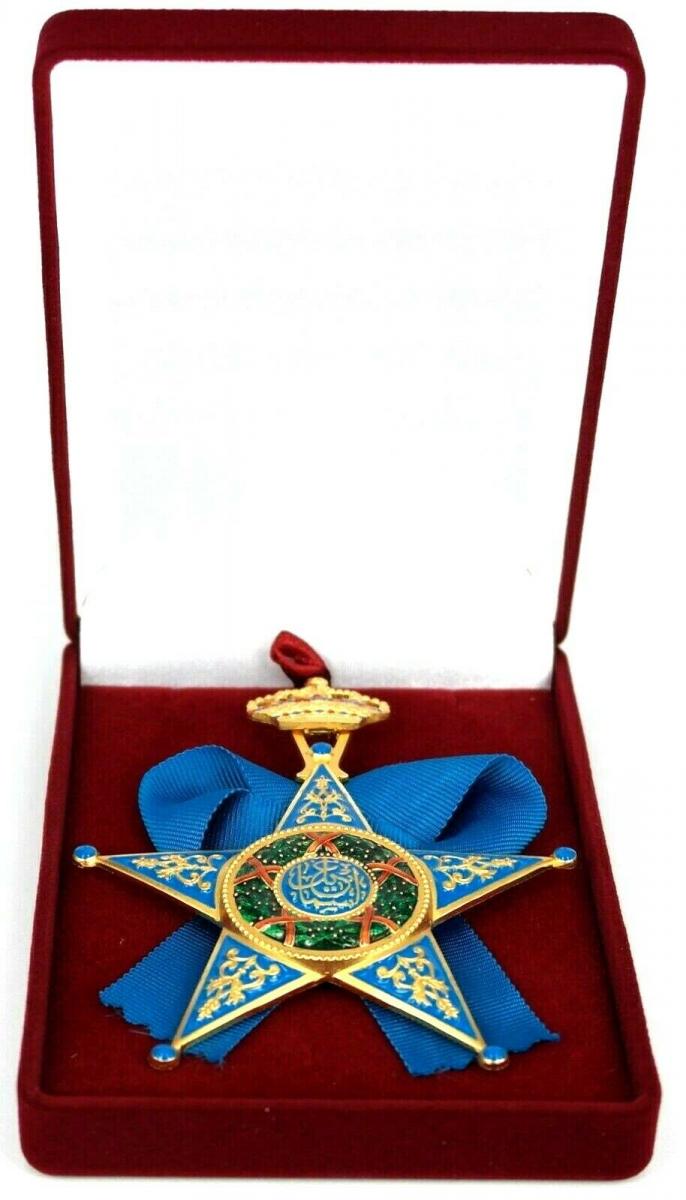
The MedalsShop copy of an Order of Ismail "neck badge" in its case showing the same incorrect ribbon color scheme and form as offered in the AwardsEmpire eBay listing.
0 -
A current eBay listing is offering a copy of the Egyptian Order of Ismail from a seller based in the Ukraine (https://www.ebay.com/itm/Kingdom-of-Egypt-imperial-award-Order-of-Nishan-Al-Ismail-1915-y-type-copy-/114479374343). The eBay description does clearly identify this as a copy, as are other offerings from this business, AwardsEmpire. The description states that the materials are alloy plating and cold enamel (painting?). Although a copy, the detail is fairly accurate, if much less beautiful than the real thing.
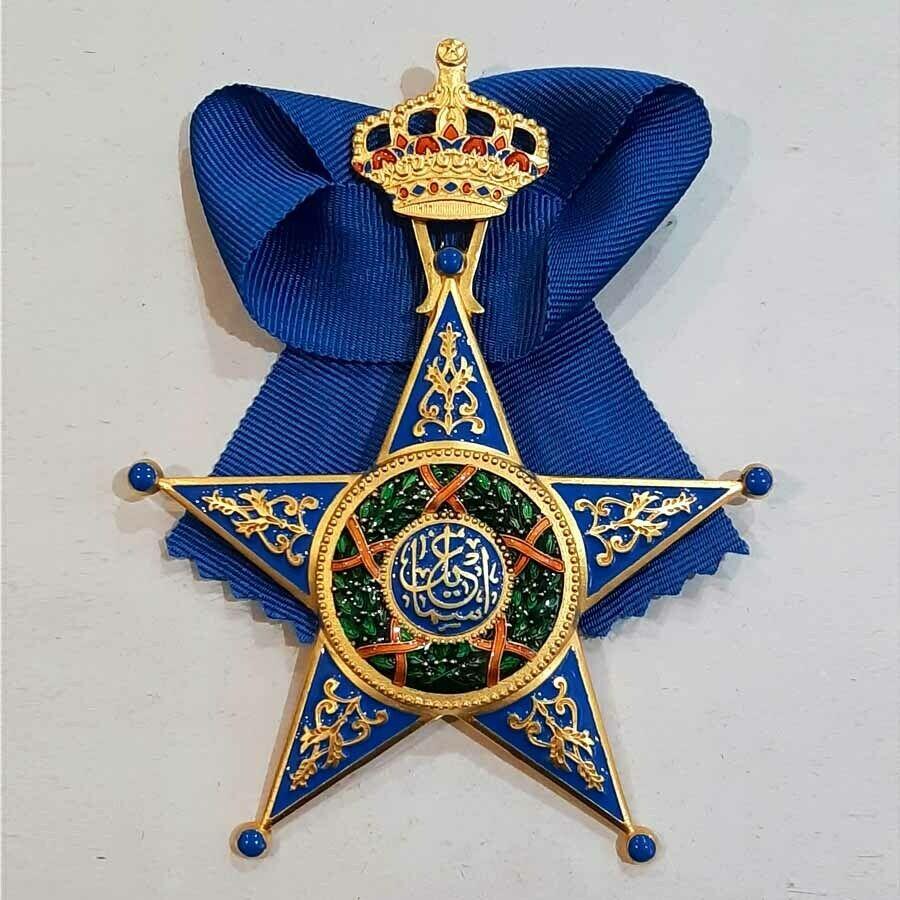
Obverse of this eBay seller's copy of a neck badge of the Order of Ismail, associated with an incorrect color scheme and form of ribbon. While a quite faithful copy of the design elements, the workmanship is clearly that of a cast copy.
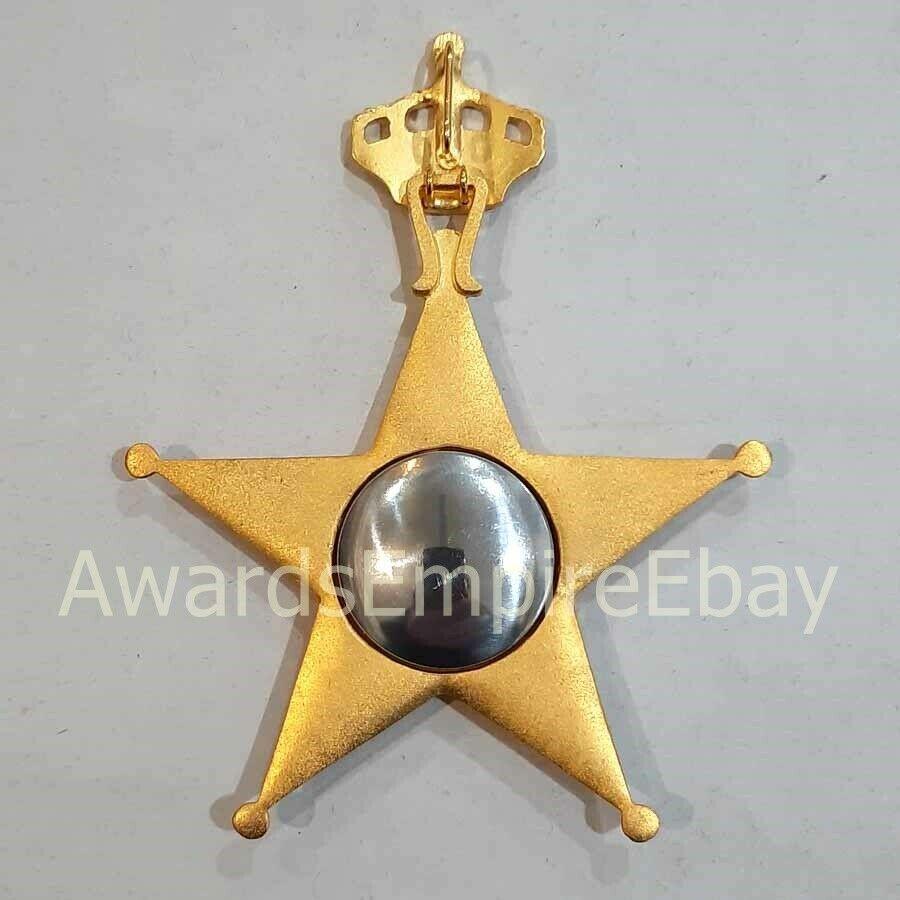
Reverse of this same copy of an Order of Ismail offered by AwardsEmpire from the current eBay listing.
0 -
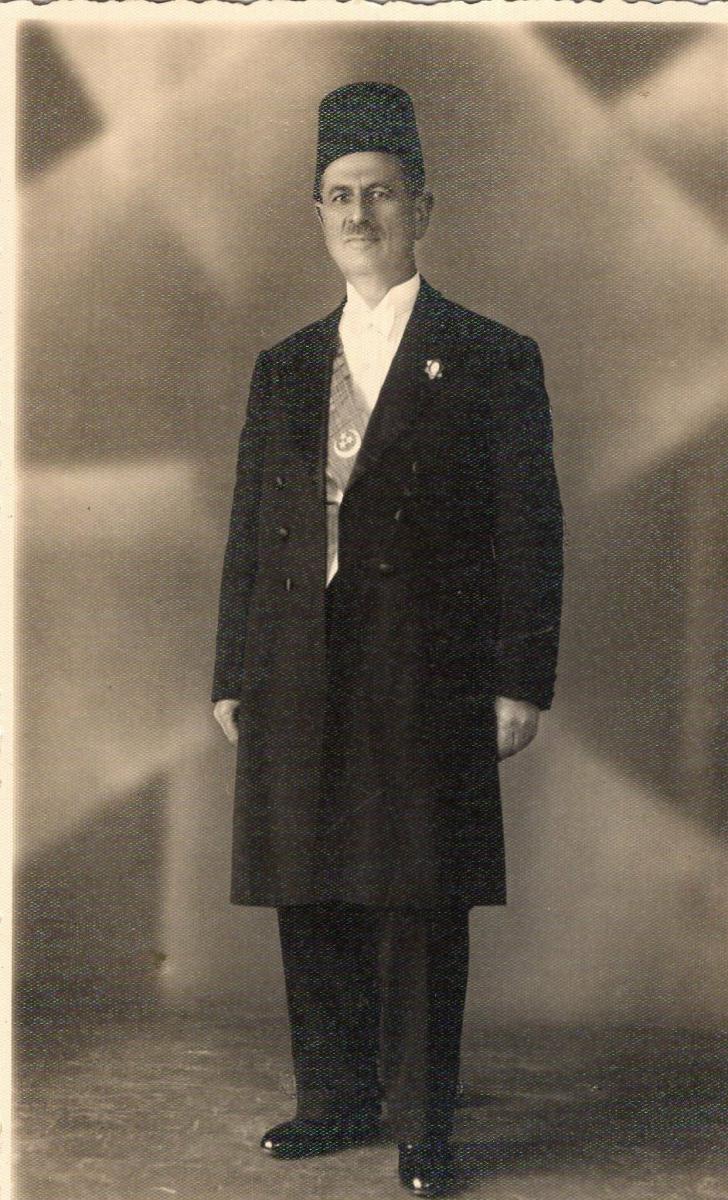
Above is another photograph from a current eBay auction of a member of the Egyptian Upper House of Parliament, the Chamber of Senators. This low-resolution portrait is from the same eBay seller who offered the other images of members of the Egyptian Parliament that I have posted previously (https://www.ebay.com/itm/Egyptian-vintage-photographer-Judge-with-the-judicial-scarf/274549368559?hash=item3fec6ae6ef:g:Aa4AAOSwvddflthA) on my 24 July, 2020 in this thread. The eBay listing states that this is an original print and the size is 14 X 9 cm. No studio name is visible on the photo and none is included in the auction description. As with several of those images, the eBay listing mistakenly identifies the individual as a judge, but it does state that the source is an unspecified Egyptian photographer. The sash with the crescent & 3 stars is visible, although any border difference from the main body of the sash is not apparent in this photo. The oval shape of the lapel badge is the same for both houses of the Egyptian Parliament, but the six multi-rayed embellishment can be seen on this badge and identifies this individual as a member of the Chamber of Senators. He wears white tie and a long western-style coat as do 2 of the other portraits of members of the Chamber of Deputies that I included as the 3rd and 4th-to-last photos in my post here of 24 July.
Although the discussion here presents the 2 insignia as a neck badge and lapel badge, as do some auction listings (for example, a current offering in a Dixons Medals listing of a badge of the Chamber of Senators, SKU 1036054 - https://www.dixonsmedals.com/product/single-medals/order-of-the-nile-egypt-breast-badge-65mm-including-crown-suspension-x-41mm-chamber-of-senators-neck-badge-by-lattes-of-cario-63mm-silver-enamel-hallmarks-for-1927-28-severe-loss-of-green-enamel-wit/- that is strung on an incorrect ribbon and offered with a very anomalous Order of the Nile miniature medal), I have only seen images of a sash badge and lapel badge and none of anyone wearing a neck badge as the regalia for either the Lower House of Parliament Chamber of Deputies or the Upper House of Parliament Chamber of Senators. See the mixed group of insignia from the past eMedals offering in the 5th image of my post of 24 July, 2020 (below 4 illustrations from the Orient Treasures website of a Chamber of Deputies badge strung on a short section of ribbon and identified a "neck badge") showing the sash badge attached to the decorative bow. The only photo I have seen showing the sash badge being worn is shown above as the 3rd-to-last portrait photo in that same post of 24 July. Even the Parliament member wearing traditional garments shown in the last photo of that post is not wearing a neck badge as part of the insignia of his office.
0 -
I recently came across a very odd duck of a miniature of the Order of the Nile. This example is from a current offering of Dixons Medals, SKU 1036054 (https://www.dixonsmedals.com/product/single-medals/order-of-the-nile-egypt-breast-badge-65mm-including-crown-suspension-x-41mm-chamber-of-senators-neck-badge-by-lattes-of-cario-63mm-silver-enamel-hallmarks-for-1927-28-severe-loss-of-green-enamel-wit/). This lot includes an Egyptian Parliamentary Chamber of Senators neck badge that has damage to several areas of the green enamel and is suspended from an incorrect ribbon. The Order of the Nile miniature is identified as measuring 65 mm high (including the crown suspension) X 45 mm wide. There is no maker’s mark nor any hallmarks on the reverse.
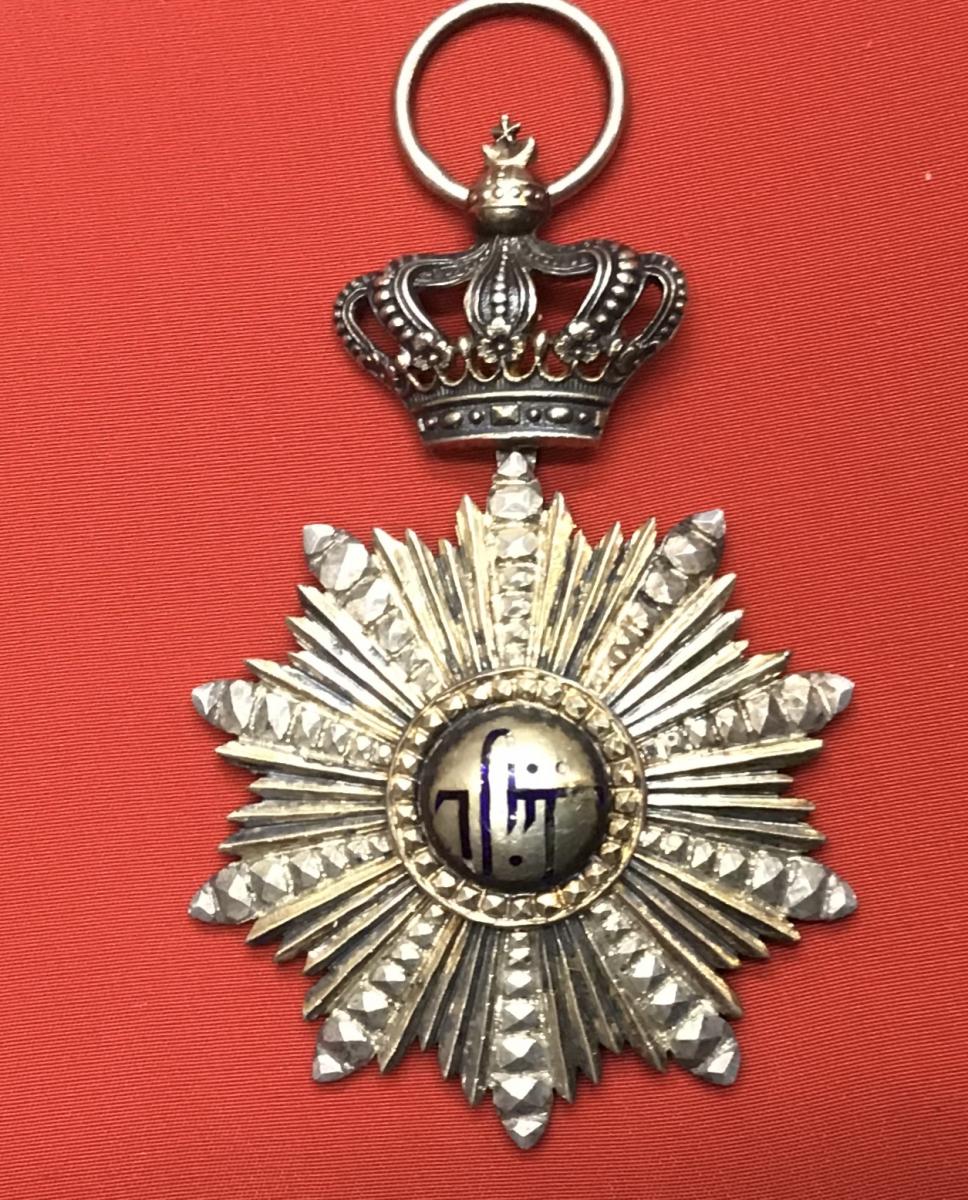
Obverse of the Dixons Medals miniature Egyptian Order of the Nile. The most obvious difference in this miniature is the lack of the 5-armed white enameled star. This piece also appears to be inverted, note that the inscription on the central medallion is upside down. The “squared” and less-curving calligraphy of the inscription is similar to that on a few minis shown on this thread; for example, in the 6th photo of my post of 12 February, 2018 of a cased set of a 4th Class Officer breast badge and miniature (sans ribbon) from the Medal-Medaille auction website. It also may be similar to that on the miniature on the left in the photo of the Order of the Nile minis in my post of 22 July, 2018 from a Spink auction archived on the Saleroom.com website. The calligraphy of the inscription also resembles that on the Order of the Nile mini shown 2nd from left in my post of 23 March, 2020. Several other minis included in this thread with the single central inscription show more curved calligraphic forms than this example. However, the more angular calligraphy is common on inscriptions of many (most?) full-sized Order of the Nile regalia. The anomalies of the crown suspension device (see the paragraph below the 2nd photo below) suggest it has been re-fit with a non-original crown and when that was done the badge was inadvertently inverted.
While most examples of Order of the Nile miniatures have faceting on all or most rays, this example only has faceting on the 10 main rays of the embellishment. Two other examples that also show faceting only on the 10 main rays of the embellishment include the example I illustrated in my post of April 2, 2018 from an auction listing of La Galerie Numismatique archived on the Sixbid.com website; and the one Owain illustrated in a group of 4 Belgian miniatures (upper image, 3rd from left) on 5 March, 2019.
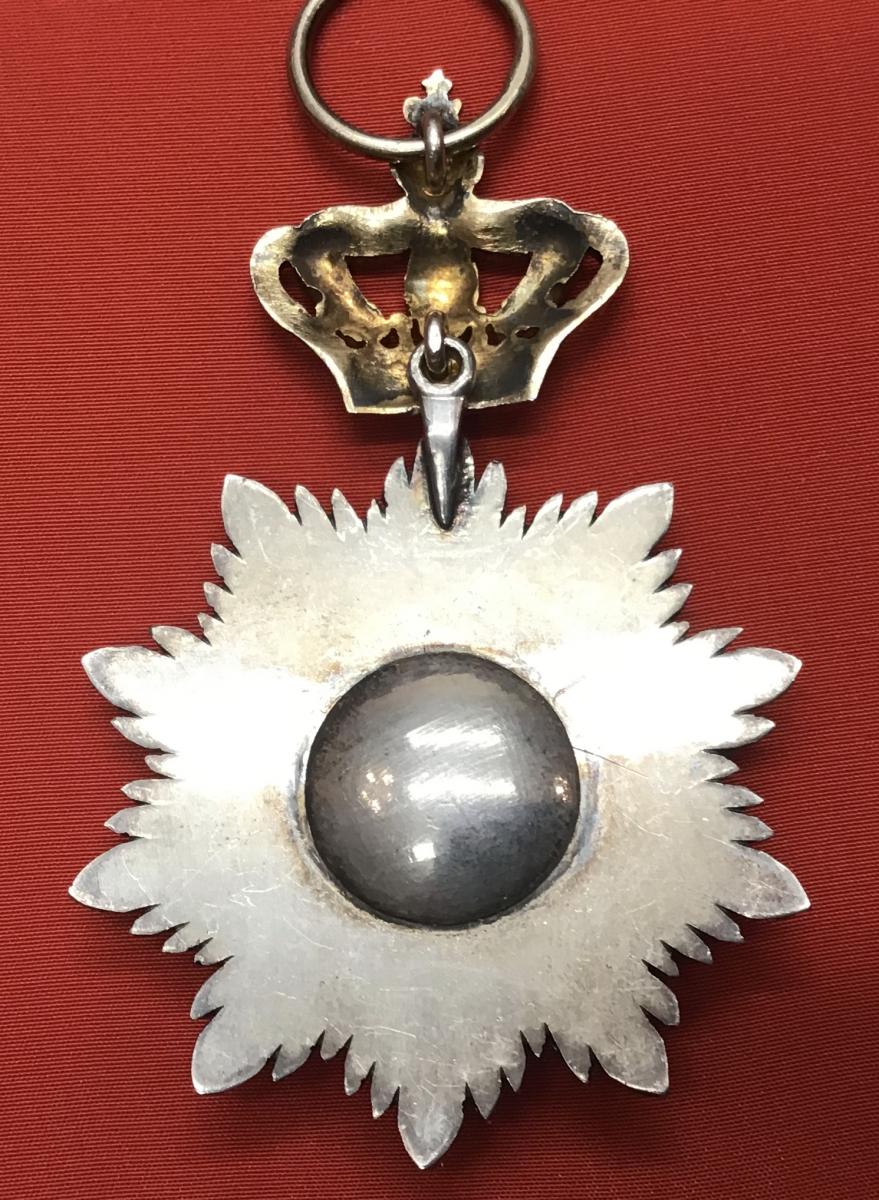
Reverse of the same miniature Order of the Nile showing the oddly hollowed reverse of the crown suspension device and the unusual attachment of the body of the medal to that suspension device. Although the obverse of the crown suspension device appears to mostly adhere to the normal princely crown form (although e leaves are a bit usual as are the lateral margins of the 5 hoops), there are several anomalies in this portion of this mini. The ball at the superior portion of the crown supporting the crescent & star seems oddly large and the band of raised spheres is not an element normally seen on crowns of these (and other) kingdom-era medals. Most obviously on the obverse, the finish & detail of the crown seems incongruous different compared with the workmanship on the body of the medal. All other examples of Order of the Nile miniatures I have seen, and that are illustrated in reverse on this thread, show a solid struck crown suspension device. The above photo showing the hollow reverse of the crown, and the more extensive cut-out openings around the upper "headband" portion of the crown around the leaf designs and between the hoops. While several Order of the Nile minis do have some cut-outs around the crowns' hoops, they are much smaller than seen on this piece. It also notably lacks the normal form of link attachment between the body of the medal and the crown suspension device (also seen on all other minis of this order shown on this thread). The above photo shows the soldered attachment with a ring that attaches to the back of the crown, instead of the normal link. These several anomalies of the crown suggest to me that it is a more recent “repair”, and apparently this was done inexpertly so that the badge is now suspended upside down.
0 -
I have found another variant design in an example of the Mixed Courts badge illustrated in the online catalogue for the British Museum's Department of Coins and Medals.

Above is a high-resolution image of the Egyptian Mixed Court badge in the British Museum's collection of its Department of Coins and Medals (https://www.britishmuseum.org/collection/object/C_2009-4007-754). The Registration number is 2009,4007.754. Its Asset Number, for non-commercial research use, is 748897001. This image (and the 2 cropped photos below) is copyrighted by The Trustees of the British Museum. The above photo of the obverse and reverse can be zoomed for additional details. There is no maker's mark on the reverse and no hallmarks are visible on the reverse or the tunic pin to determine if this is Egyptian or foreign manufacturer.

High-resolution image of the obverse of the British Museum Mixed Court badge (Registration number is 2009,4007.754). The catalog information identifies this as allegedly the workmanship of "Jacques Charles Francois Marie Froment- Meurice", a name that appears to be an odd chimeral creation jumbled from François Froment (Pierre Henri Émile Foment-Meurice's paternal grandfather) and Pierre-Jaques Meurice (François Froment's business partner and later the husband of Émile Froment-Meurice's paternal grandmother following François Froment's death in 1804). The workmanship of this badge is clearly not that of Maison Froment-Meurice of Paris. It also does not match that of Rudolf Stobbe of Alexandria, Wolf Hotovitz of Alexandria, Zivy Frère & Cie of Alexandria, nor of the possible maker (or agent of Leon Kramer of Cario) M. Laurencine & Cie of Alexandria. There is a significant lack of detail readily apparent in the leaves of each of the oak and laurel branches, the crescent and star below the 2 crossed branches underneath the central inscribed tablet, the order of Medjidie and its surrounding wreath, and the tassels and cords at the corners of the mantle. Other lower-detail components of the design are a bit less apparent but can be seen in comparison with other badges illustrated on this thread. There are quality differences in the headband of the crown, the superior crescent on the crown, the border design of the mantle above the fringe, and the star & rays surrounding it above the central tablet. The fur design of the interior of the mantle is even less detailed, and the ermine tails on the inside of the mantle also are less detailed in their execution than on any other badges. Even the least-detailed workmanship apparent in the Zivy Frère & Cie example (that I have previously illustrated in the 1st & 2nd photos in my post of 24 April, 2019 and as the 12th photo in my post of 6 July, 2020 on this thread) is more well-crafted than most of the design elements on this example (except for the missing crescent & star element below the tied oak & laurel branches and the lack of a cipher on the Order of Medjidie symbol on the Zivy Frère badge). The overall flatness of the piece (especially notable in the less 3-dimensional aspect of the folds of the mantle on each side) is quite different than all of the other badges I have seen by other makers. There also are several significant inconsistent aspects of the calligraphy that are unlike any other example of these badges I have seen. There are some differences among a few other examples of these badges that I have noted previously on this thread, but the British Museum example's is the most different (some calligraphic ommissions and additions) from any clearly genuine badge I have researched. I don't necessarily suspect this is not a "genuine" badge, but the workmanship is far less skilled than that of any other badges, except the odd Horowitz pin I illustrated as the 1st photo in my post of 2 December, 2018 and the odd unmarked mock-badge I included as the 4th photo in my post of 14 August, 2019 on this thread.
The British Museum catalogue identifies the dimensions of this piece as 114 mm high x 87 mm in width. The material is silver with some gold (identified on the crown and the "draped arms"-probably meaning the tughs), suggesting this could be a badge of one of the District Court judges. The catalog information includes the acquisition date of 2009, the name of the previous owner (the late Robert Hogarth), and the name of the British dealer/auction house for this piece (Simmons & Simmons).

Cropped close-up view of the central inscription on the tablet of the British Museum example for comparison with the calligraphy from a a Froment-Meurice badge shown in the next photo below.
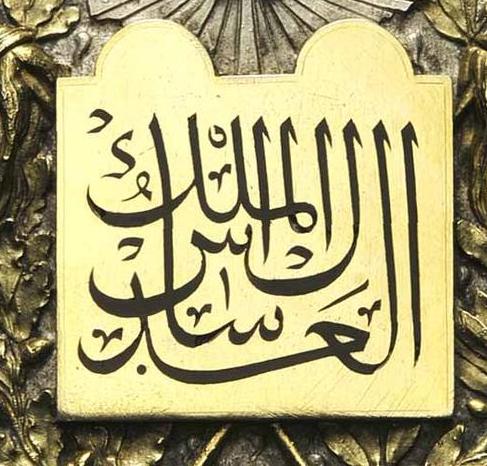
For comparison with the anomalous calligraphy on the above unmarked badge from the British Museum, I am including this cropped image of the inscription on the central tablet from an example made by Froment-Meurice. This is the tablet inscription on the gold & silver District Court badge attributed to the Belgian jurist Joseph Timmermans, from a 2014 auction by Jean Elsen & ses Fils S.A., archived on the acsearch.info website (https://www.acsearch.info/search.html?id=3990624). I previously illustrated this badge as the 1st photo in my first post of 31 October, 2018, as the 5th-to-last photo in my post of 18 April, 2019, and as the 3rd photo in my post of 6 July, 2020.
0 -
I'm sure several folks are aware of this recent theft and the note about a spate of thefts in museums in the Netherlands and other areas.
0 -
I have only found one good photograph of someone wearing the ribbon of the Order of Ismail. Below is a black & white photograph of King Farouk I taken by the well-known Life Magazine photographer Margaret Bourke-White in approximately 1940, and this is the best image I have seen on the internet of the Order of Ismail ribbon. In this photograph, King Farouk wears 2 ribbon bar with a total of 5 ribbons that can readily be identified. There are several other photographs of King Farouk wearing these same 5 ribbons, but this is the only image I have come across that shows the ribbons quite well. There also are many photographs of him wearing many more ribbons, but again those are from a further distance and do not provide any useful detail of the ribbons.

This version of Margaret Bourke-White’s portrait of King Farouk I is the best resolution version I have found on the internet. It comes from Tulip Noire’s flickr site (https://www.flickr.com/photos/8637723@N05/3528022536) and has his watermarks in the lower left, and on the King’s right shoulder board in addition to the “LIFE” watermark on the lower right. Tulip Noire identifies the date of this portrait as July 1940. Several versions of a slightly lower resolution print with a few folds and tears to the images also are common online. I find this a dreadful portrait of the young King, looking even more sleepy-eyed than many of his portraits and his moustaches are quite wispy. I think I can identify all 5 ribbons in the b&w image, using Owain Raw-Rees’s JOMSA articles “King Farouk and his Awards (2006, JOMSA, Vol 57, No. 4, pp: 15-23) and King Farouk’s and his Miniature Medals (pp: 1-8). The top row is (L-R) the Order of Mohammed Ali (green with white inset border stripes), the Order of Ismail (dark blue with inset red border stripes), & the Order of the Nile (pale blue with gold inset border stripes). I think the 2nd row is (L-R): the Order of the Military Star of King Fuad I (central stripe of black bordered by yellow stripes of the same width, bordered by pale blue stripes also of the same width, and narrow yellow margin stripes); and the single colored ribbon is almost certainly the Medal for Meritorious Acts (violet). Although King Farouk I also was awarded the Medal for Devotion to Duty that has a single color ribbon (medium blue), the identification of this as the Medal for Meritorious Acts comes from Owain's research in his 2006 JOMSA article.
Owain Raw-Rees has illustrated specially-made versions of these 5 medals sized for wear by King Farouk I on his undress uniform (see the 1st illustration in the Raw-Rees 2006 article for images of these medals from Abdine Palace, descriptions of the awards, and additional information about the King's awards; and the 2nd photo in the Raw-Rees 2018 OMRS publication cited below) in addition to a a photo of King Farouk I wearing this special grouping (Raw-Rees 2006, 2nd photo, and the same image is the 3rd photo in the Raw-Reese 2018 OMRS publication cited below). Owain published an article on King Farouk’s miniature medals in the OMRS publication Miniature Medals World (Owain Raw-Rees, 2018, Egypt-King Farouk and his Dress Miniatures, Miniature Medals World, No 130. March), added to the Abdine Palace display at a later date, showing the same grouping. Owain also has generously allowed me to post those photos here below as the 14th-16th photos of this post. Owain includes 2 photographs of King Farouk I wearing that miniature set of 5 medals in the 2018 OMRS publication (5th photo) while seated next to his cousin Price Abbas Halim (c. 1939) and a portrait with Queen Farida at his 22nd birthday celebration on 11 February, 1944 (6th photo). Owain also includes images of another set of 6 miniatures in the Abdine Palace display that includes the addition of 1948 Palestine War medal (7th photo in his 2018 OMRS publication) and another interesting image of King Farouk I (with goatee) in exile wearing white tie and tails and a chain of unidentified miniatures in addition to a sash and 3 breast stars (8th photo of the 2018 OMRS publication). I have found a few complementary photos of King Farouk wearing his miniatures (the 2nd-7th photos below) and the chain of miniatures (the 8th-13th photos below) that I am including below for comparison with those that Owain already had published in the 2 cited articles.
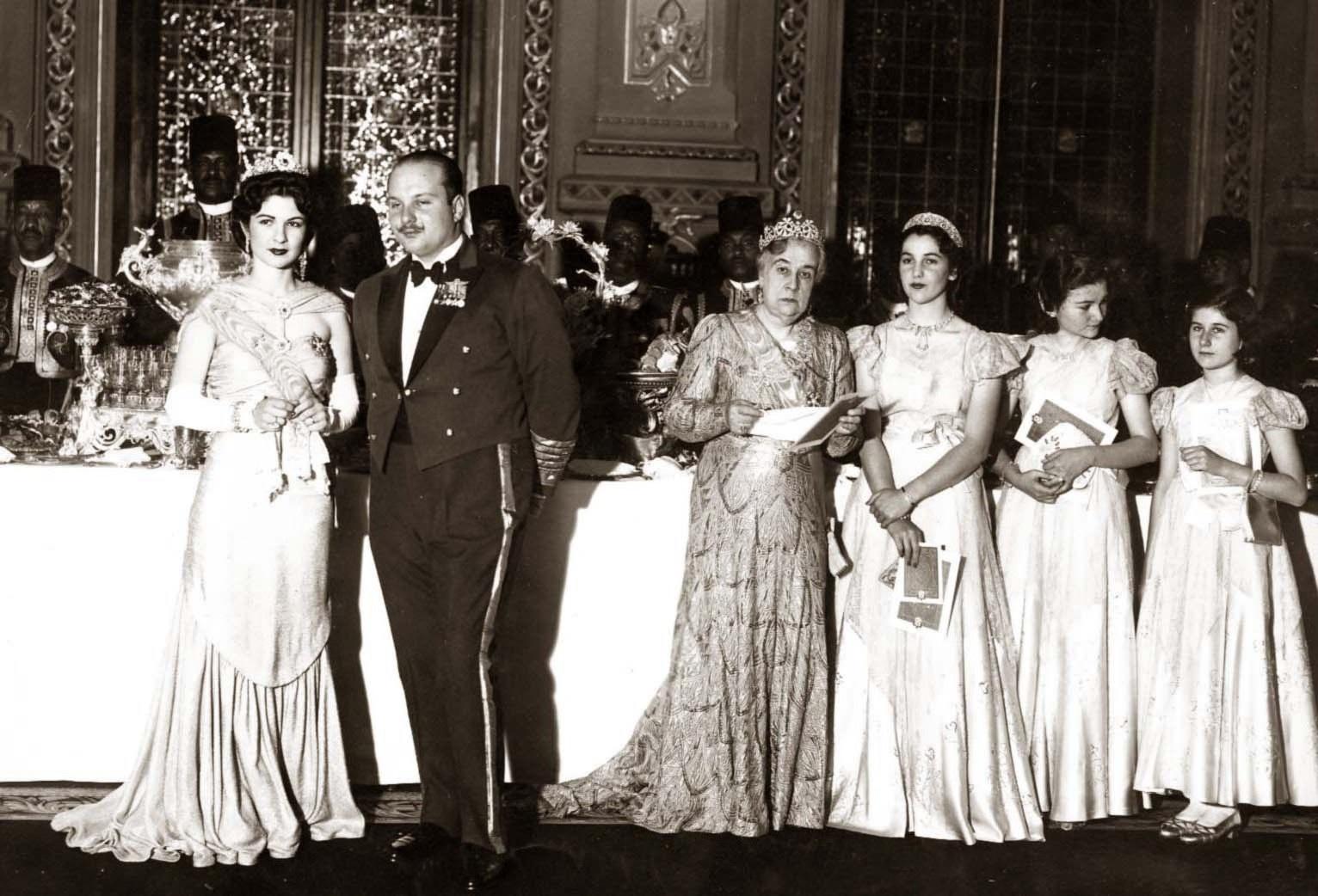
Owain's image of King Farouk I wearing his miniature medals while standing next to Queen Farida at his 22nd birthday celebration on 11 February, 1944 (6th photo in his 2018 article on the King's miniatures) is a cropped version that comes from the above group portrait in Abdine Palace. This version of that portrait comes from Wikimedia and is the best version of this image I have found online (https://commons.wikimedia.org/wiki/File:ModernEgypt,_Farouk_%26_Farida_Marriage,_DHP13655-20-2_01.jpg). This photo can be zoomed, but it does not show the medals in any detail. The Wikimedia commons description of this photo identifies this as from the King's 22nd birthday celebration in Abdine Palace and the photo was published on 11 May in 830th issue of the weekly magazine Rose al-Yūsuf. The people depicted in the photograph are (from left to right): Queen Farida, Farouk's wife; King Farouk I; Princess Nimet Mouhtar, Farouk's paternal aunt; Princess Faiza, Farouk's sister; Princess Faika, Farouk's sister; and Princess Fathia, Farouk's sister.

The best cropped version of the above photo with slightly better resolution of King Farouk I’s miniature medals than shown in the 6th photo of Owain's 2018 article on the King's miniature medals. This is a cropped version derived from the same image above that is on askamel’s flickr photostream (https://www.flickr.com/photos/askamel/1417345069/). This photo can be zoomed for only a bit more detail. Above the medal bar of miniatures is an Egyptian Royal Air Force insignia (seen in better detail in the portrait of the King shown in the last illustration of this post).
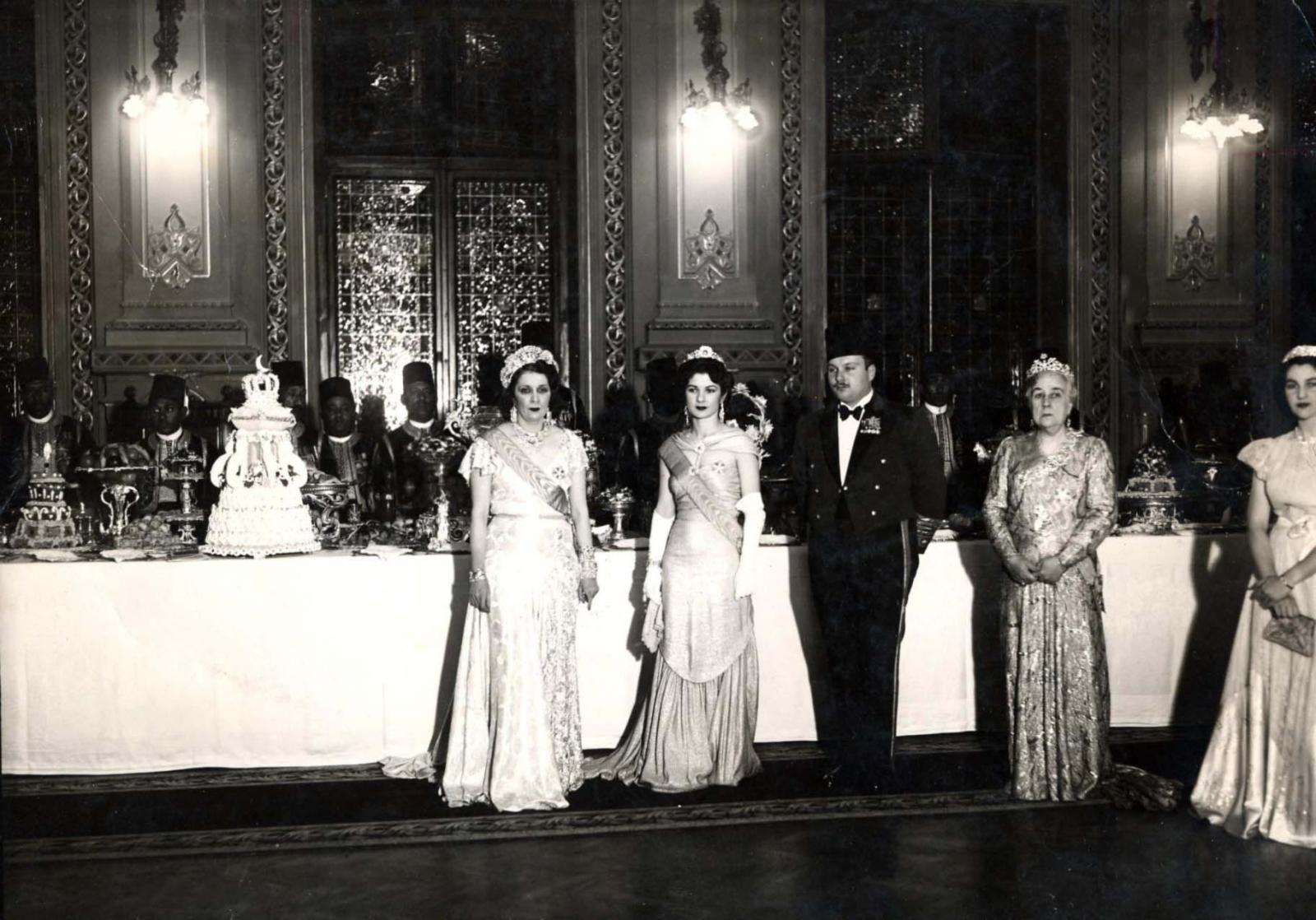
Another group portrait from the same 22nd birthday event also showing King Farouk I wearing his miniature medals. This photo can be zoomed for a bit more detail, but again it does not show the medals with any clarity. From Wikipedia Commons (https://commons.wikimedia.org/wiki/File:ModernEgypt,_Farouk_%26_Farida_Marriage,_DHP13655-20-2_01.jpg) that incorrectly identifies the event as the wedding of King Farouk I and Queen Farida. From left-right: Queen Nazli; Queen Farida; King Farouk I; Princess Nimet-Alah (Mouthar), and Princess Faiza.

Low-resolution image of King Farouk I with Reza Pahlavi (far right), the then Crown Prince (later Shah) of Iran (probably in 1939) showing King Farouk I wearing the same set of 5 miniatures identified by Owain, from the flickr photostram of Zainab Mohamed (https://www.flickr.com/photos/96884693@N00/810559476/in/set-72157610800968278/).
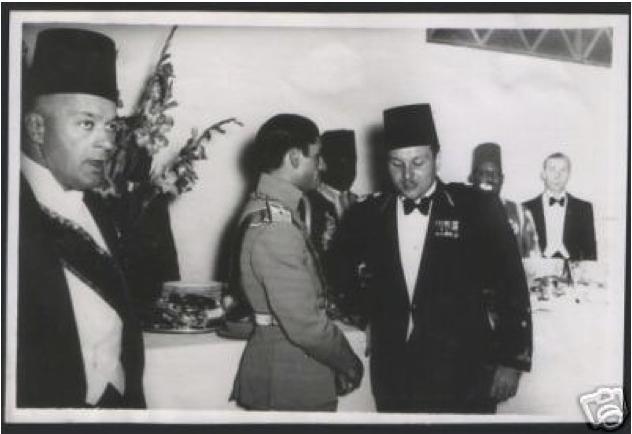
Another photo of King Farouk I wearing these same 5 minis with Shahpour Mohammad Reza Pahlavi during other events celebrating the Royal Wedding celebration of Reza Pahlavi's wedding to Farouk I's sister, Princess Fawzia in 1939. From the Fickr photostram of askamel (https://www.flickr.com/photos/askamel/1909849303).
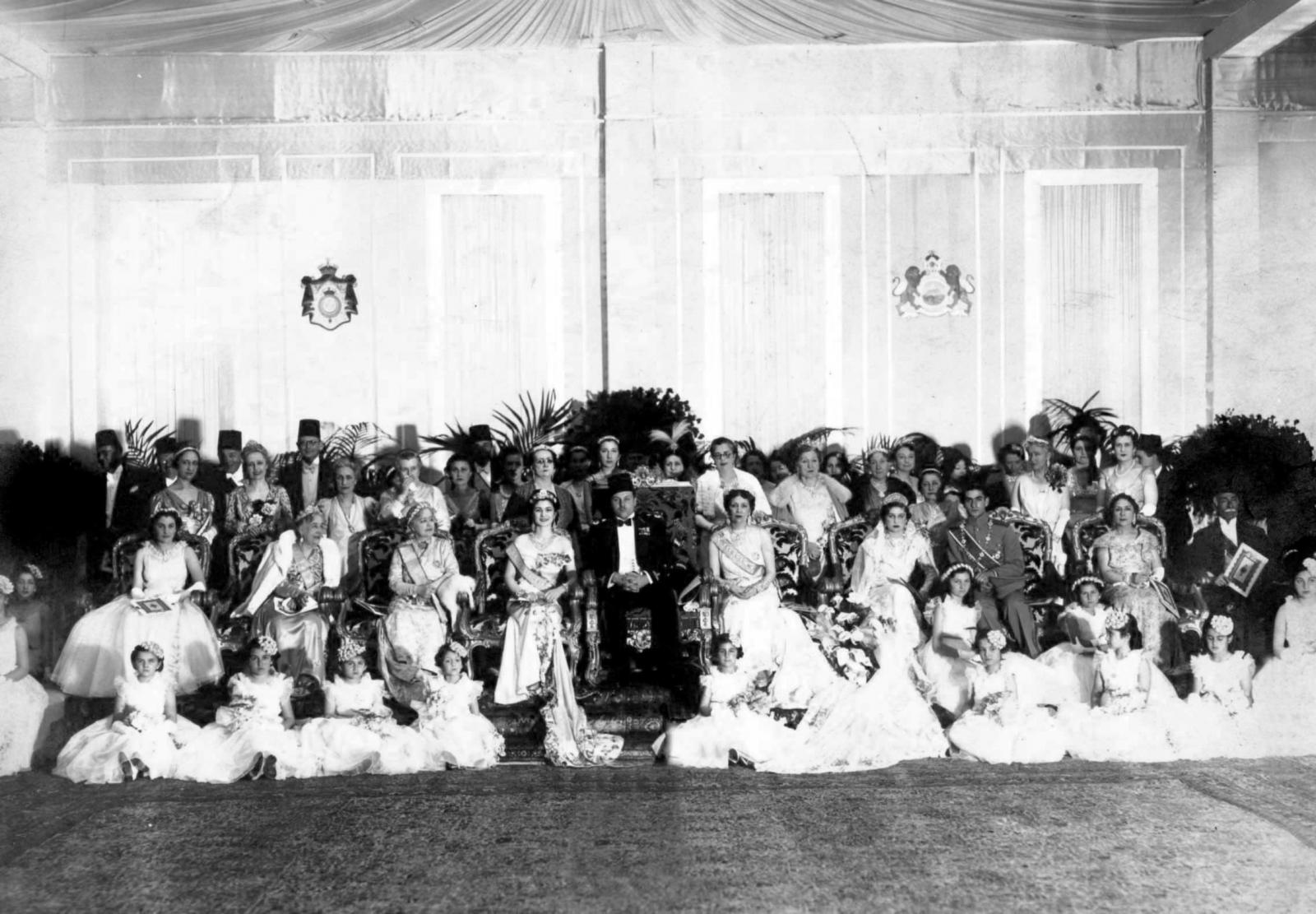
Another group portrait taken during the celebrations of Princess Fawzia's wedding to Reza Pahlavi in 1939 showing King Farouk I wearing this same set of 5 miniatures that Owain has identified. This is the best version I have found of this portrait online, from Wikimedia (https://commons.wikimedia.org/wiki/File:ModernEgypt,_Wedding_of_Mohammad_Reza_Pahlavi_%26_Fawzia,_DHP13655-20-5_01.jpg). The Wikimedia caption for this images states that: "The Bibliotheca Alexandrina's caption erronesouly states that this is a commemorative photograph of the wedding of King Farouk I and Queen Farida of Egypt. In fact, it is a commemorative photograph of the wedding of Farouk's sister Princess Fawzia and Mohammad Reza Pahlavi, the then crown prince (later shah) of Iran. The persons sitting in the front row who can be identified with certainty are (from left to right": Sultana Malek (1869-1956), widow of Hussein Kamel, the bride's paternal uncle; Queen Farida (1921-1988), wife of King Farouk I; King Farouk I (1920-1965); the bride's brother wearing black tie and a tarboosh; Queen Nazli (1894-1978), the bride's mother; Princess Fawzia (1921-2013), the bride wearing a wedding dress; Crown Price Mohammad Reza Pahlavi of Iran (1919-1980), the groom, in military uniform with a chain over his chest. Queen Tadj ol-Molouk (1896-1982, the groom's mother. In the upper side of the photograph can be seen the coat of arms of the Kingdom of Egypt (left) and the coat of arms of Pahlavi Iran (right). The wedding is considered an important event in the history of Egyptian-Iranian relations, as well as a milestone in Shi'a-Sunni relations: King Farouk I was the ruler of the Muslim world's most powerful Sunni country, Mohammad Reza Pahlavi was crown prince of the world's largest Shi'a country, and the wedding ceremony was performed by Mustafa al-Maraghi, rector of Al-Azhar, the world's foremost Sunni religious institution." Wikimedia gives the source of this photo as: the Biblioteca Alexandrina's Memory of Modern Egypt Digital Archive. The photo was probably taken by the Riad Shihata Studio in Cairo.
I also have seen a few other photographs online of King Farouk I wearing a chain of miniatures, but as with Owain’s published image (8th photo in his 2018 OMRS publication), none are high enough resolution to identify the miniature medals on his chain. All of the photos I have encountered of Farouk wearing a chain of miniatures are from the period of exile, so it appears the miniature medals on such a chain are likely (mostly?) his foreign awards.
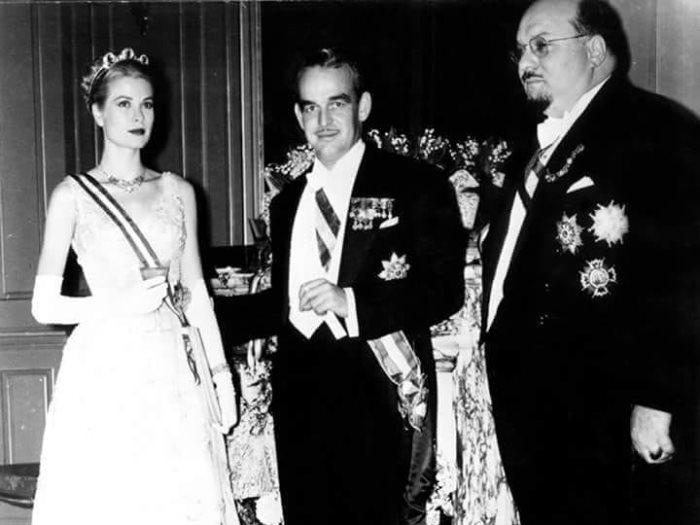
A photograph of goateed ex-King Farouk I with Grace Kelly and Prince Ranier of Monaco that of miniature medals, with the same sash and 3 breast stars as in Owain's 8th photo in his 2018 OMRS publication, suggesting they may both be from the same event in Monaco. Farouk I wears the sash and breast star of the Order of St. Charles (Monaco) in the premier position, followed by the Legion d'Honneur (France), and the Order of Isabella the Catholic (Spain). This is the best online version of this portrait that I have found online (from: https://www.3ain.net/Article/76095/شاهد-من-هى-جريس-كيلى-راعية-ابن-الملك-فاروق-الأول). This same photo (Image ID:A2JM84) is offered for sale on the alamy webisite (https://www.alamy.com/grace-kelly-with-husband-prince-ranier-of-monaco-and-ex-king-farouk-image3439747.html). A lower-resolution version of this image on tumblr (https://graceandfamily.tumblr.com/post/143803793407/vintage-photo-of-rainier-iii-grace-kelly-and-king) identifies the event as the civil wedding of Grace Kelly and Prince Rainer III in 1956. A film made during the wedding events in Monaco shows Prince Ranier and Grace Kelly in these same costumes at the opera following their private civil marriage ceremony and prior to their cathedral wedding (https://www.youtube.com/watch?v=YiOKFzRHm14).
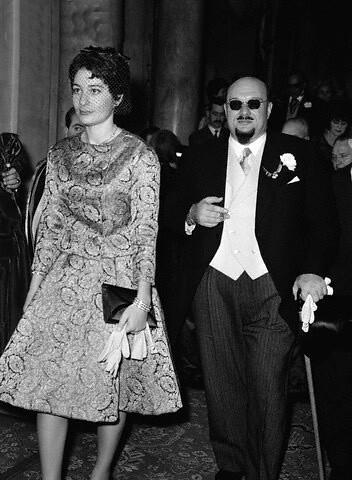
Another image of King Faoruk I in exile wearing the chain of miniature medals, This image comes from From Magda Malek’s flickr photostream: https://www.flickr.com/photos/magdamalek/2898379473/ . The event is identified as a January 1962 visit to Switzerland, where King Farouk I and his daughter Princess Fawzia were attending the wedding of King Simeon II of Bulgaria and Margarita Gomez-Acebo.

Another photograph that may show a chain of miniatures featuring King Farouk I with his daughter Princess Ferial at Cannes in 1957 with 2 breast stars visible, but only that of the Grand Cross of the Legion d'Honneur (France) can be readily identified. From a 28 January, 2014 article by Paul Crompton, "Egypt’s King Farouk: philanderer or family man?” in the English language version of (https://english.alarabiya.net/en/perspective/features/2014/01/28/Egypt-s-King-Farouk-philanderer-or-family-man-), photo courtesy of Amr Talaat.
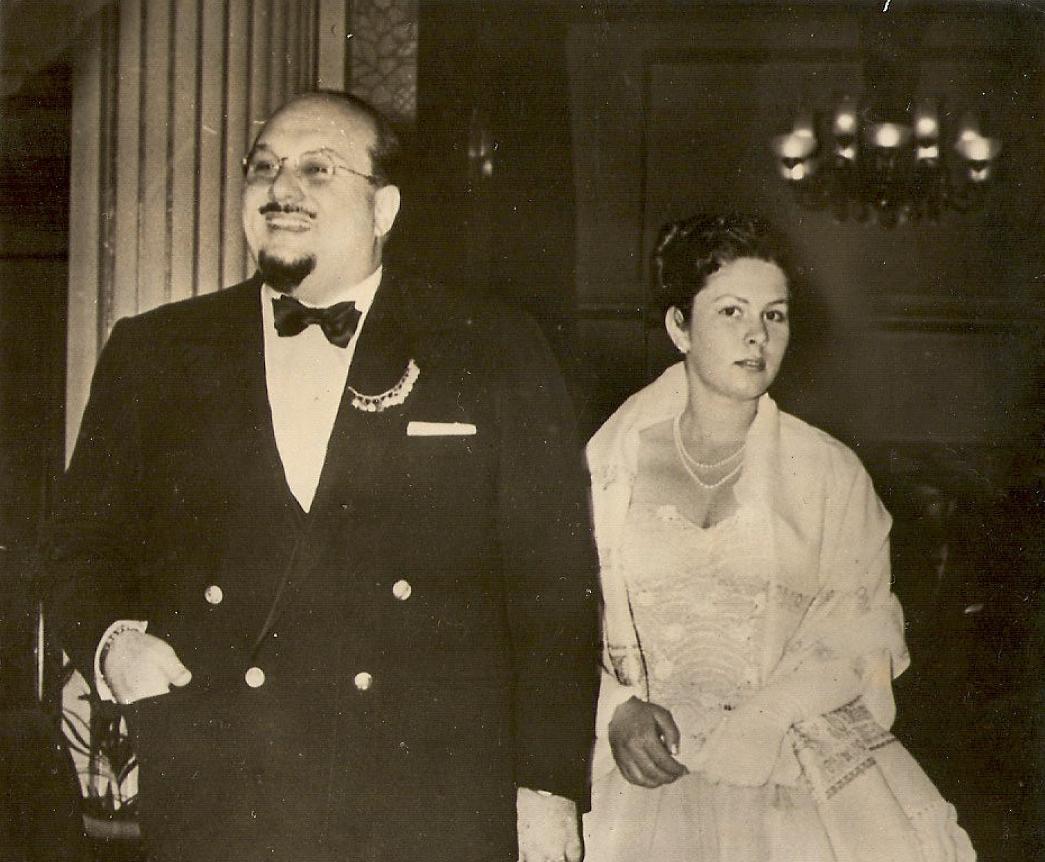
Another photograph of King Farouk I wearing the chain of minis with his daughter Princess Ferial during his exile. (From Hassan Kamel-Kelisi-Morali's flickr site: https://www.flickr.com/photos/kelisli/4844899791/)

A photograph of King Farouk with former opera singer, and his former lover, Irma Capece Minutely that also appears to show Farouk wearing a chain of miniatures on his coat, only partly visible because of his cape, This image is for sale on the IMS Vintage Photos website (SKU: SCAN-NOP-0000102367). The clothing and floor in the image show this to be from the same event as shown in the next image below that is associated with some contextual information. (From: https://imsvintagephotos.com/kingfaroukofegyptrightandirmacapeceminutololeft102367)
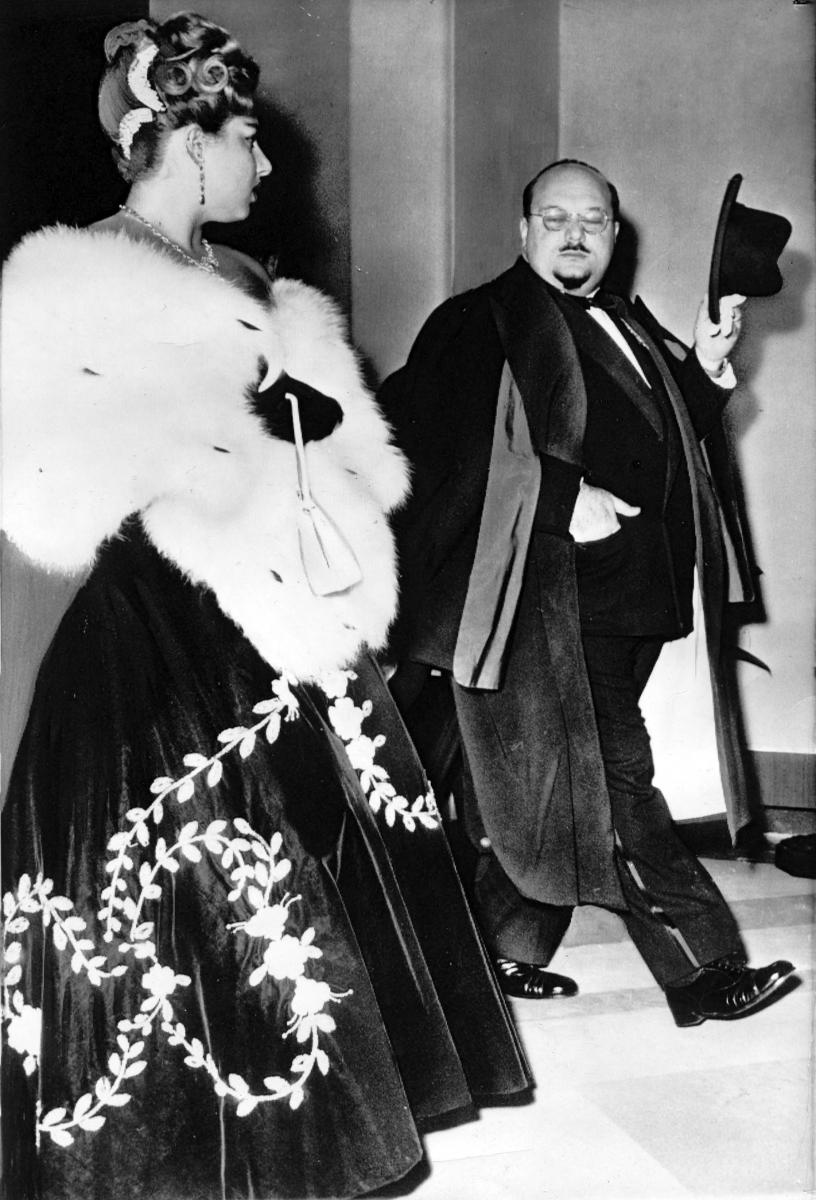
Another image of the Farouk next to Irma Capece Minutolo on the Photorientalist webiste (http://www.photorientalist.org/easymedia/exiled-king-farouk-and-narriman/farouk-in-no-moot-for-small-talk/)) in the same outfits barely shows what may be a chain of miniatures. The caption identifies the context as King Farouk I passing his ex-geilfriend with no comment at an unspecified event in October, 1956.
The following 3 photos are courtesy of Owain Raw-Rees and are from his published articles on previously unattributed medals on display in Abdine Palace that he has inentified as those of King Farouk I.

Owain's illustration of the specially-sized set of 5 medals (1st photo in Owain Raw-Rees, 2006, “King Farouk and his Awards", JOMSA, Vol 57, No. 4, pp: 15-23; also shown as the 2nd photo in: Owain Raw-Rees, 2018, "Egypt-King Farouk and his Dress Miniatures", Miniature Medals World, No 130. March). This photo is courtesy of Owain Raw-Rees and is copyrighted by him. Owain has included a photo of King Farouk 1 wearing this bar while standing next to his uncle Prince Mohammed Ali Tewfiq as the 2nd photo of his 2006 JOMSA article and as the 3rd photo in his 2018 OMRS publication. These are the 5 awards represented by their bars in the Life shown as the 1st photo above in this post. These medals include, from left-right: the Order of Mohammed Ali, the Order of Ismail, the Order of the Nile, the Order of the Military Star of King Fuad I, and the Medal for Meritorious Acts. Owain notes in his 2006 JOMSA article that King Farouk I had Bichay made these slightly smaller medals (not miniatures) of the Order of Mohammed Ali, the Order of Ismail, and the Order of the Nile that were scaled down to the size of the the Order of the Military Star of King Fuad I, and the Medal for Meritorious Acts was enlarged to wear as an aesthetically homogeneous single row on his undress uniform.
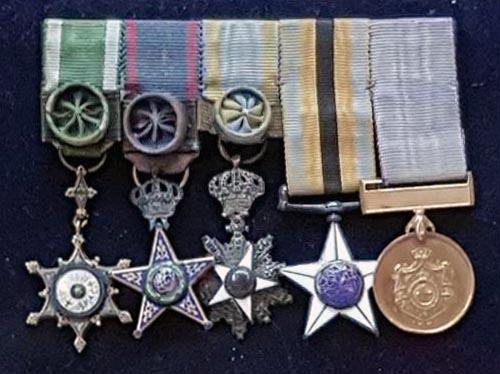
Owain's illustration of the 5 miniature medals of King Farouk I (1st photo in Owain Raw-Rees, 2018, "Egypt-King Farouk and his Dress Miniatures", Miniature Medals World, No 130. March). This photo is courtesy of Owain Raw-Rees and copyrighted by him. The miniatures include, from left-right: the Order of Mohammed Ali, the Order of Ismail, the Order of the Nile, the Order of the Military Star of King Fuad I, and the Medal for Meritorious Acts. This is the grouping that King Farouk I is shown wearing in the above photos of his 22nd birthday and during events celebrating the wedding of Princess Fawzia's to Reza Pahlavi in 1939.
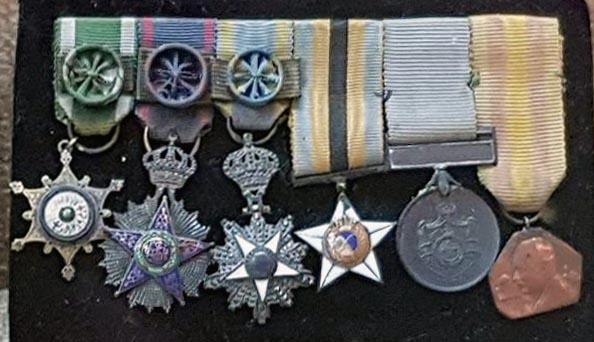
Another set of miniatures of the same 5 awards with the addition of the 1948 Palestine War Media at the far right. This image is the 7th photo in: Owain Raw-Rees, 2018, "Egypt-King Farouk and his Dress Miniatures", Miniature Medals World, No 130. March. This photo is courtesy of Owain Raw-Rees and copyrighted by him.
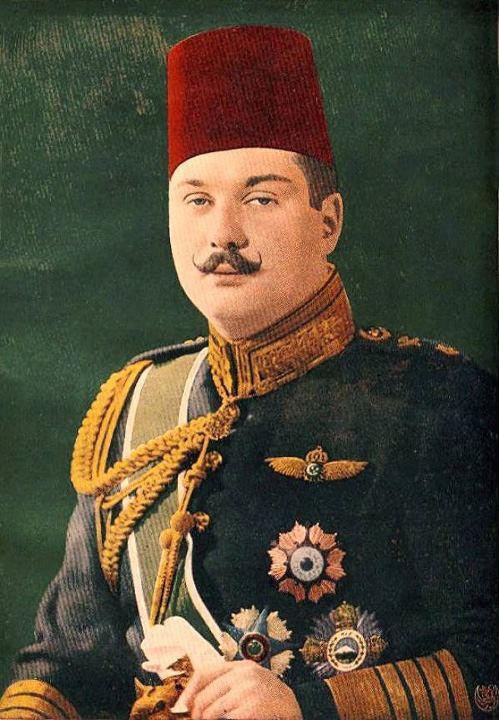
A less common portrait of King Farouk I from 1944 wearing the Egyptian Royal Air Force wings above 3 breasts stars; the Order of Mohamed Ali, the Order of Ismail, and the Iranian Order of Pahlavi (From: https://www.facebook.com/331743570826079/photos/a.331746860825750/331746870825749/?type=1&theater).
0 -
Glad to offer a something, sorry it doesn't help identify the awards. By the way, I Iove Cody! I often wonder of Bob Edgar's Trail Town is still an ongoing Roadside Attraction there? Gotta love the Hole in the Wall Gang;'s cabin, Curley's cabin, the graves of Jeremiah "liver-eaten" Johnson, Jim Bridger, the "Boss Hunter", and those couple of scabs who shot each other dead in a love triangle, and several years later Bob was able to get the remains of the woman they killed each other over. Plus all the Buffalo Bill memorabilia at the Irma (Queen Victoria's gift bar to Cody with the effete European woods bison and Annie Oakley's tin shot silhouette of Buffalo Bill).
0 -
I'm afraid the French inscription on the reverse of this photo is not of any assistance in identifying his awards. My French is not good, but I think it reads: "To Mr. S. Mashuko [or Mashiko?-neither of these seem correct-Matsuoka? Matsukawa???], in memory of affection and friendship of a devoted friend R [?]i[?]ata [Hinata? again, this seems unlikely-Inata?] Tokyo 2/10 1912"
0 -
I obtained the Tewfik Bichai advertising flyer shown in my post of 21 August, 2020 and am illustrating the other pages in that advertisement in high-resolution scans below. These can all be zoomed, although that does not necessarily provide much additional detail of this flyer. This flyer may closely postdate when Tewfiq Bichay took over the Lattes workshop in the 1930s, as noted by Owain in his post on this thread of 19 August, 2020.
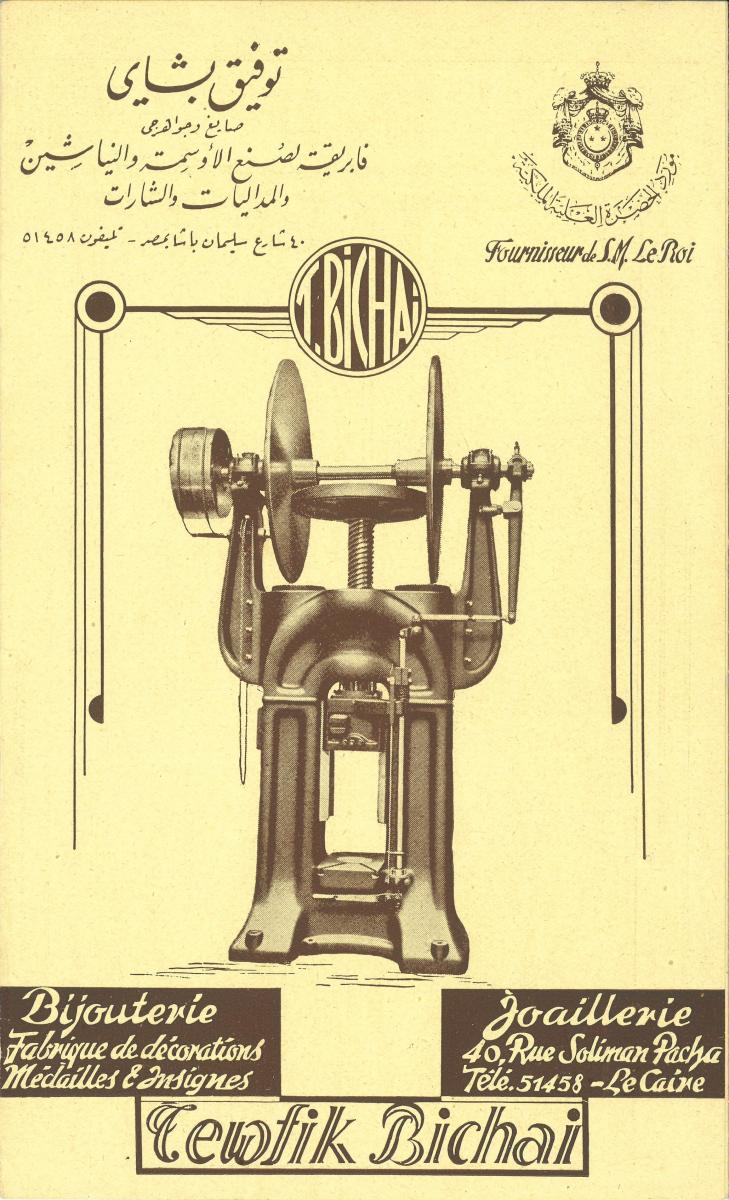
Page 1 of the Tewfik Bichai post 1936 and pre-1952 advertising flyer showing a percussion press. The flyer opens with the attached pages 2 – 5, and page 6 is the back cover of the flyer. The advertisement measures 25 cm tall x 13 cm wide when folded, and 25 cm tall x 392 mm wide when opened. No printer is identified in the French information on the flyer.
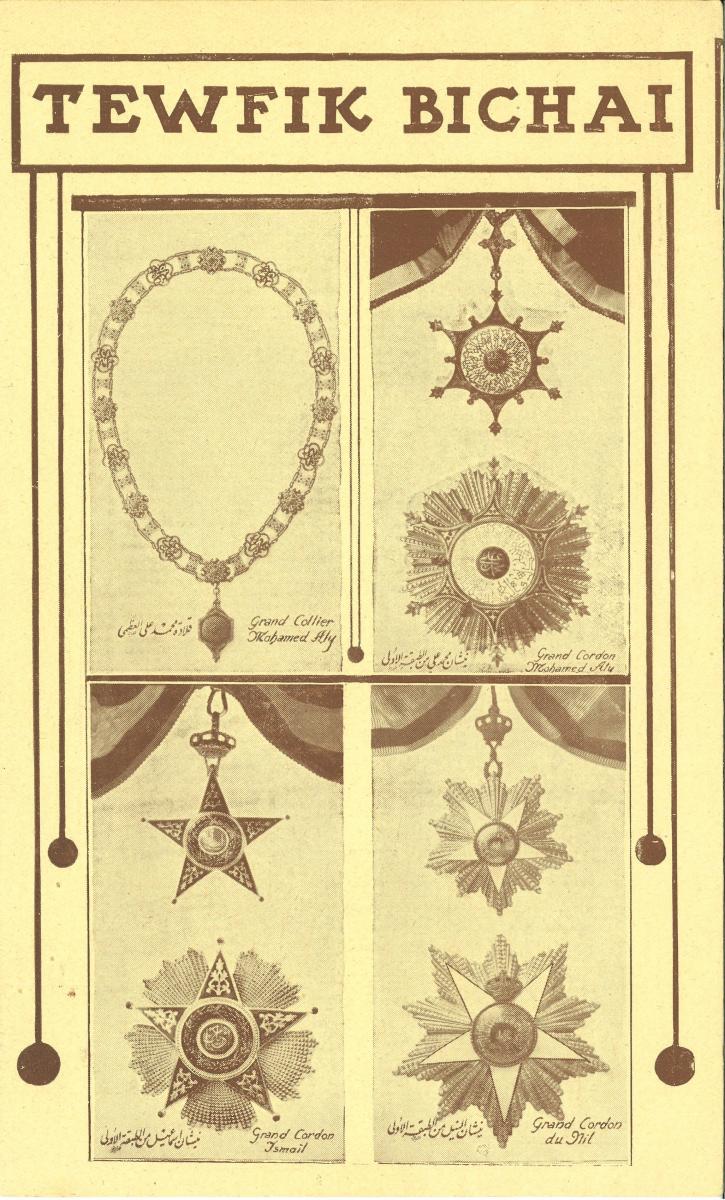
Page 2 of the same Tewfik Bichai advertising flyer showing the 4 most prestigious awards of the post-1915 period of the Egyptian Sultanate/Kingdom. Clockwise from the upper left, the Grand Cordon with Collar of the Order of Mohamed Ali (Nishan al-Muhammad’Ali, instituted 1915); the 1st Class Grand Cordon of the Order of Mohamed Ali sash badge (above) and breast star (below) (Type 2, modified in 1919); the 1st Class Grand Cordon sash badge (above) and breast star (below) of the Order of Ismail (Nishan al-Ismail, instituted 1922); and the 1st Class Grand Cordon sash badge (above) and breast star (below) of the Order of the Nile (Nishan al-Nil, instituted 1915).
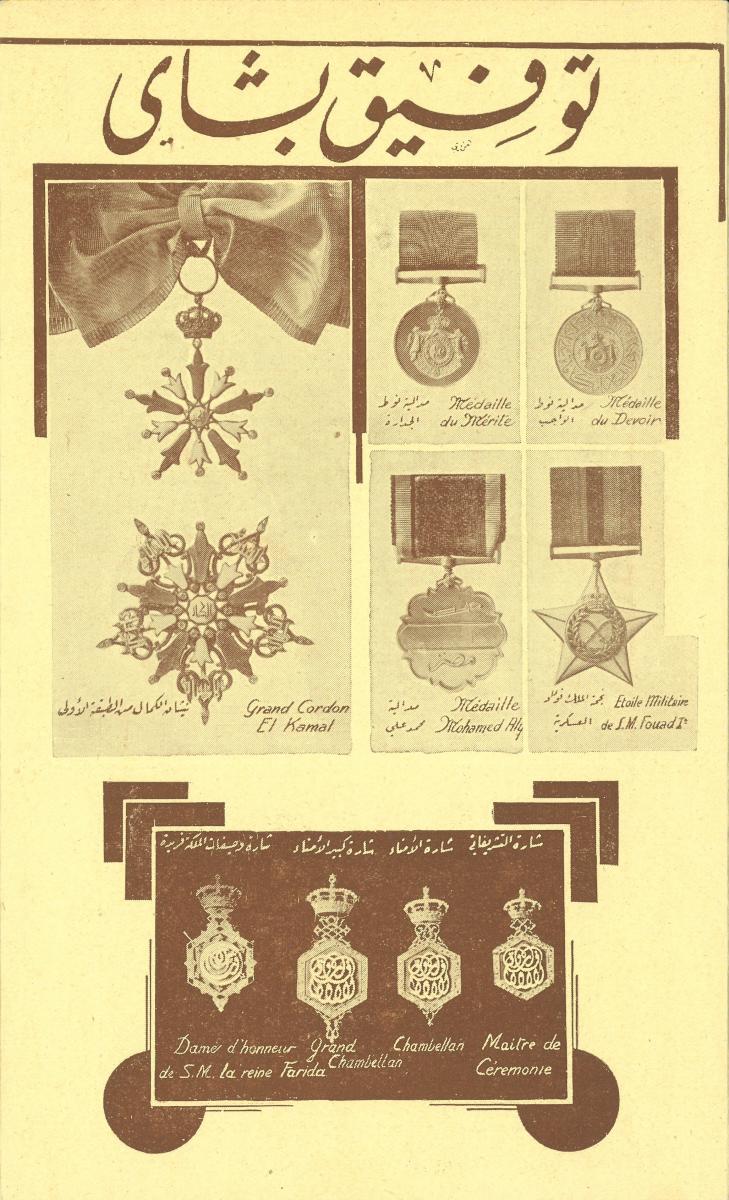
Page 3 of the same Tewfik Bichai advertising flyer showing in the upper left panel: the 1st Class Grand Cordon sash badge (above) and breast star (below) of the Order of Virtues (Nishan al-Kamal, instituted 1915); in the upper right panel, on the left: the obverse of the Medal for Meritorious Acts (what is the Arabic name of this medal?, instituted 1917); on the right: the obverse of the Medal for Devotion to Duty (Nu’ut al-Wa’agib, instituted 1920); in the lower portion of that same panel, on the left: the reverse of the Medal of Mohammed Ali (Nu’ut al-Muhammad’Ali, in either gold or silver, instituted 1915); and in the lower right of that panel: the Order of the Military Star of King Fuad I (Wisam Nigam al-Askariyal al Kawab al-Fu’al-Awwal, instituted 1919); on the bottom panel are 4 pins or badges that are regalia of positions serving the royal family, from left to right: the "Maid of Honor" of H.M. Queen Farida; the King’s Grand Chamberlain’s lapel pin; the lapel pin for the King’s other Chamberlains; and the King’s Master of Ceremonies lapel pin. All of the ciphers on the 3 rightmost pins are of King Farouk I. This flyer illustration usefully provides a small amount of information about some of the design variations of the Chamberlain’s pins, something Owain notes in his 26 March 2019 post is a bit problematic even in the displays of the Royal Jewelry Museum in Alexandria and the Abdine Place displays of such pins. I illustrated 2 Chamberlain’s pins as the 2nd and 3rd photos in my post of 26 March, 2019 on this thread. The second illustration of that post shows an example of the King’s Master of Ceremonies lapel pin that is identical to the one shown in this advertisement flyer. The 1st pin in my 26 March post shows a lapel pin with enamel rather than openwork as seen in the Tewfik Bichai flyer, so I am unsure if this suggests the pin is that of the Grand Chamberlain or the other Chamberlains (some internet sites using that image suggest it may be a version of the Grand Chamberlain's lapel pin). I also illustrated several Chamberlains wearing these pins (on the right lapel) in the 1st, 2nd, and 6th photos in my post of 2 April, 2019. That post also identifies the King’s Chamberlains (supposedly from the 1920s) consisting of the Grand Chamberlain, the Premier Chamberlain, and 4 Masters of Ceremonies. Owain illustrated several Chamberlains’ pins in the 3 photos in his posts of 26 March, 2019 on this thread. The 1st photo in that post is the same image of the enamel, gold (?), and jeweled pin as in my 1st photo of 26 March, and an identical design is shown as the pin on the right of his 2nd photo in Owain's 26 March post. The 3rd photo in Owain’s 26 March post also shows the openwork Master of Ceremonies lapel pin on the left, identical to that in the Tewfik Bichai flyer and the 2nd photo of my 26 March post. Owain also included 7 photos showing a grouping of pins on exhibit in Abdine Palace in his post of 29 March, 2019, also on this thread. That 29 March post shows 2 examples of Queen Farida’s “Maids of Honor” pins as the upper 2 pins in the 3rd photo of that post, that appear identical to that illustrated on this page of the Tewfik Bichai flyer.
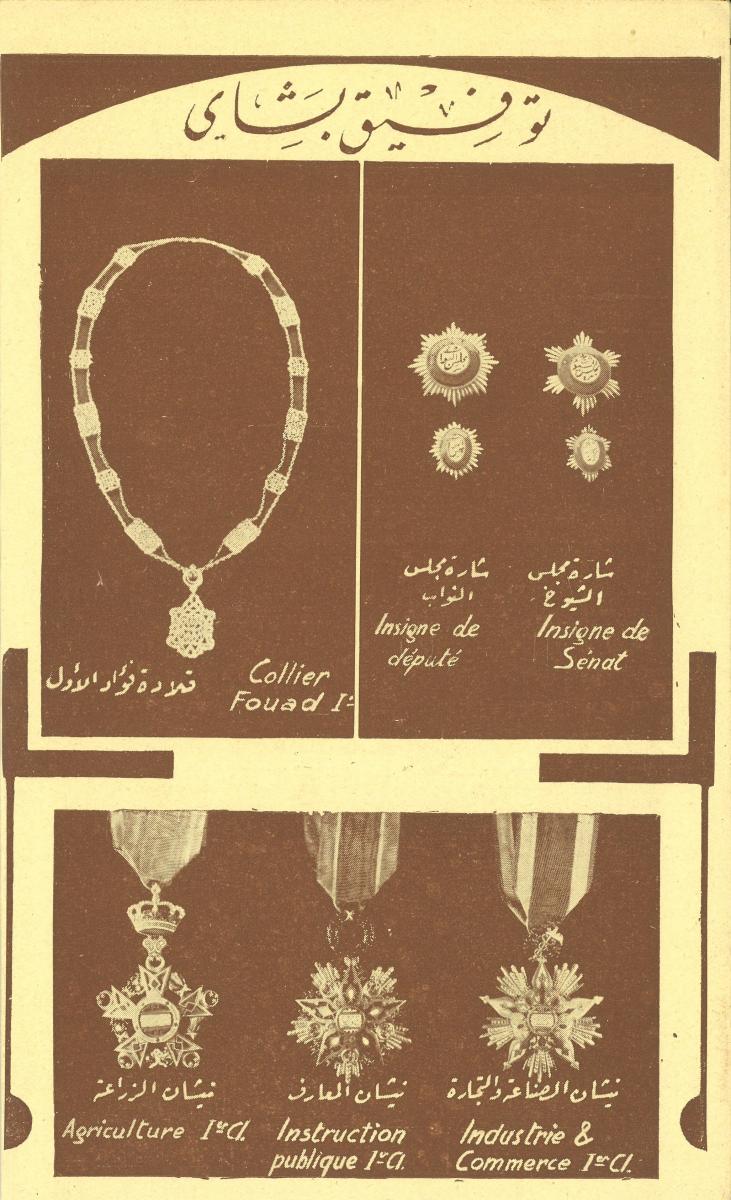
Page 4 of the same Tewfik Bichai advertising flyer showing in the upper left panel: the Collar of King Fuad I (Qiladat al-Fu’ad al-Awwal, instituted 1936); in the upper right panel: the sash badge (upper) and lapel badge (lower) of the Chamber of Deputies (the Lower House of the Egyptian Parliament) is on the left; and on the right are the sash badge (upper) and lapel badge (lower) of the Chamber of Senators (the Upper House of Parliament). See the posts in the GMIC thread “Unknown Arabic Medal ??” started by Linasl on 23 July, 2020 in the "Middle East & Arab States" section for discussions and additional images of these Egyptian Parliamentary insignia. The bottom panel illustrates (from left to right) the obverse of the 1st Class (Commander) Order of Agriculture (Nishan al-Zira’ah, instituted 1932); the obverse of the 1st Class (Commander) Order of Culture (Nishan al-Ma’aref, instituted 1932, also called the Order of Education); and the obverse of the 1st Class (Commander) Order of Trade & Industry (Nishan al-Sinaa wa al-Tigara, instituted 1932).

Page 5 of the same Tewfik Bichai advertising flyer that appears to illustrate 9 sport medals from unspecified competitions in the upper panel (clockwise from top center, 12:00 position): for shotput, discus, tennis, boxing, weightlifting, wrestling, probably handball (?), javelin; and in the center: hurdles. The lower panel shows 24 unspecified badges or pins that appear to include military insignia, royal regalia, and other emblems, possibly of civic organizations. I mentioned some pins that Fahmy Tewfiq Bichay manufactured for other countries during WW II in my post of 21 August, 2020, as well as later UN badges. I also have seen some automobile badges and decorative radiator caps made by Tewfiq Bichay (father) for the Touring Club d'Egypte and the Royal Automobile Club d'Egypte. However, I have not investigated the pins/badges shown in low detail in the lower panel of this page of the flyer.
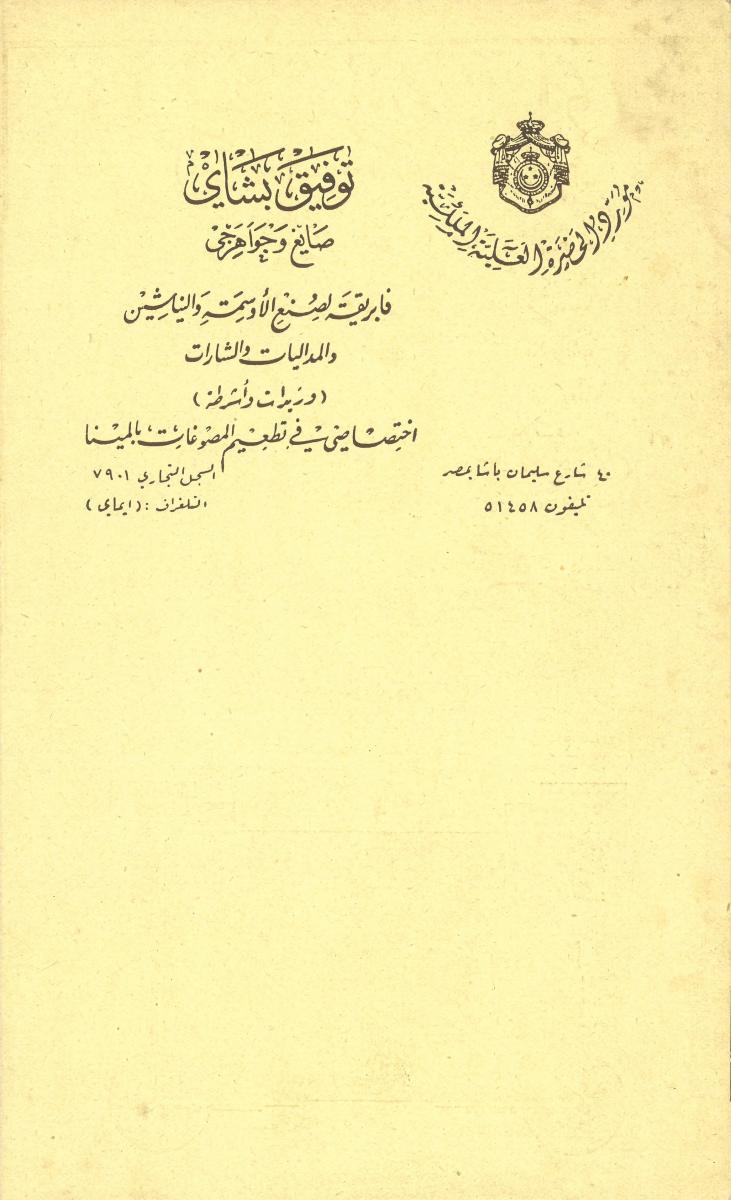
Page 6, the back cover of the same folding Tewfik Bichai advertising flyer. The upper right corner repeats the emblem identifying Bichai as the purveyor to H.M. the King that helps bracket the date for this flyer as after the Sultanate of King Fuad I was changed to Kingship in 1922 and prior to the forced abdication of King Farouk I in the 1952 revolution (as noted in my post of August 21, 2020, rue Soliman Pasha was renamed Talaat Harb probably in 1954). The most recently instituted regalia illustrated in this flyer is from 1936 (the Collar of King Fuad I). Owain states in his 19 August, 2020 post on this thread from notes of an interview with Fahmy Tewfiq Bichay that his father, Tewfiq Bichay, took over the Lattes workshop sometime in the 1930s. These bracketing dates also are consistent with the illustration of ciphers for King Farouk I on all of the Chamberlains’ lapel pins shown on page 3 of the advertising flyer, dating from after Farouk I’s assumption of the throne in 1936.
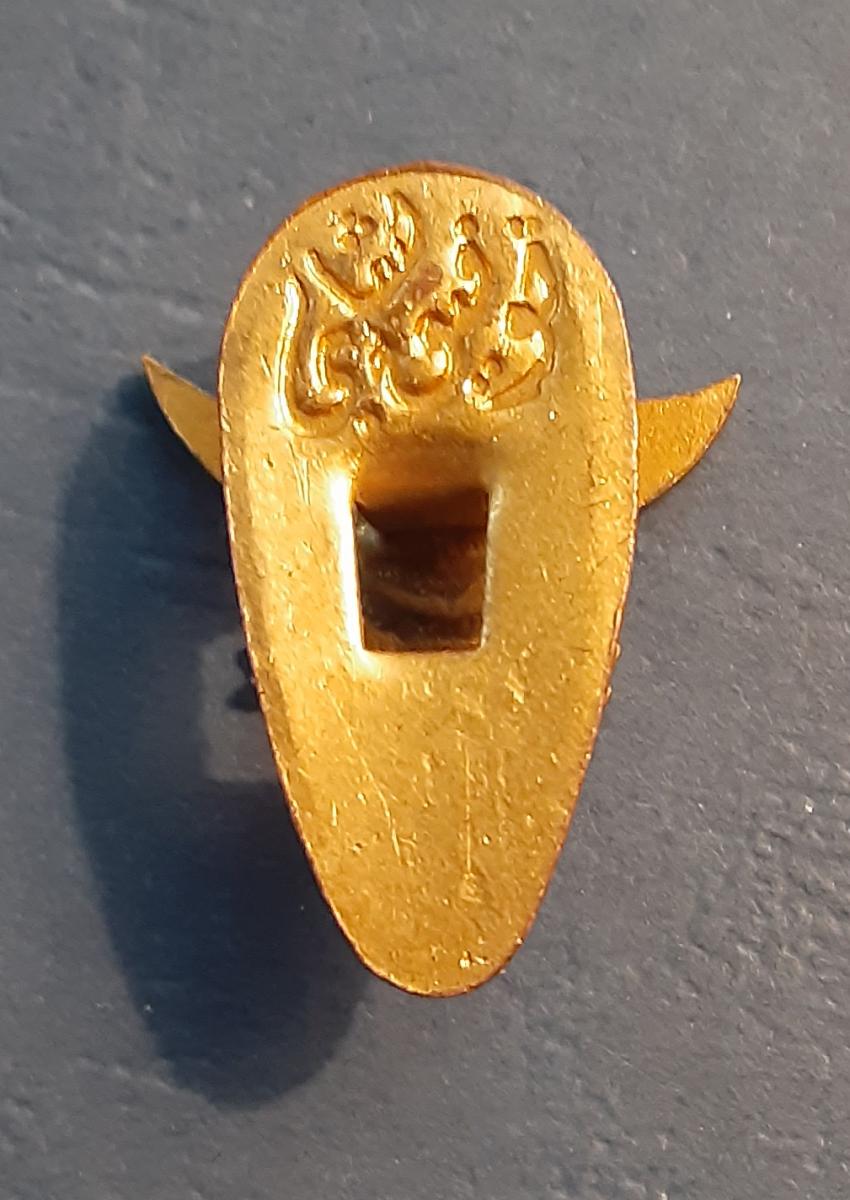
Above is an image of the reverse of another example of a South African Air Force squadron badge for the S.A.A.F. No. 3 Bombing Group Maintenance Company enamelled lapel badge, obtained by the same eBay seller from Fahmy Tewfiq Bichay, as noted in my post of 21 August, 2020. The is the same form of badge as shown in the 2nd photo of my post of 21 August, but carries the Fahmy Tewfik Bichay Arabic maker's mark in contrast with the English language mark on the example shown in my previous post.
0 -
The same 3rd Class Commander neck badge of the Order of Ismail that I discussed in the first 3 photos of my post of 13 August, 2020 and in relation to the 1st photo of my post of 14 August on this thread, that has an anomalous wreath component has just re-surfaced on a current Liverpool Medals website auction, SKU 28988 (https://www.liverpoolmedals.com/product/order-of-ismail-commander-neck-badge-22ct-gold). The auction description states that this neck badge was made by Lattes but incorrectly states that it is hallmarked as 22 carat gold.
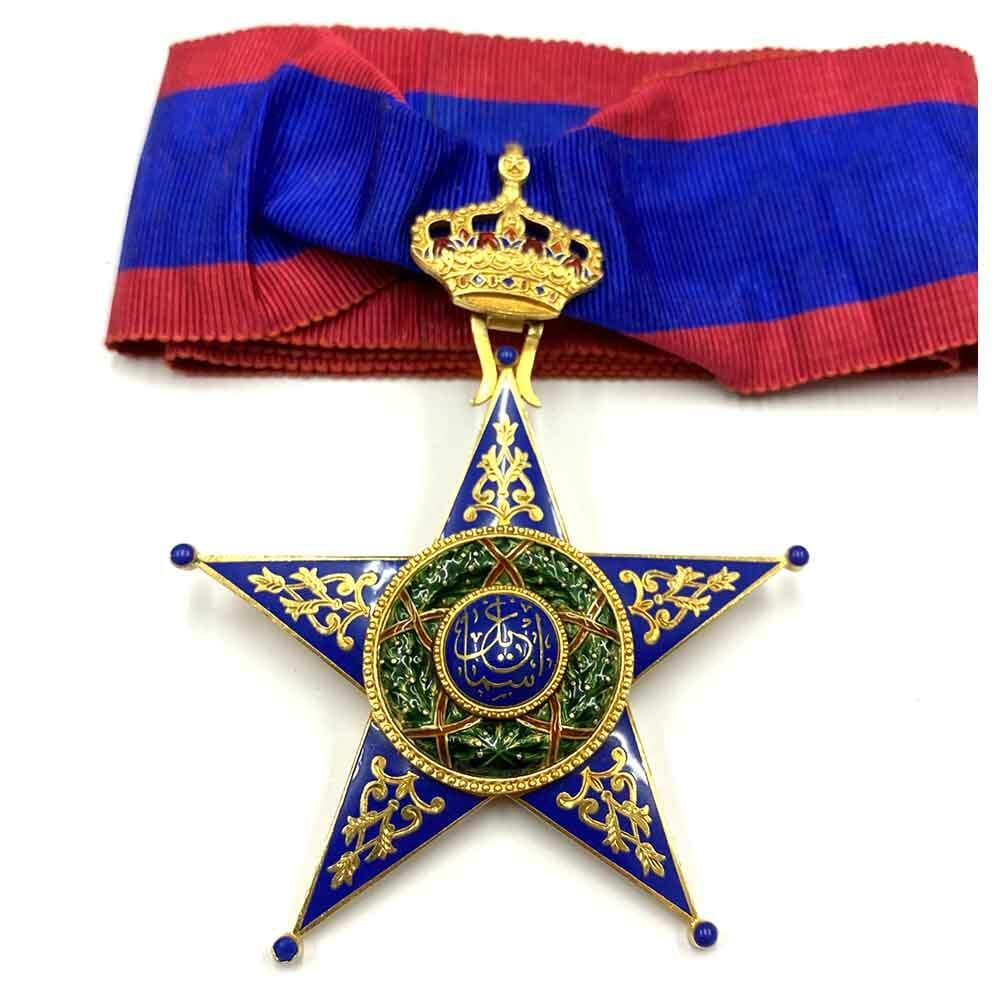
Moderately high-resolution image of the obverse of the Liverpool Medals current auction offering of the 3rd Class Commander neck badge with an anomalous wreath component that is unlike any other example seen from Maison Lattes. This is the same 3rd Class neck badge that appeared in a 22 July, 2019 Auction by eMedals (Item M0306-1) that provided good photos of the obverse and reverse of this badge. It also is the same badge as the recent listed on the Spink website (Auction 20002, Lot 985). Again, I included high resolution images of the obverse of this badge from the July 2019 eMedals auction as the 1st (frontal) and 2nd (oblique) photos of my post of 22 August, 2019, as the 17th photo in my post of 28 March, 2020, and as the 1st photo of my August 14, 2020 post on this thread. I also illustrated the obverse image of this same badge from the recent 2020 Spink auction as the first 3 photos of my 13 August, 2020 post here on this thread. The spillover of the blue enamel, or irregularity in the gold margin, on the lower left finial (7:00 position) is the same as seen in the other photos I am attributing to this particular neck badge. The wreath shows the unusual configuration for a Lattes-made badge that is described in my 13 August post (the different number and configuration of gold laurel fruit dots, thinner and more irregular gold borders of the gold & red enamel bands around the wreath with some red enamel spillover, thiner enamel, and a size that obscures the gold border of each of the star's arms next to the central medallion). The engraving on the gold floral elements of the star's arms is the same as shown in the eMedals and Spink photographs, and is within the normal range of variation for Lattes-made examples. This image can be zoomed for greater detail, and the photo shows the thinner green enamel of the wreath quite well.
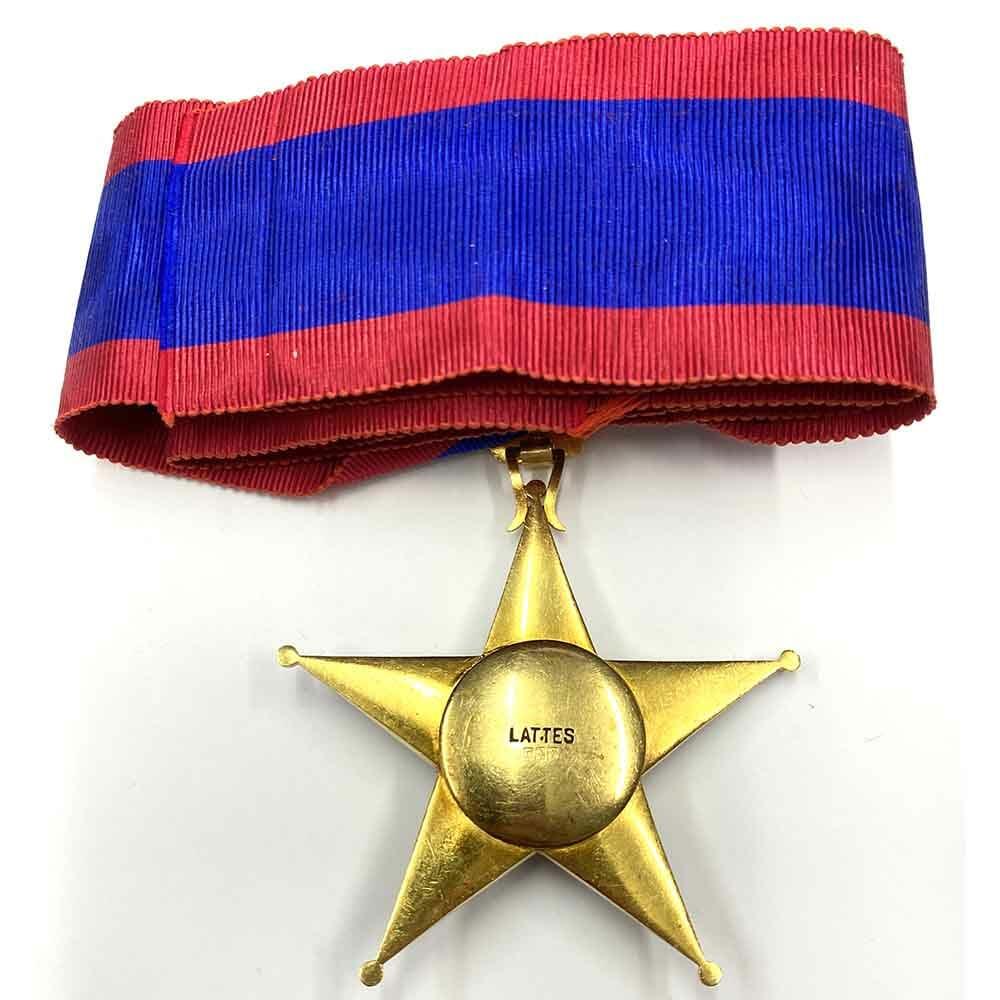
Moderate-resolution image of the reverse of the same Order of Ismail 3rd Class neck badge from a current Liverpool Medals auction. I previously included images from the July 2019 eMedals auction of this same badge in my post of 22 August, 2019 that show better details of the reverse and hallmarks as the 3rd photo (frontal), 4th (oblique), and a close-up of the "LATTES" maker's mark and the 3 Egyptian gold hallmarks as the 5th image in the post. The last image in that prior post shows the Cairo assay office mark for 18 carat gold, the ibis hallmark for Egyptian-made gold, and the date hallmark of "Y" = 1923-1924. The resolution of the Liverpool Medals photo of the reverse is too low to read the Egyptian gold hallmarks clearly, but the Cairo Assay office mark and the ibis mark are slightly defined, and the "Y" date hallmark is not clearly distinguishable. Some of the marks on the reverse of this badge match those seen in the much higher resolution eMedals image, shown as the 5th photo in my post of 22 August, 2019. Although this badge is currently playing hot potato on the auction circuit (why? has someone else noticed the wreath anomaly in this piece?), the asking price on Liverpool Medals is approximately £1,795 greater than the likely price it just sold for about 1 month ago.
0 -
Owain, many thanks for this additional background information about Fahmy Tewfik Bichay, some medals, and the photos. It is wonderful to hear the stories you, 922F, and some others have contributed about meeting him and the wealth of information he shared about many aspects of his career making so many lovely medals and to hear about the generous man he was.
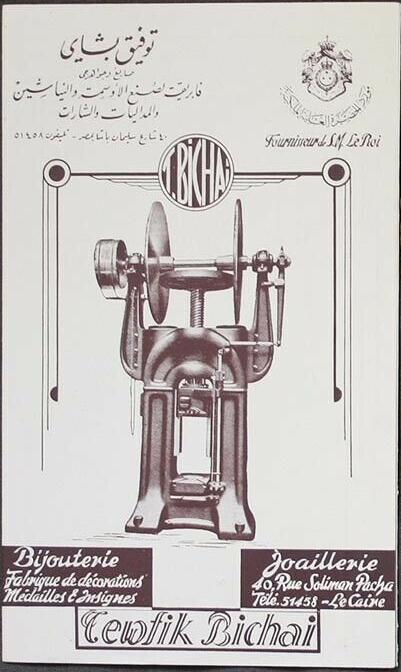
A pre-1952 advertisement for Maison Tewfik Bichai from a current eBay listing of some South African Air Force squadron badges made by Tewfik Bichay (https://www.ebay.com/itm/402193177081). This identifies the workshop at 40 Rue Soliman Pacha, Cairo (also "Suleiman Pasha" Street in English, named after one of the generals of Muhammed Ali's reign), prior to when it was renamed as Talaat Harb in 1954, for the prominent Egyptian economist and founder of Banque Misr. The auction does not include this advertisement, a photo of a pilot wearing one of the Bichay-made badges, nor a copy of a Military issue (1941) identity card for Fahmy Tewfik Bichay (spelled "Fahmi Tawfik Bishay") that are illustrated in the eBay listing. I previously posted an image of that ID as the last photo in my post of 21 October, 2019 on this thread where I was illustrating some variation in J. Lattes cases (mostly for the more common Order of the Nile in that post) & labels as well as the fewer examples of labels I've encountered for Tewfik Bichay and Fahmy Tewfik Bichay The image of the ID came from a section of the MP Antique et Militaria website (http://www.militaria.qc.ca/air-force/south-africa.html) that illustrates and identifies a number of South African Air Force squadron badges that the site moderator obtained personally from Fahmy Tewfik Bichay after he had emigrated to Canada. The same badges are shown on the MP Antique et Military website as on the current eBay listing noted above, and both websites identify all of the badges shown (probably the same seller on the MP Antique et Military website and the eBay listing).
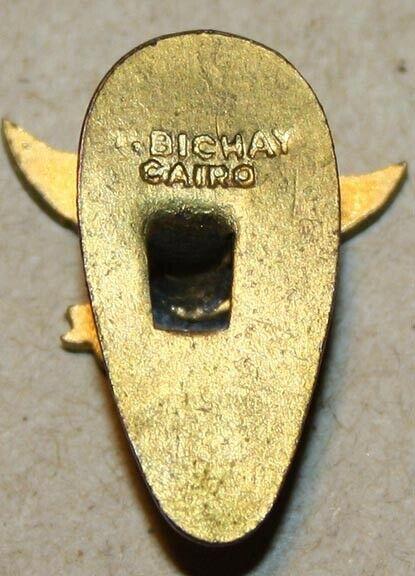
Reverse of one of the South African Air Force squadron badges from the same current eBay listing (identified on the listing as: S.A.A.F. No. 3 Bombing Group Maintenance Company enamelled lapel badge, showing the Bichay maker's mark.
I have recently added some images of badges made by Fahmy Tewfik Bichay for the Free French Forces on the thread "Request for identification assistance-FFL" started by gfh on 8 February, 2018 in the "France" subsection of the "European States" forum section here on GMIC that shows a Cairo-made (by Bichay) Lignes Aeriennes Militaires badge. That thread also includes images of some original designs that gfh obtained from Fahmy Tewfik Bichay's brother (Sadek Tewfik Bichay?). I also illustrated a Polish UNEF II badge marked "T.BICHAY CAIRO" and provided a link to some other Tewfik Bichay-made UN badges on the thread I started on 17 August, 2020 - "Polish UN Peacekeeping Forces Badge for UNEF II-Cairo-Made" in the "Central & Eastern European States" subsection of the the "European States" forum section here on GMIC.
0 -
Below is an image of from a 22 April, 2016 auction by Ader-Nordmann, archived on the AUCTIONFR website (https://www.auction.fr/_en/lot/1ere-compagnie-de-chasseurs-parachutistes-france-libre-fabrication-du-caire-tewfik-9740941), Lot 81, that is identified as an original of the 1ère Compagnie de Chasseurs Parachutistes France Libre made by Tewfik Bichay in Cairo.
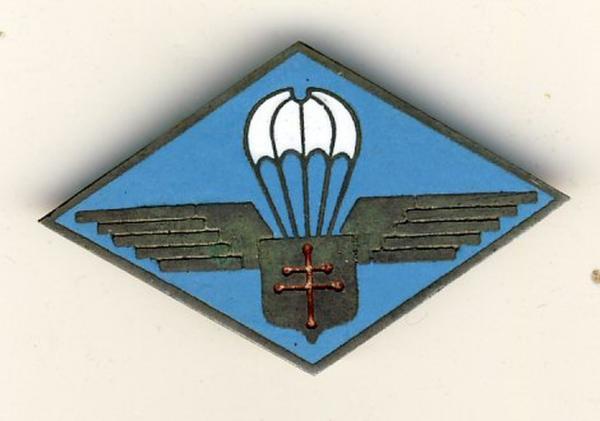
Obverse of a Fahmy Tewfik Bichay-made FFL Parachutist badge for the 1ère Compagnie de Chasseurs Parachutistes France Libre. The auction description states it has a "safety pin" or locking pin attachment (modèle attache épingle à nourrice), but no identiication of the materials it is made from nor dimensions are given. No image of the reverse is shown in the Ader-Nordmann listing. The metal and colors of this original contrast with the 1977 replica of this badge that was reproduced by Fahmy Tewfik Bichay, shown above in the last 2 photos of my post of 2 April, 2020 and in gfh's post of that same day.
0 -
Here is a link to a webpage of Frank Hummel of Marktbergel, Germany with many additional UN badge designs for other missions and different countries forces that were made by Fahmy Tewfik Bichay:
http://www.frankhummel.de/bichay/bichay.html
0 -
Gentlemen, Below are 2 images of a Cairo-made badge for the Polish UN Peacekeeping forces. This badge was probably created for the The Second United Nations Emergency Forces (UNEF II) deployment of Polish forces in November 1973. UNEF II that "was established on 25 October 1973 with the mandate to supervise the implementation of Security Council resolution 340 (1973), which demanded that an immediate and complete ceasefire between Egyptian and Israeli forces be observed and that the parties return to the positions they had occupied ... on 22 October 1973 " (https://web.archive.org/web/20090912145607/http://www.un.org/Depts/dpko/dpko/co_mission/unef2mandate.html) at the end of Yom Kippur War. I not a scholar of any Polish awards, nor of UN peacekeeping history. I have an amateur interest in some Egyptian medals and a few other topics here on GMIC. I recently encountered some enameled badges made for the Free French Forces by the Egyptian medallist Fahmy Tewfik Bichay, and posted information about those badges in on 2 April, 2020 in the thread "Request for identification assistance-FFL" started by gfh on 8 February, 2018 about a Cairo-made FFL Lignes Aeriennes Militaries badge in the "France" subsection of the European States Forum section:
This post is simply to add a bit of information about the range of badges made by Fahmy Tewfik Bichay, who also created several designs for the South African Air Force squadron pins (a link to a website with low-resolution images of those pins, but with complete identification of those pins is given in the description of the illustration of Fahmy Tewfik Bichay's 1941 ID card, shown below).
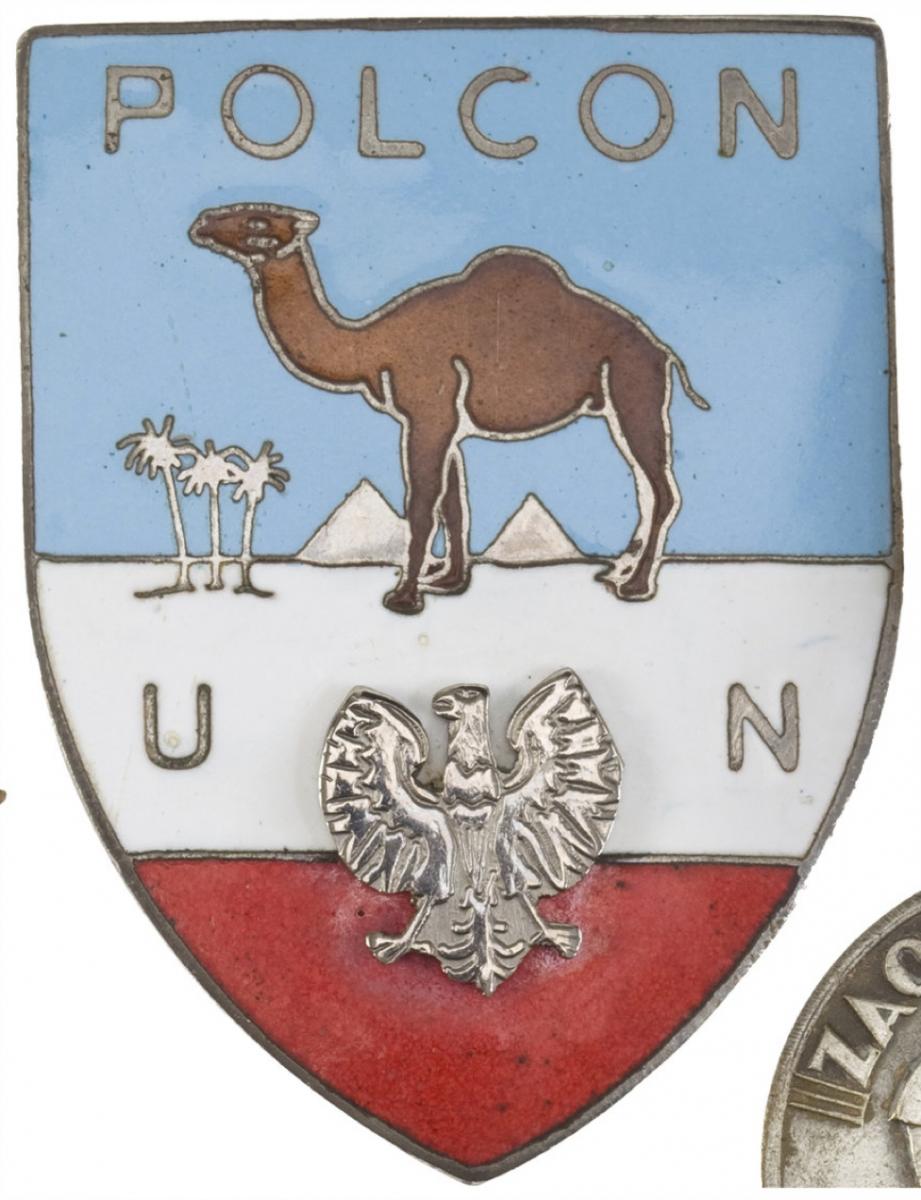
Obverse of a UN Peacekeeping Forces badge from a 12 November, 2011 auction listing for 6 Polish Army badges archived on the Heritage Auctions website (https://historical.ha.com/itm/militaria/insignia/poland-six-polish-army-badges-including-polish-united-nations-peacekeeping-force-badge-two-piece-construction-silve/a/6074-52488.s#). This badge is identified in the auction listing as a "Polish United Nations Peacekeeping Force badge, two-piece construction, silvered metal and enamels, marked "T. Bichay / Cairo". No additional information is provided about this badge. "T. Bichay" almost certainly refers to Fahmy Tewfik Bichay, part of a prominent Egyptian family of medallists (he was the son of Tewfik Bichay, and brother of Sadek Tefik Bichay).
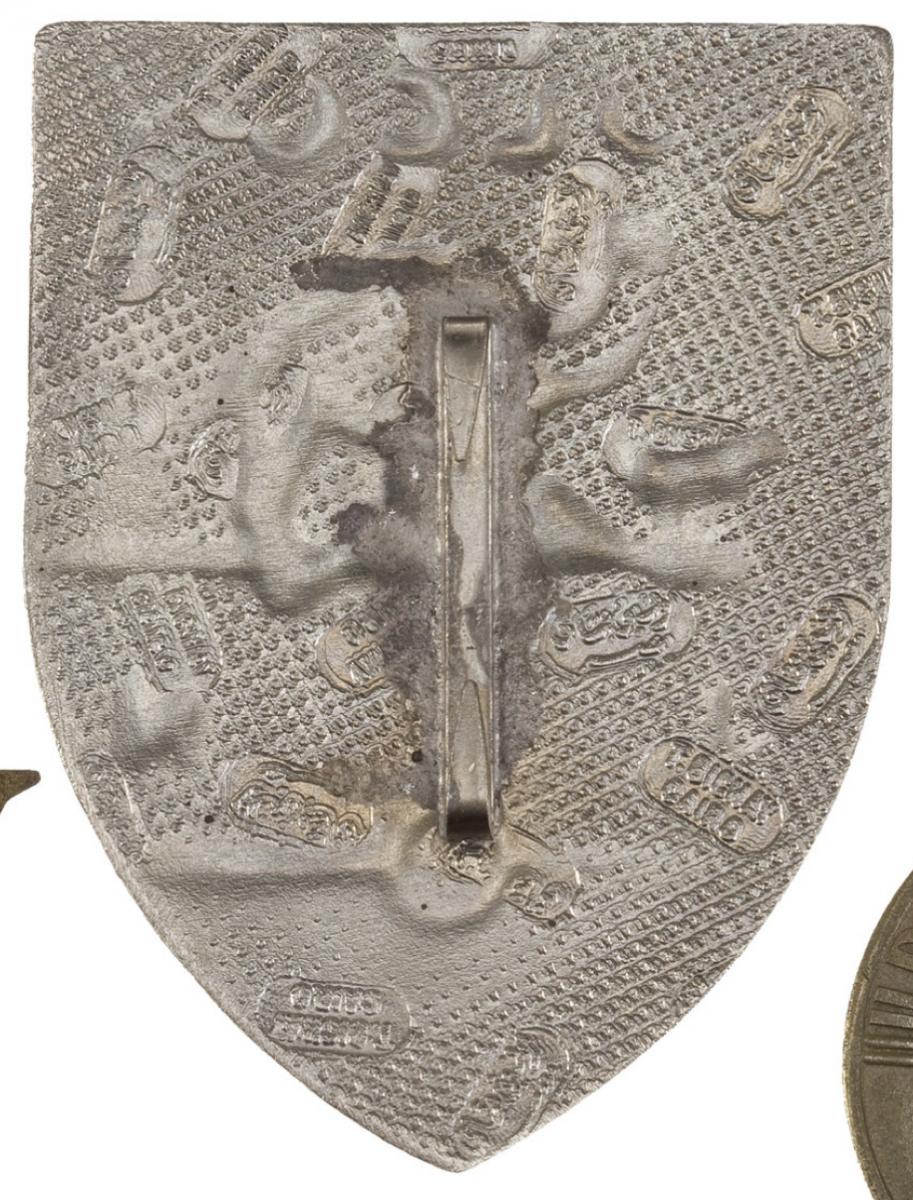
Reverse of the same Polish UN Peacekeeping forces badge showing the multiple markings "T. BICHAY CAIRO: in English and Arabic. Fahmy Tewfik Bichay emigrated to Canada in the 1950s, but as this badge is marked on the reverse with "Cairo" he must have had contacts with a manufacturer still in Egypt to execute this design for the Polish UN forces. This badge that may date to as early as 1973-1974, or sometime later until the end of the final UNEF II mandate that was extended until July 1979 (following the signing of the peace treaty between Egypt and Israel that cam into force on 25 April, 1979). A detailed summary of the UNEF II is available in the following link: https://peacekeeping.un.org/sites/default/files/past/unef2backgr2.html
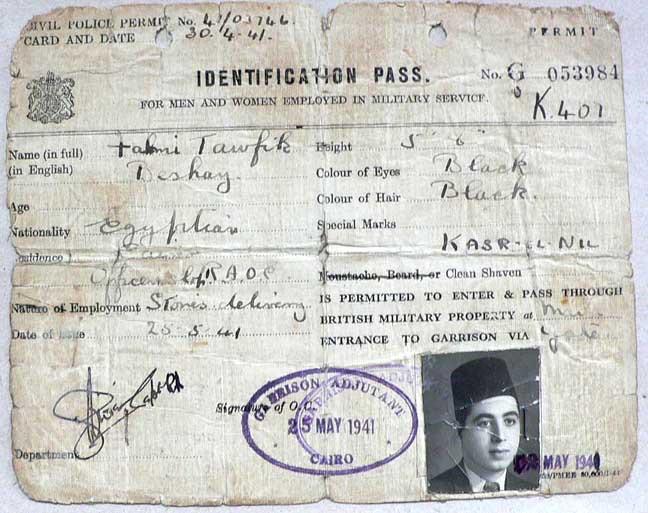
Military issue (1941) identity card for Fahmy Tewfik Bichay (spelled "Fahmi Tawfik Bishay") from a section of the MP Antique et Militaria website that illustrates and identifies a number of South African Air Force squadron pins that the site moderator obtained personally from Fahmy Tewfik Bichay in the 1950s after he had emigrated to Canada (http://www.militaria.qc.ca/air-force/south-africa.html). I previously posted this ID in my post of 4 April, 2020 in the post regarding Free French French Forces badges made by T. Bichay in the "Request for identification assistance-FFL" thread, started by gfh on 8 February, 2018 in the "France" subsection of the "European States" Forum here on GMIC, and as the last photo in my post of 21 October, 2019 where I was illustrating some variation in of cases for Egyptian Orders as well as some examples of labels I've encountered for Tewfik Bichay and Fahmy Tewfik Bichay, on the thread: "Question about the Order of Ismail/Nishan al-Ismail", started on 8 November, 2017, in the "Middle East & Arab States" subsection, under the "Rest of the World: Medals & Military" Forum section here on GMIC.
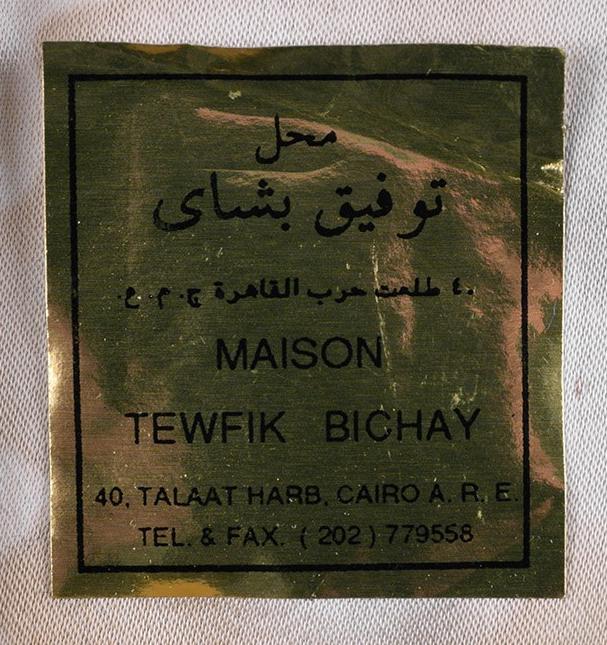
Plain foil paper label for Maison Tewfik Bichay case label from a March 2019 auction listing (Item EU16495) archived on the eMedals website for a 1st Class Grand Cordon Republic period cased set of the Order of the Nile sash, sash badge, and breast star (https://www.emedals.com/egypt-republic-an-order-of-the-nile-i-class-grand-cordon-with-case-c-1955). This set is identified as dating to approximately 1955. Although the label is for the Tewfik Bichay workshop, a business card pasted into the bottom of the case (shown below) is that of Fahmy Tewfik Bichay (the son of Tewfik Bichay). I posted this image as the 4th -to-last image in my post of 21 October, 2019 in the thread "Question about the Order of Ismail/Nishan al-Ismail" here on GMIC.
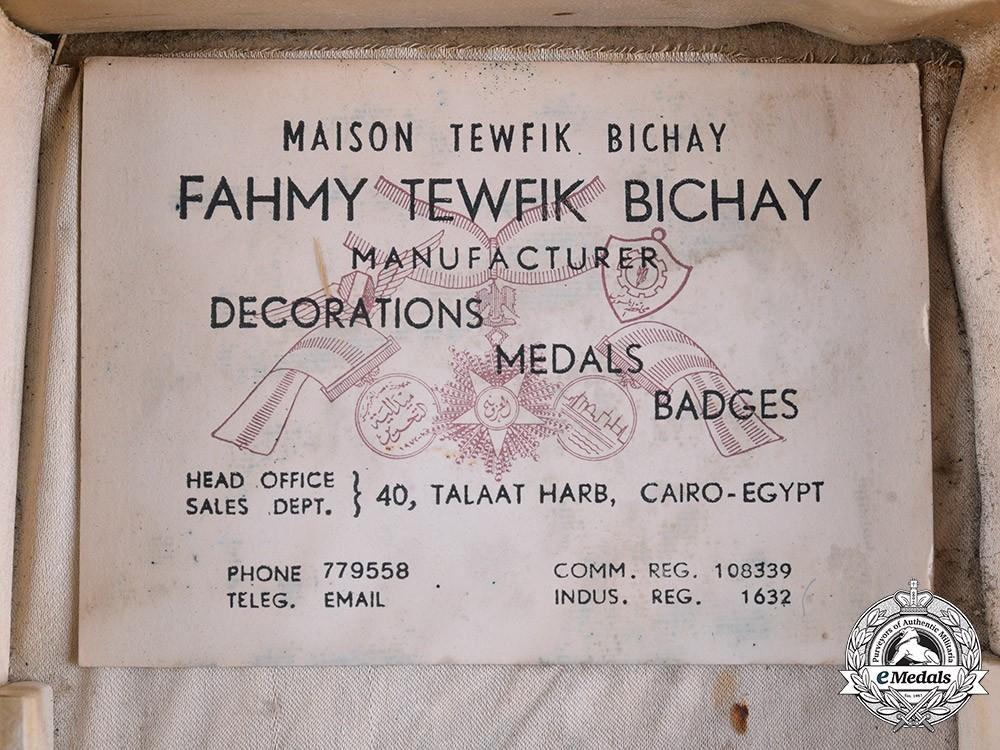
Business card of Fahmy Tewfik Bichay when he still lived in Cairo glued into the base of the same eMedals auction offering of a 1st Class Republic period Order of the Nile cased set. Additional images of other Tewfik Bichay labels, printed manufacturer's names, hallmarks, are shown in my "Question about the Order of Ismail/Nishan al-Ismail" threads, and some image and information about Sadek Tewfik Bichay is summarized in my 7 July, 2020 post in the "Egypt Khedivate Judges Badge question" thread started on 17 November, 201, also in the "Middle East & Arab States" subsection, under the "Rest of the World: Medals & Military" Forum section here on GMIC.
0 -
I would like to elaborate a bit on the comment I made yesterday about the size of the wreath on the Spink Auction 20002, Lot 985 neck badge (shown in the 1st three photos of my post from 13 August, 202). I feel that this wreath element is larger than on other Lattes and on non-Lattes made examples (i.e., the Tewfik Bichay 1st Class sash badge from the fall 2014 Fritz Rudolf Künker auction I referenced yesterday and the 3rd Class neck badge made by Fahmy Tewfik Bichay illustrated by Owain in the 3rd photo of his post of on this thread on 5 April, 2018), suggesting a recent substitution of a wreath component from a non-Lattes piece. I went back to the eMedals listing for Item: M0360-1 from the 22 July, 2019 eMedlals auction (https://www.emedals.com/egypt-kingdom-an-order-of-ismail-in-gold-i-class-commander-by-j-lattes-c-1924) that I am nearly certain is the same neck badge as that shown in the recent Spink auction. An oblique image of that badge shows the wreath obscuring the gold margin of the adjacent central portion the star arms quite well. I wanted to include an additional comparative view of what I think is an anomalous configuration as I have not noticed this difference until I put together yesterday's post. Below, I compare that eMedals M0360-1 image to another oblique view of an eMedals neck badge from a past auction archived on the eMedals website as Item: EG814 (https://www.emedals.com/egypt-kingdom-an-order-of-ismail-in-gold-1st-class-commander-by-j-lattes-c-12439) that shows what is the normal proportional configuration of the neck badge's wreath element in relationship to the gold margin of the star arms. I did illustrate such a comparison yesterday between the 2 Spink examples from frontal photographs, but felt a different view confirms my suspicion that both the configuration and size of the wreath on the first example I illustrated yesterday are anomalous for J. Lattes-made Order of Ismail regalia.
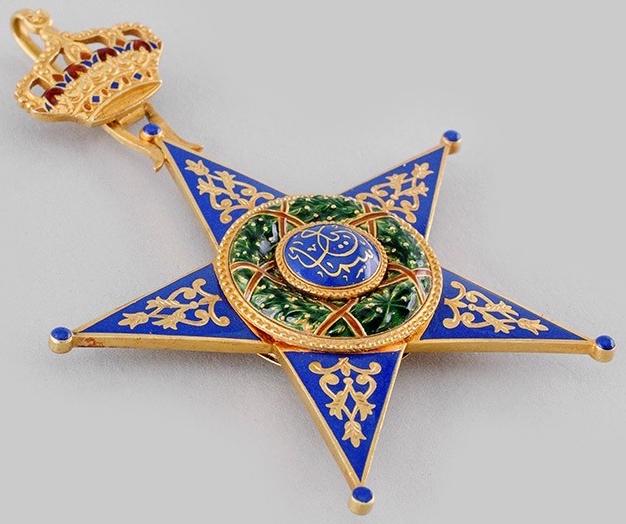
Moderate-resolution oblique image of the eMedals 22 July, 2019 auction Item: M0360-1 neck badge that I think is the same badge as the Spink example shown in the 1st three photographs of my post here yesterday. Comparison of the frontal photo and this oblique image show what I think are identical areas of thinness in the green enamel of the wreath, showing the gold underneath. I previously included this image as the 2nd photo of my post of my post of 22 August, 2019 in addition to the frontal image as the 1st image in that post, views of the reverse (the 3rd & 4th photos in that post), and one of the set of 3 Egyptian gold hallmarks on the reverse (the 5th photo of my 22 August, 2019 post). I would urge anyone interested to compare those images to the single photo of Spink example shown in the first 3 illustrations of my post from yesterday (or the higher resolution images on the Spink website) to confirm that this eMedals neck badge is the same piece as that Spink example. In comparison with the oblique view below (also see the oblique view posted as the 14th photo in my post of 28 March, 2020 discussing variation in the neck badges and sash badges of the Order of Ismail of a 3rd Class Commander neck badge, Lot 1027, from a 6 April, 2019 Very Important Lot auction), it is clear that the wreath element of this badge almost completely covers the gold margins of the most central portion of each of the blue enamel and gold arms. I think it is evident that except for the wreath, all the other elements of this badge are consistently similar to other J. Lattes neck and sash badge examples. However, I feel that the wreath's thinner enamel, different configuration of the gold laurel fruit dots, the less-even form of the gold and red enamel bands around the wreath, and the size of the wreath compared with other Lattes example strongly indicates a replacement of the wreath with one from another badge, likely a Tewfik Bichay piece.
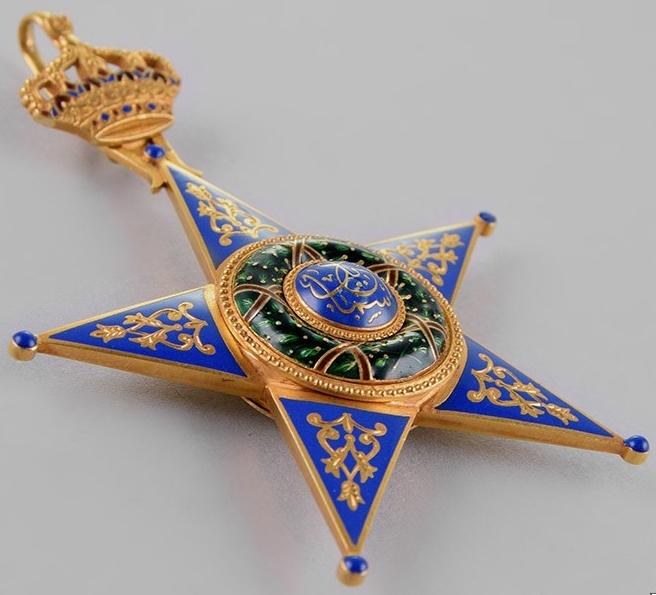
A good-resolution oblique photo of the past eMedals auction Item: EG814 of a Lattes-made neck badge identified as a "1st Class" Commander example for comparison with the above neck badge's wreath. The eMedals listing provides the dimensions of this EG814 piece as 79.5 mm high (including the crown suspension device) x 61 mm wide, a description of the hallmarks, and multiple images of the obverse, reverse, and hallmarks on this piece. The photos clearly show a "LATTES" maker's mark on the reverse above one set of 3 Egyptian hallmarks. The date hallmark "A" on the reverse (shown on the auction listing's photos of the central medallion boss below Lattes name and on the reverse of the suspension loop that attaches the crown suspension loop to the neck ribbon) indicates an assay date of 1925-1926. I included an obverse view of this piece with its normal Lattes configuration of the wreath in my 28 March post about variation in neck and sash badges and several other images of this piece in my post of 11 January, 2019. Compared with the oblique view of the 22 July, 2019 auction Item: M0360-1 neck badge shown above, this view of the neck badge clearly shows the difference in the size of the wreath element (that is consistent in all other aspects with J. Lattes-made pieces, i.e., the thicker green enamel is evident in this photo, the thicker and more even margins of the gold & red enamel bands around the wreath, and other 2 frontal photos of the obverse in the eMedlas listing shows the normal arrangement of gold fruit dots) and the visibility of the gold margins of the adjacent portion of the star's arms in contrast to the Item: M0360-1 neck badge.
0 -
Owain alerted me a couple weeks ago to a very recent Spink auction of an Order of Ismail neck badge that I had not seen. In looking at this piece, I also realized I had neglected to include a moderate-resolution image of another neck badge from a previous Spink auction in my discussion of design variations of 2nd and 3rd Class neck badges and 1st Class sash badges on 28 March, 2020 within this thread. Consequently, I am including images from the auction that Owain identified me and the previous Spink example for some minor additions to information about design variation seen in the Order of Ismail neck badges.
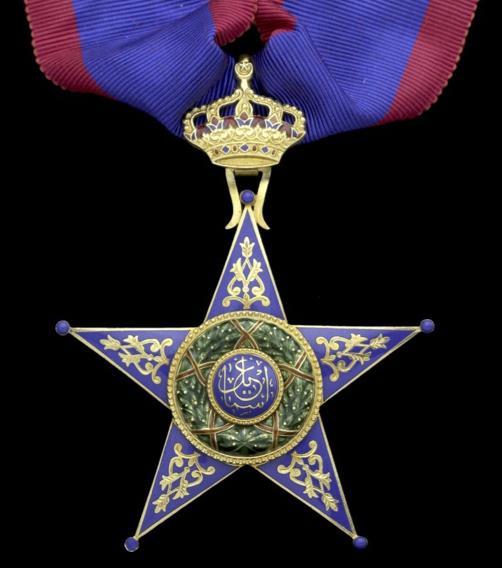
Image of the recent Spink offering of an Order of Ismail neck badge from Auction 20002, Lot 985 (https://spink.com/lot/20002000985). The Spink auction images are of higher resolution than the above (and 2 following) photos and can be zoomed to examine the engraving on the arms and the form of the wreath around the central inscribed medallion in better detail. The class of this neck badge is not identified, but it is stated to have been made by Lattes and measures 80 mm in height (including the crown suspension device) x 60 mm in width. The auction listing does not provide any images of the reverse, but states that the maker's name (Lattes), a gold hallmark, and a date Hallmark of "Y" is present on the reverse. The "Y" hallmark indicates an assay date of 1923-24. This example is interesting as the form of the wreath around the central inscribed medallion is not typical for Lattes pieces. The date of 1923-1924 is within the period when Lattes was the manufacturer of this regalia. The only examples of this form of wreath on a piece that I have seen that is marked with Lattes name is the one I included as the 17th photo in my post of 28 March, from a 22 July, 2019 eMedals auction (Item M0306-1, identified in the auction description as a 3rd Class Commander neck badge), also with a "Y" date hallmark. I previously included several images of that eMedals neck badge in my post of 22 August, 2019. The eMedals image in the 2019 auction listing is not high-resolution, but the engraving on the star's arms, the configuration of the gold and red enamel bands around the wreath (including areas of overflow), and possibly some overflow (?) on the terminal finial of the lower left arm all appear quite similar (identical), and I believe this is the same piece. The cropped photos below are slightly better resolution and show those similarities to the eMedals example much better than the photo above. As noted in my 28 March post, the only other neck or sash badges with this form of wreath that I have seen in the online images I check are: that shown in the 16th image of the same 28 March, 2020 post showing a neck badge from Hassan Kamal-Kelisi Morali's flickr photostream (no maker's attribution, but identified as a 3rd Class Commander neck badge), and the 18th photo in the same 28 March post identified as a 1st Class sash badge made by Tewfik Bichay from a fall 2014 Fritz Rudolf Künker GmbH & Co. KG auction with the off-center & slightly rotated wreath. In reviewing the Hassan Kamal-Kelisi Morali's flickr image, I only recently noticed that in addition to some anomalous engraving and the uncommon form of wreath (except on later pieces by Tewfik Bichay) it also lacks the border of fine gold balls seen on all classes of neck badge, sash badges, breast stars, and breast badges for the Order of Ismail.
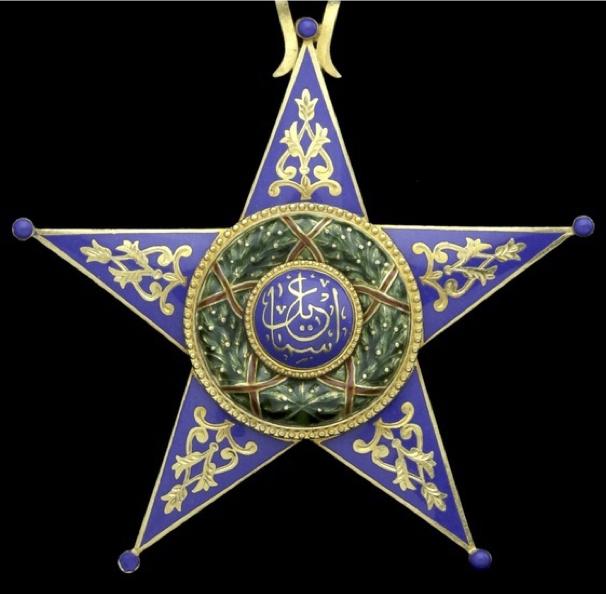
Cropped image of the same neck badge from the Auction 20002, Lot 985 Spink auction listing showing slightly better detail of the engraving on each of the arms of this neck badge and the form of the wreath surrounding the central inscribed medallion. As noted in my 28 March, 2020 post, the eMedals listing of what I believe is the same neck badge provides illustrations the reverse showing the "LATTES" maker's mark, the Egyptian gold hallmarks, and the "Y" date hallmark. In order not to be too redundant, please see my discussion of the engraving and wreath configuration in that 28 March post of the eMedals example.
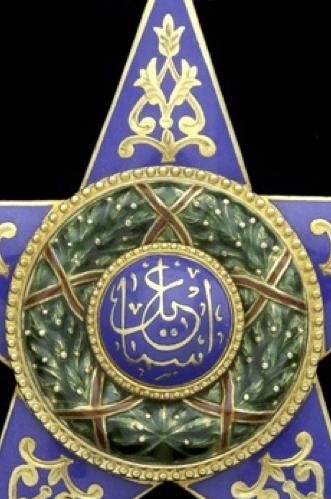
Cropped image showing he best detail I can obtain as a jpg image of this same Spink neck badge. This provides some better detail of the engraving of the gold floral design elements on the star's arms and of the wreath configuration than can be seen in the 2 images above or on the 17th photo in my 28 March, 2020 post of what I think is the same neck badge as this recent Spink auction piece. As is apparent in all 3 of these photos here, the form of the wreath surrounding the central inscribed medallion is anomalous compared with all other images of neck and sash badges that bear the "LATTES" manufacturer's mark. Although it has the same number of gold fruit dots in the most inferior panel (6:00 position) as on 4th Class Knight breast badges, they are in a slightly different configuration and those in the other panels are different as well. It is strikingly similar to the fruit dot configuration as well as the width and slight irregularities of the gold boundaries of the red & gold bands around the wreath seen on the Tewfik Bichay-made example of a 1st Class sash badge, shown in the 18th photo in my 28 March post. The wreath also appears to be larger than all of the other normal Lattes-made pieces. As can be seen in comparison with the Spink example illustrated below (and in all of the Lattes examples with normal wreath configurations shown in my 38 March post), there is much less of the gold inner border of each arm visible underneath the exterior margin of the wreath than in all other Lattes pieces. Only the piece with very anomalous engraving on the gold floral elements of the blue enamel and gold arms of the star that also has the same odd configuration of the wreath for a supposedly Lattes made 2nd Class Grand Officer neck badge (shown as the 1st photo of my 28 March post) has a wreath that seems to almost completely obscure that gold border on the inner margin of the star's arms. Even the 1st Class Grand Officer sash badge from the fall 2014 Fritz Rudolf KünkerI auction made by Tewfik Bichay with the same form of wreath configuration of gold laurel fruit dots as this Spink example (and unlike all unquestionably Lattes-made pieces) has a wider and clearly visible margin of gold on the inner portion of the star's arms adjacent to the exterior margin of the wreath component as seen on Lattes badges. I do not know whether this suggests a later repair of this piece using a wreath from a different, non-Lattes manufactured insignia (a Tewfik Bichay sash or neck badge's wreath that may [?] be slightly larger than the Lattes wreaths, although the overall dimensions are probably identical), but this aspect of the Spink badge's configuration is clearly anomalous.
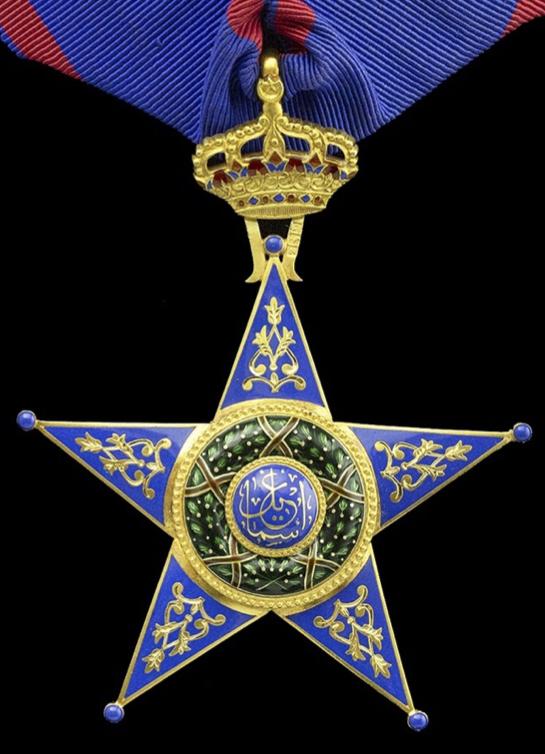
Order of Ismail neck badge from a past Spink, offering, Auction 18003, Lot 908 (https://spink.com/lot/18003000908). The image on the Spink website is of much higher resolution than I can download, and may be zoomed to examine it in greater detail. I neglected to include this image in my discussion of neck badges and sash badges in my post of 28 March, 2020, but I had previously illustrated this example as the 2nd photo in my post of 1 November, 2019. The Spink listing does not identify the class of this piece, but does state that it was made by Lattes, measures 83 mm in height (including the crown suspension device) x 62 mm, and identifies an assay date hallmark of "Z". The "Z" date hallmark indicates an assay date of 1924-1925. Unlike the above example, the wreath design configuration of this piece is consistent with other Lattes-made examples.
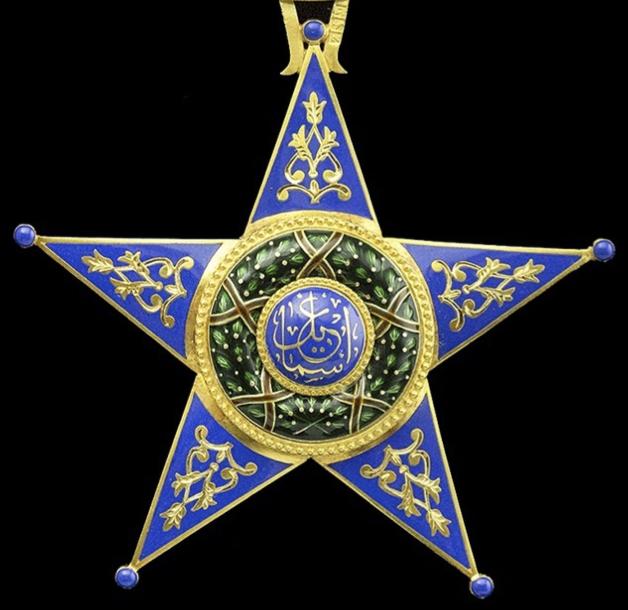
A slightly higher-resolution cropped image of the same neck badge form the Spink Auction 18003, Lot 908. As can be seen in this photograph, the complete set of 3 Egyptian gold hallmarks are present in the normal position on the right side link between the superior star arm and the crown suspension device showing the Cairo assay office hallmark for 18 carat gold, the ibis mark identifying Egyptian-made gold, and the date hallmark of "Z".

A close-up cropped image of this same Spink neck badge from the 18003 Auction, Lot 908 showing details of the engraving on the superior arm and the normal wreath configuration for Lattes manufactured regalia. As I did not include this in my post looking at design and execution variation, I will briefly comment on that for this piece as another example of normal differences in J. Lattes-made neck and sash badges. There is some overflow of red enamel at the point where each of the gold and red enamel bands around the wreath cross. The engraving shows 2 lateral marks and a single central engraved line on the most distal gold flower of the floral decoration. The 2 middle flowers each have 3 lateral engraved marks and 2 engraved lines outlining the central petal of each flower. The lowermost of the 3 lateral engraved lines forms the line running inferior from the flowers into their stems that meet at a single horizontal engraved line in the circular gold origin point of both central flowers. The engraving of the line running from the most distal flower to form the stem/leaf element running proximally to the most distal portion the gold floral design is similar to that described for other Lattes examples in my 28 March post. The most proximal "bud" and leaf element of the gold design has a single engraved line in the central bud element, and somewhat less elegant lateral lines in the leaf element that lack any lateral curl at the lateral end. On each arm, the engraving of the basal leaves exhibits a slightly off-center meeting point with each other in the most proximal somewhat square-off origin of the gold floral design underneath the central bud component.
0 -
Owain,
Thanks for the inscription translations and including the additional Libyan photos. The only translation I came across was associated with flickr photostream of askamel (https://www.flickr.com/photos/askamel/2074544038/) showing a badge that is not specifically identified beyond the tag: "The Egyptian Parliamentary Star". Today I paid attention to the inscriptions on the central medallion, and realized that I had not done so in my previous post and made some errors in attribution of the badges. I have cheated and gone back to correct those in yesterday's post. The most problematic part of what I wrote yesterday, is that it now appears that the badges associated with the eMedals auction listing are a mix of the Chamber of Senators (neck badge and lapel badge) and the Chamber of Deputies (the sash badge). Of course, this leaves me unsure whether the unbordered sash in that auction grouping may represent the form for the Chamber of Deputies or the Chamber of Senators.
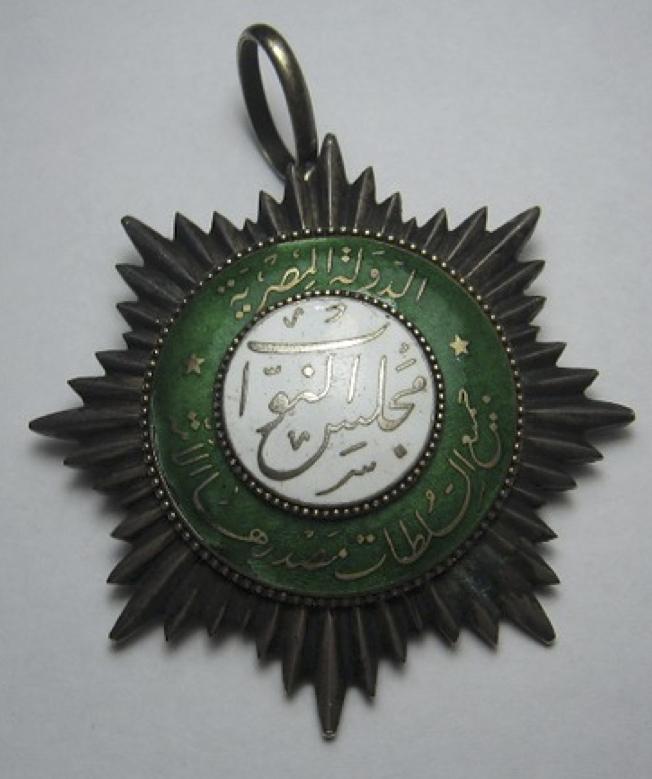
Photo of the obverse of a neck badge or sash badge of the Egyptian Chamber of Deputies from askamel's flickr photostream. This image is copyrighted by askamel. Although not identified as to which House of Parliament this badge belongs, the inscription on the central medallion is that of the Chamber of Deputies. Askamel provides the following translations for this image: for the upper inscription line in the green enameled margin of the central medallion: "The Egyptian State" (the same as your translation); for the the white enameled central medallion: "The House of Representatives"; and for the lower inscription line in the green enameled margin of the central medallion: “All the Powers Come From the Nation”. Owain, I wonder if I can trouble you for comment on these translations and one for the central medallion inscription of the badges for the Chamber of Senators?
0 -
Here are a few additional images of Kingdom of Egypt Parliament badges to complement the 1st post of Linasl and Owain's significant information about the insignia.
The 1st set of images below are of another example of a neck badge with the associated ribbon. These images come from a past auction on The Orient Treasures website (https://www.theorienttreasures.com/shop-now/orders-medals-decorations/egypt-order-of-parliament-house-of-repesentatives-neck-badge-medal-nichan-rare). The only information in the auction description is that the diameter of the neck badge is 65 mm. All of these images from The Orient Treasures can be zoomed for some additional detail.
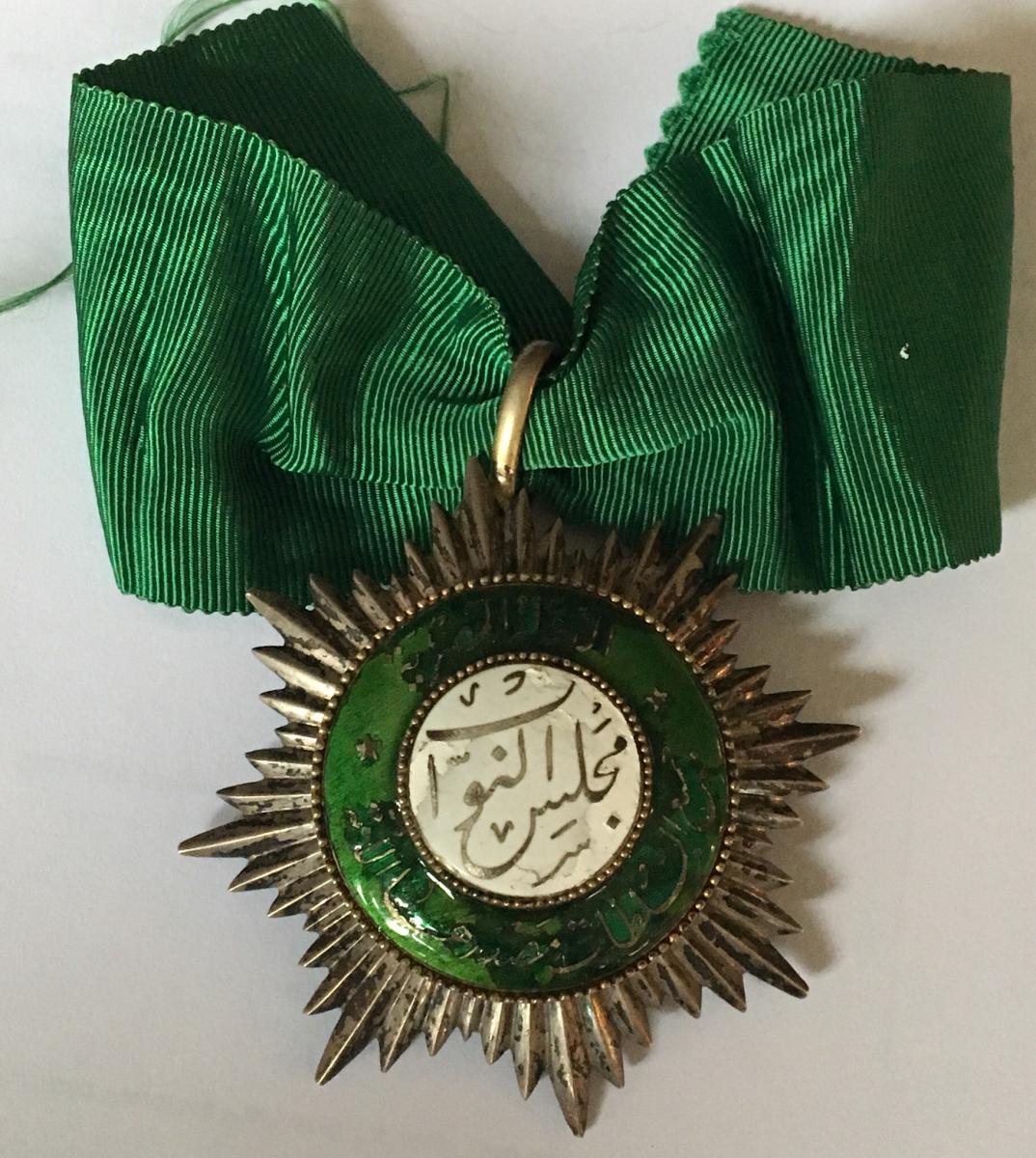
Obverse of a neck badge of the Egyptian Chamber of Deputies (the Lower House of Parliament) from The Orient Treasures website. Hassan Kamel-Kelisi-Morali employs a different form of English spelling for this house of Parliament on his flicker photostream (see images below) as: Magles el Shoyoukh (just in case some form of that English spelling turns up in other info on this badge).
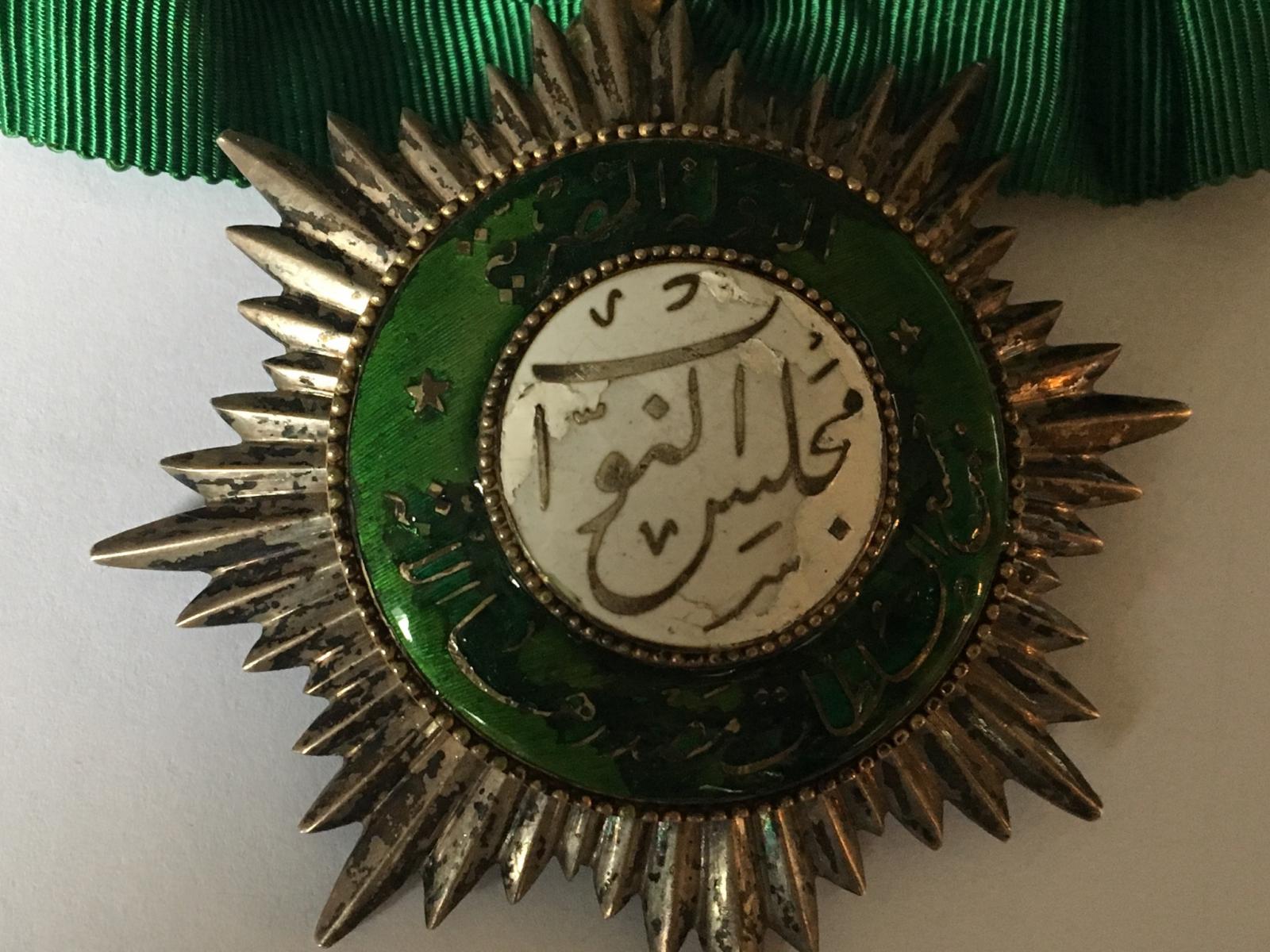
Close-up view of the obverse of this same neck badge showing crazing and loss of some of the enamel (it almost appears to be peeling of the white enamel, especially in the upper left of the central inscribed medallion).
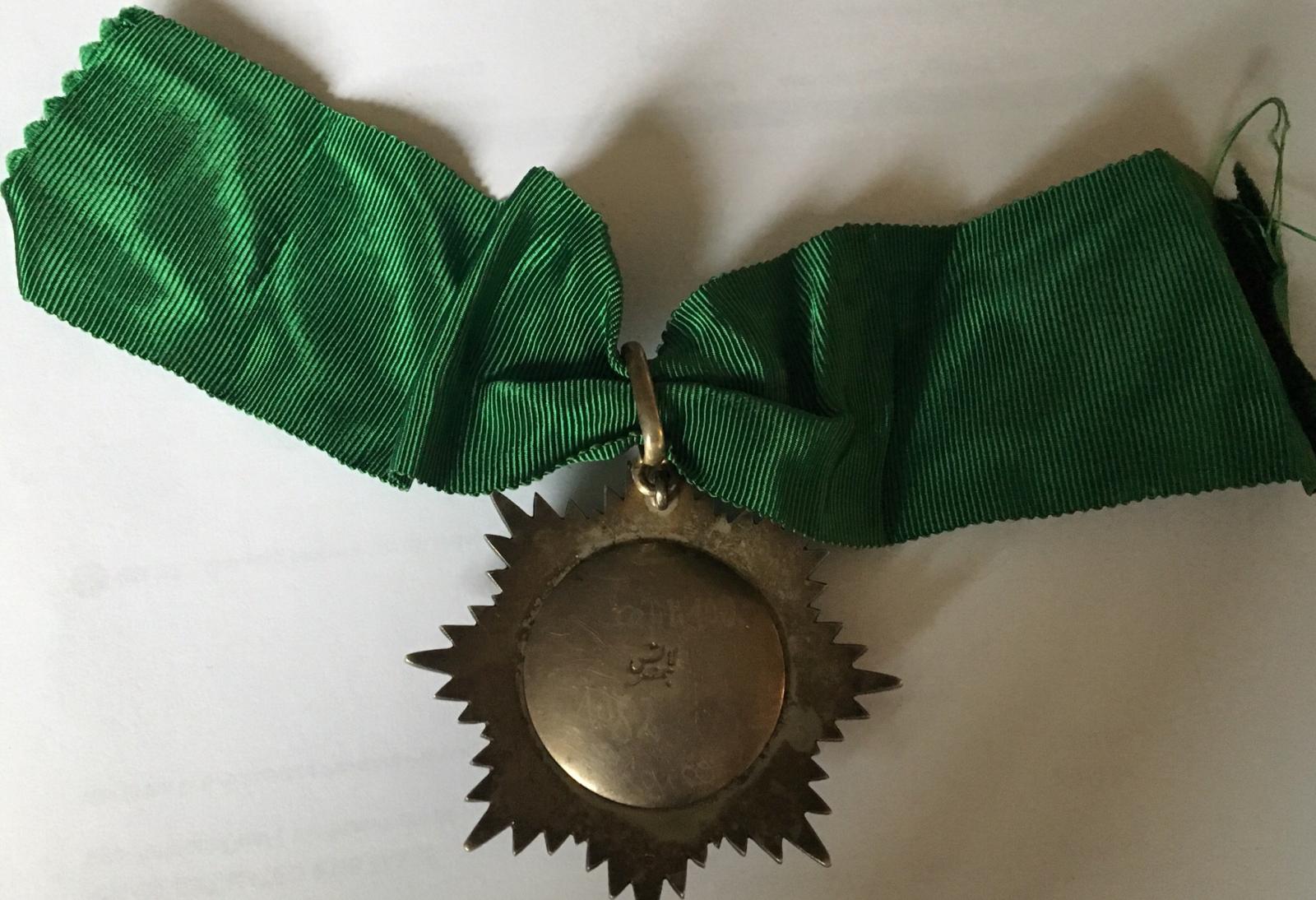
Reverse of the same Chamber of Deputies neck badge showing the maker's hallmark in the center of the medallion's boss.

Close-up view of the reverse of this same neck badge showing the maker's hallmark in greater detail. This image can be zoomed for better detail of this mark. Although the mark "LATTES" is most common on the J. Lattes-made medals of various Egyptian orders, this Arabic mark appears to be Lattes' hallmark in Arabic. I am basing this on the signature mark in the lower left of an original Lattes design for these badges that is shown as the 6th and 7th-to-last images in this post. His signature "Lattes" appears in the lower right of these same illustrations. This image of the reverse shows the placement of the 3 Egyptian hallmarks in the long central ray of the inferior set of 5 rays composing each of the 8 groups of rays (divided from each other by a small ray) that are the embellishment of the badge. The resolution of the image is too low to read the silver hallmarks on this example. However, the hallmarks on the eMedals example illustrated below can be identified.
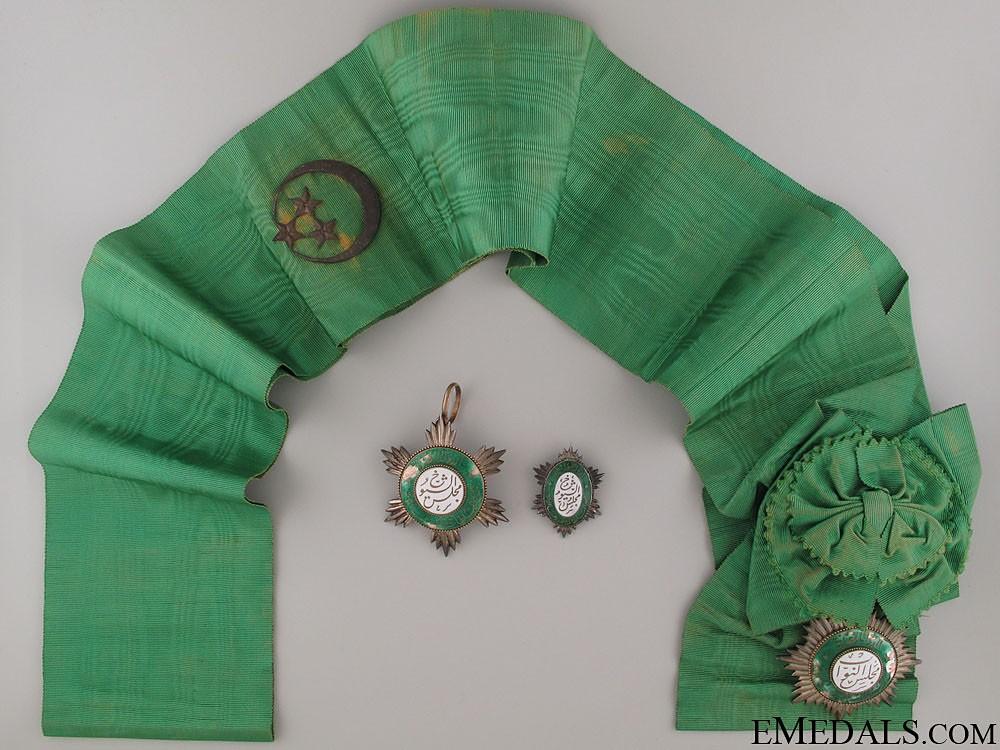
Above is an image of set of insignia for the Egyptian Parliament, from a past eMedals auction (Item: W1572; https://www.emedals.com/africa/egypt/an-egyptian-upper-house-of-parliamentary-set-w1572). This grouping is identified in the auction description as representing the "Upper House of Parliament", which should be the Chamber of Senators that Owain mentioned above. The auction group consists of a neck badge (without a ribbon), sash with crescent & stars pin, sash badge, and lapel pin. Unfortunately, it appears that this is a combined set of regalia from both the Chamber of Senators (the Upper House) and the Chamber of Deputies (the Lower House). I did not initially pay attention to the forms of the inscriptions on the central medallions of the badges, but they indicate that the neck badge and lapel badge are for the Chamber of Senators, while the sash badge is that of the Chamber of Deputies. The auction description provides listed dimensions, but they are not specifically identified for each component; given as 63 mm (sash badge?), 30 x 41 mm (lapel badge?), and 62 mm (neck badge?). The corrosion (rust?) of the crescent & stars pin suggests that it is not silver, as are the the neck badge, sash badge, and lapel badge. Note in relation to 3 portraits at the end of this post, that there is no contrasting-colored border of the above sash. The mixture of badges leaves me unclear whether the form of the sash (not having a colored border) is that of the Chamber of Deputies or the Chamber of Senators. All of these eMedals photos can be enlarged for additional details.

Obverse of the neck badge from this auction group, that is an emblem of the Egyptian Chamber of Senators insignia, showing damage to some of the green enamel of the margin of the central medallion.
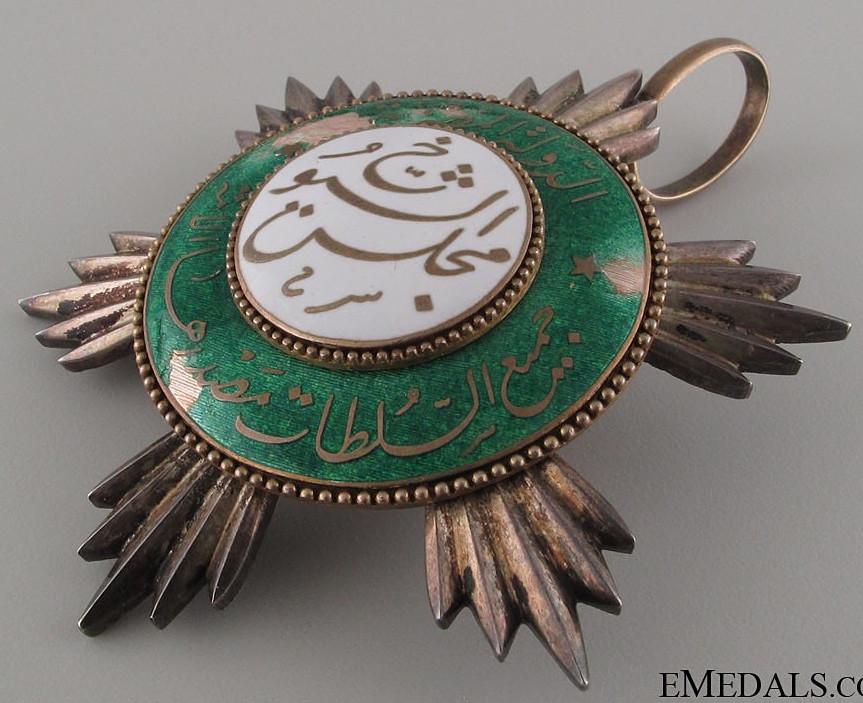
Oblique view of the same eMedals Egyptian Chamber of Senators neck badge, showing well the textured background underneath the green enamel of the margin of the central medallion.
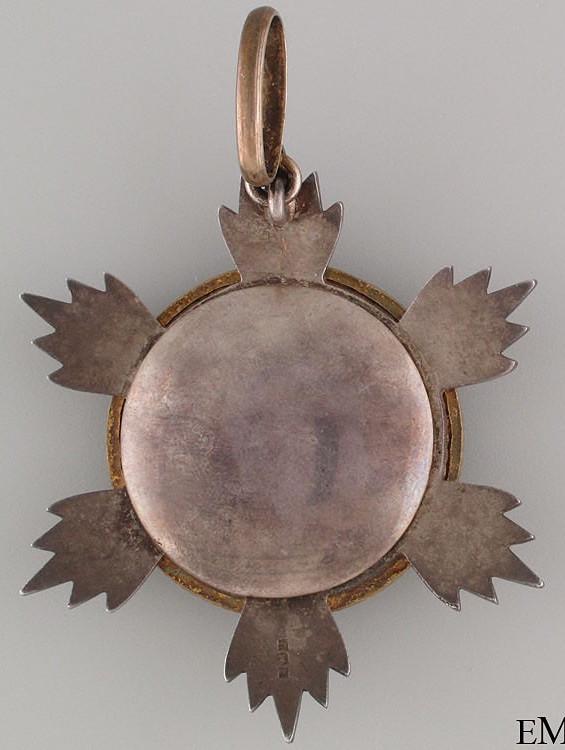
Reverse of the same neck badge showing the lack of any maker's hallmark, but the position of the 3 Egyptian a silver assay hallmarks can be seen in the center of the most inferior rays of the embellishment.
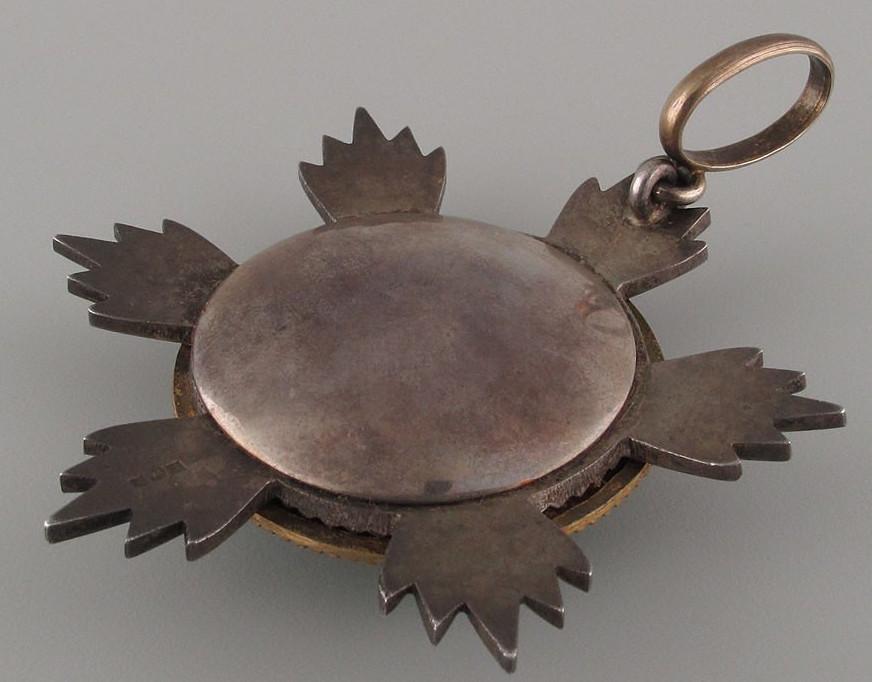
Oblique view of the reverse of this same Egyptian Chamber of Senators neck badge showing some construction details.
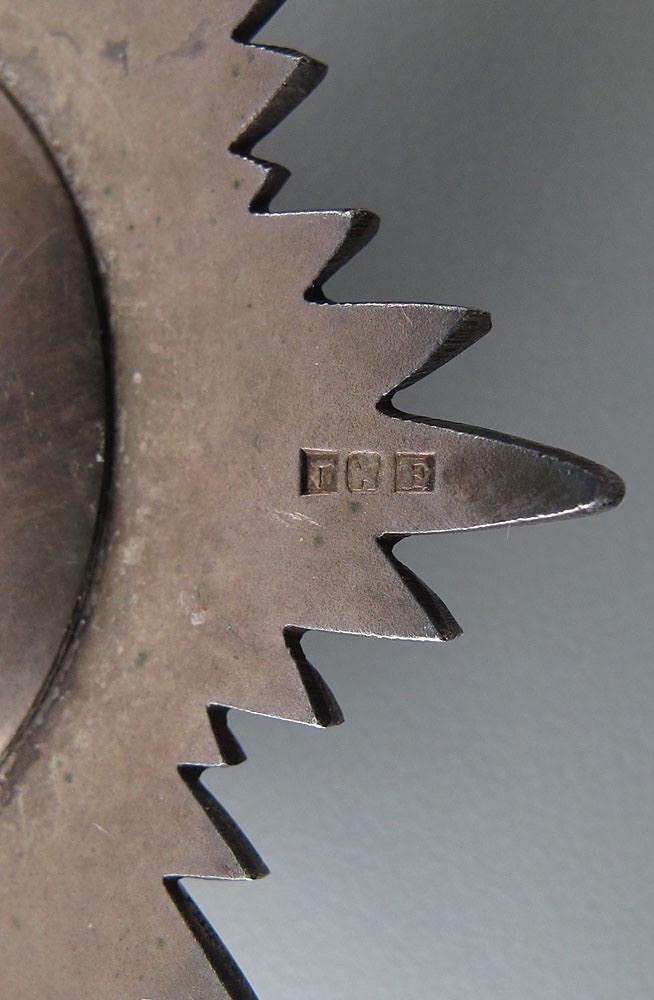
Image of the same eMedals neck badge's reverse, rotated to show the 3 Egyptian silver assay hallmarks in their readable orientation. The first hallmark at the left is the silver purity assay mark of the Cairo office. Although not completely clear in this image (nor in the one below) this appears to indicate 900 silver. The central hallmark is the cat (form with the raised tail) indicating that this is Egyptian-made silver. This mark was used between 1916-1946 (although there are a couple exceptions, I documented one on a King Farouk I medal commemorating the closure of the Mixed Courts on 14 October, 1949 that employed the cat hallmark with a correct date hallmark for 1948-1949). The hallmark at the right is the date hallmark that appears to be an "E" rather than an "F"; "E" indicating marking at the assay office in 1930-1931. The photo of the set of hallmarks on the sash badge of this auction grouping (shown below) is of higher resolution and shows the marks a bit more clearly. That set of hallmarks also bears the "E" date hallmark, although the sash badge is that of the Chamber of Deputies, not the Chamber of Senators as is this neck badge.

Obverse of the lapel badge of this same past eMedals auction grouping that also bears the inscription on the central medallion indicating it is an insignia of the Egyptian Chamber of Senators.
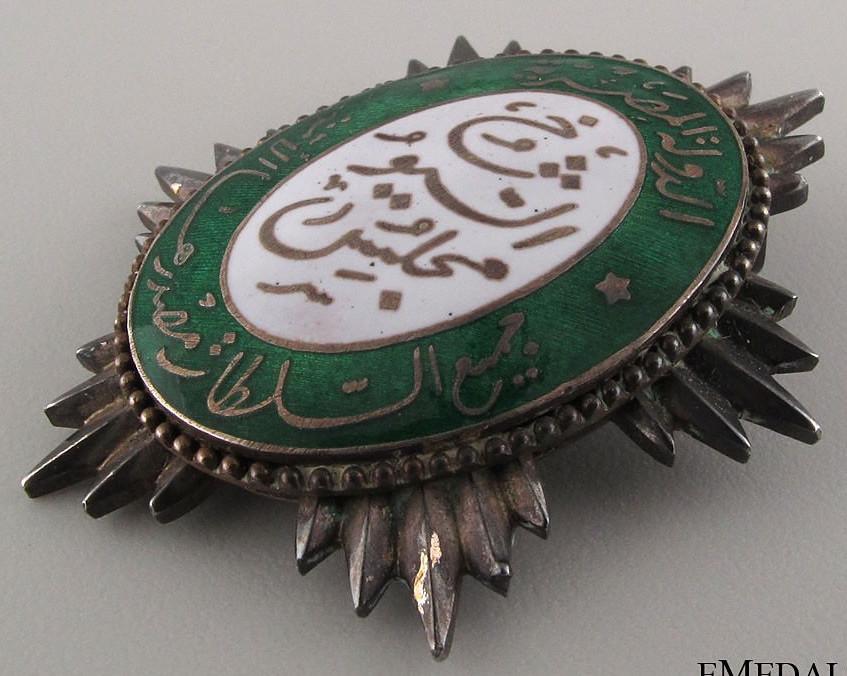
Oblique view of the obverse of this same lapel badge.
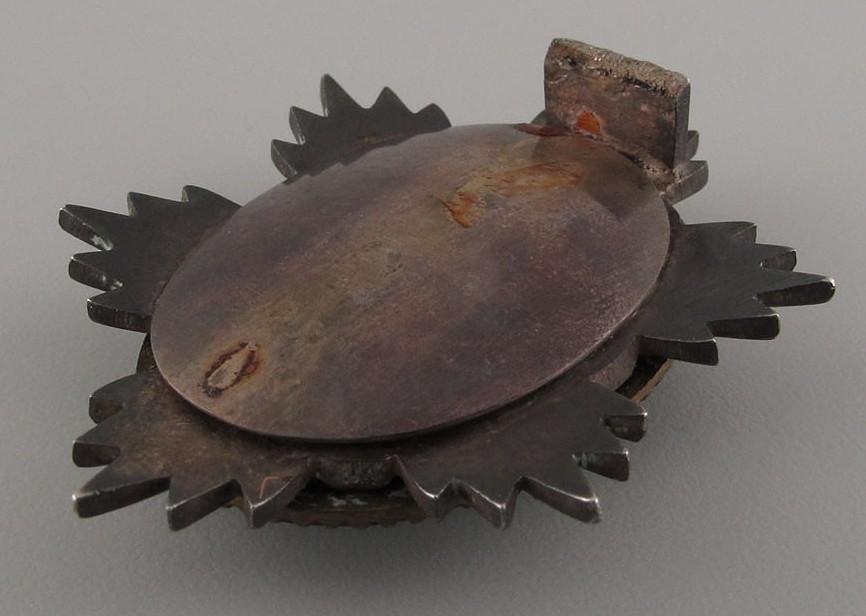
Reverse of the same eMedals Egyptian Chamber of Senators lapel badge showing the lack of any maker's marks or silver hallmarks. It appears to show attachments for a missing set of pin, hinge, and latch rather than what may be a simple clip on the example Owain illustrated above. Such a clip also seen in the Libyan examples illustrated by Owain in his post of 18 May, 2016 on the thread "Libya-unknown order and medal" started by James Hoard on 15 May, 2016, here in "the Middle East & Arab States" section (see link to that post below).
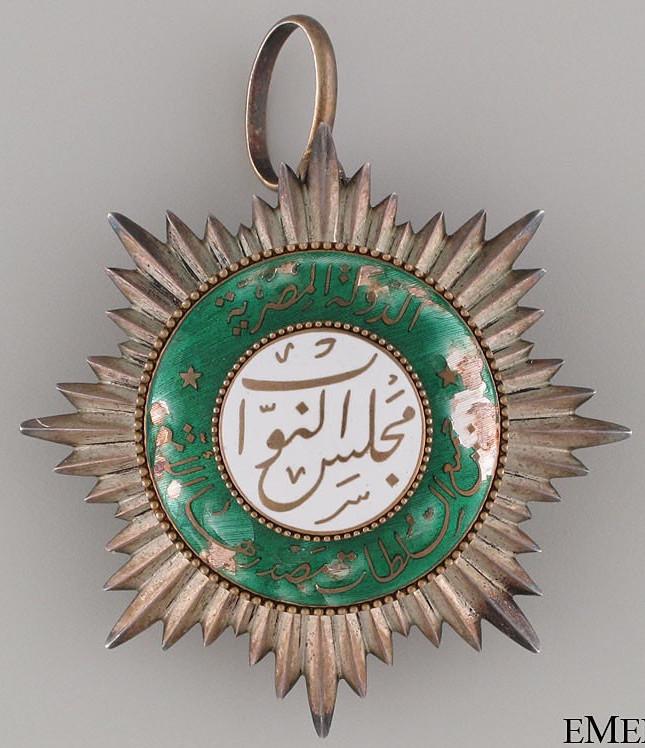
Obverse image of the sash badge from this eMedals auction grouping that bears the inscription on the central medallion of the the Chamber of Deputies, not that of the Chamber of Senators regalia. This sash badge also exhibits a fair bit of damage to the green enamel.

Oblique view of the obverse of the same sash badge of this eMedals set of Parliamentary insignia of the Chamber of Deputies. The damage to the enamel provides an opportunity to see the textured background of the margin to the central medallion. Does this technical feature reflect more light and "brighten" the enamel around the inscriptions?
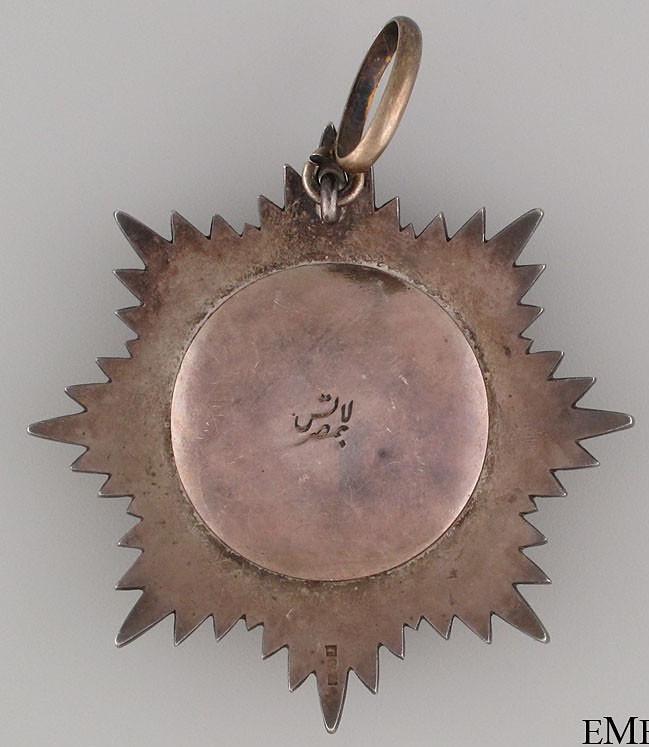
Photo of the reverse of the sash badge from the same eMedals set of the Chamber of Deputies regalia showng the maker's mark in the center of the boss and the position of the 3 Egytian silver assay hallmarks on the center of the most inferior ray of the embellishment. This example shows the same Arabic script Lattes manufacturer's hallmark and placement of the assay hallmarks as seen on the 1st example in this post from The Oriental Treasures website.
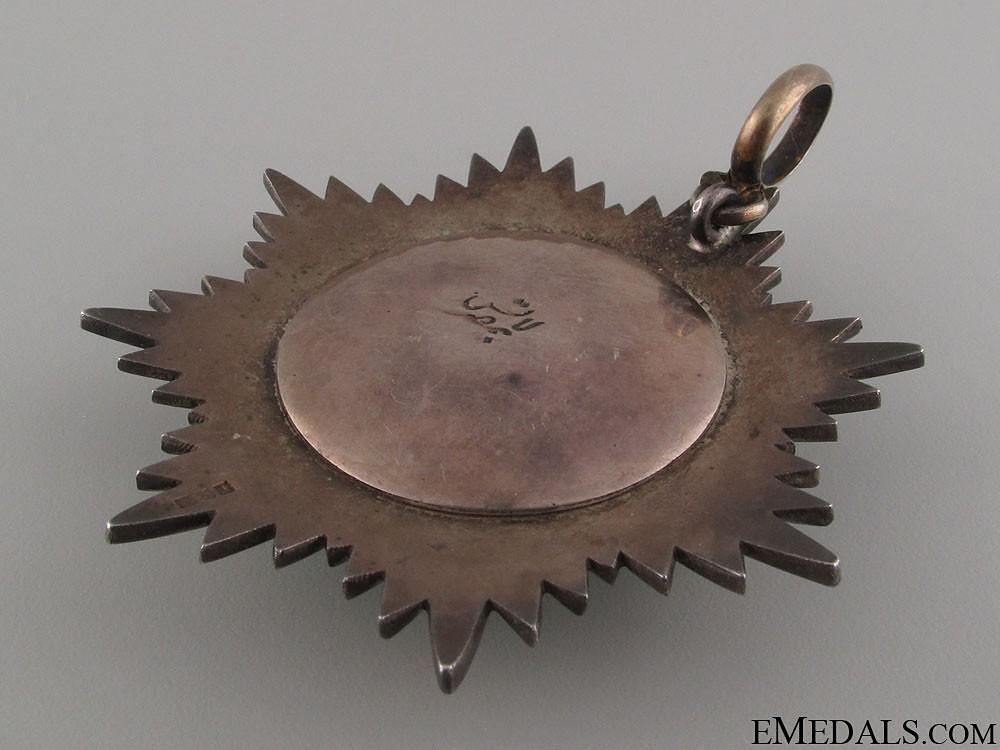
Oblique view of the reverse of this same same sash badge.
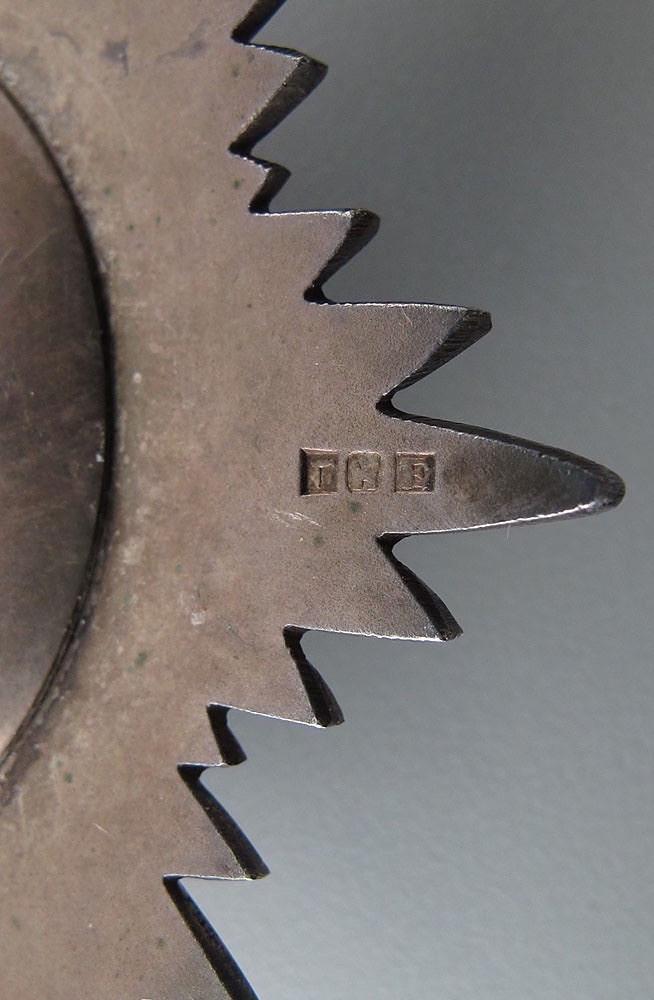
Rotated close-up view of the 3 Egyptian assay hallmarks on the same sash badge of the Chamber of Deputies. This image shows the "E" data hallmark (1930-1931) somewhat more clearly, but the silver purity hallmark (probably 900 silver) from the Cairo office is not much clearer than on the photo of the hallmark on the reverse of the neck badge (of the Chamber of Senators) from this set.
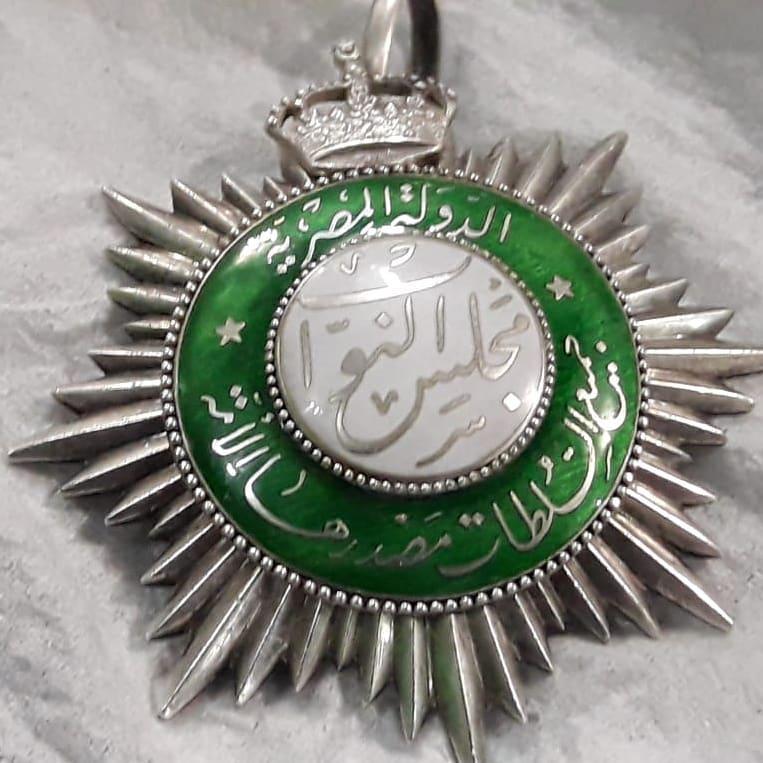
An example of possible Egyptian Parliament Chamber of Deputies neck badge or sash badge, from the Gramho.com Instagram site (https://gramho.com/media/1930336425275049855). This example sports a crown suspension device attached to the suspension ring. I do not know if this may be a variant of the Egyptian Parliamentary insignia or an indication of a problem with this piece?
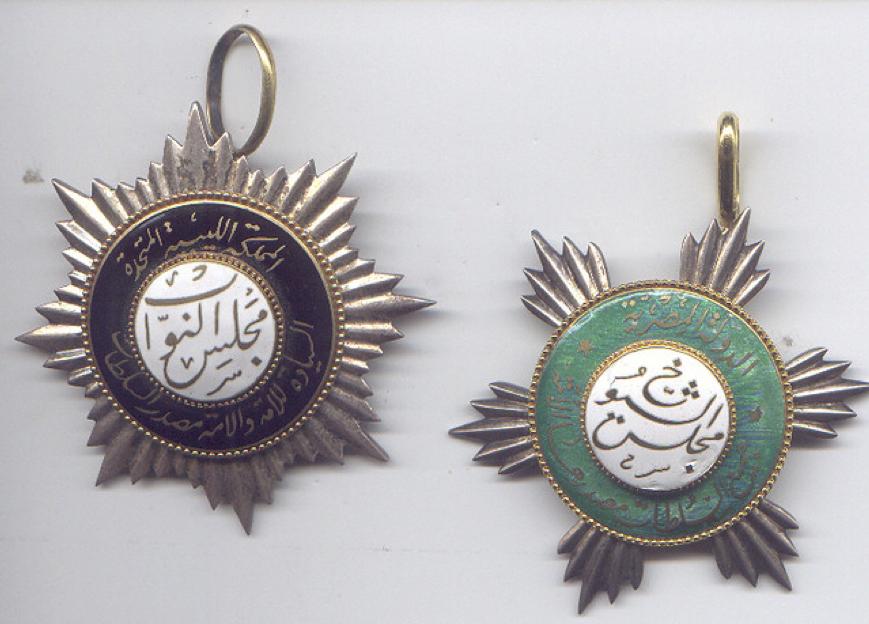
Example of an Egyptian neck badge of the Chamber of Senators on the right and the very similarly designed Parliamentary insignia (Majlis al Nawab) in black enamel that Owain mentioned on the left. This photo is from the flickr photostream of Hassan Kamel-Kelisi-Morali (https://www.flickr.com/photos/kelisli/3048891899/in/photostream/), courtesy of Catherine Bichay, and is copyrighted by Hassan Kamel-Kelisi-Morali.
Owain provided good illustrations of the Libyan insignia in the following link:
Below are several undated images also from Hassan Kamel-Kelisi-Morali's flickr photostream showing original painted designs of the insignia for the Egyptian Parliament's Chamber of Deputies and the Chamber of Senators. These designs were created by J. Lattes. All of these images are courtesy of Catherine Bichay and are copyrighted by Hassan Kamel-Kelisi-Morali.
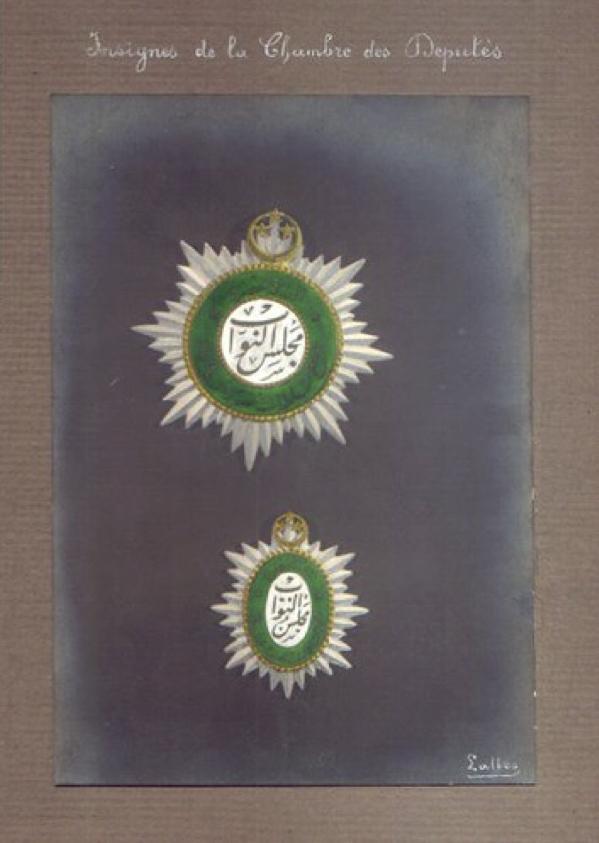
Original painted design for the insignia of the Egyptian Chamber of Deputies by J. Lattes (https://www.flickr.com/photos/kelisli/3049733618/in/photostream/). Above is the design employed for the neck badge (and sash badge?) and below is the design for the lapel badge. Did the Chamber of Deputies also have a sash badge that is similar to their neck badge and the sash badge example shown above for the eMedals Chamber of Senators set? Note the inclusion of the Ottoman (Khedival) crescent & 3 stars attached to the superior portion of the rayed embellishment, a feature apparently never employed in the construction of these for use by members of the Egyptian Parliament. However, the eMedals sash shown above and the portrait photos below show that this Ottoman-derived symbol was employed as a separate insignia on the Parliamentary sashes.
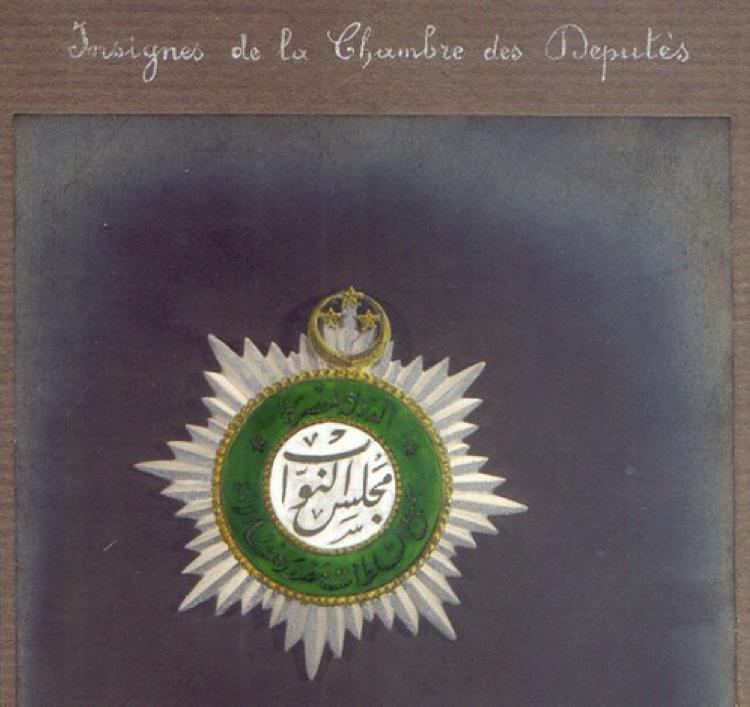
Close-up detail of the neck badge/sash badge design from the same illustration of the Egyptian Chamber of Deputies regalia by J. Lattes (https://www.flickr.com/photos/kelisli/3049733638/in/photostream/).
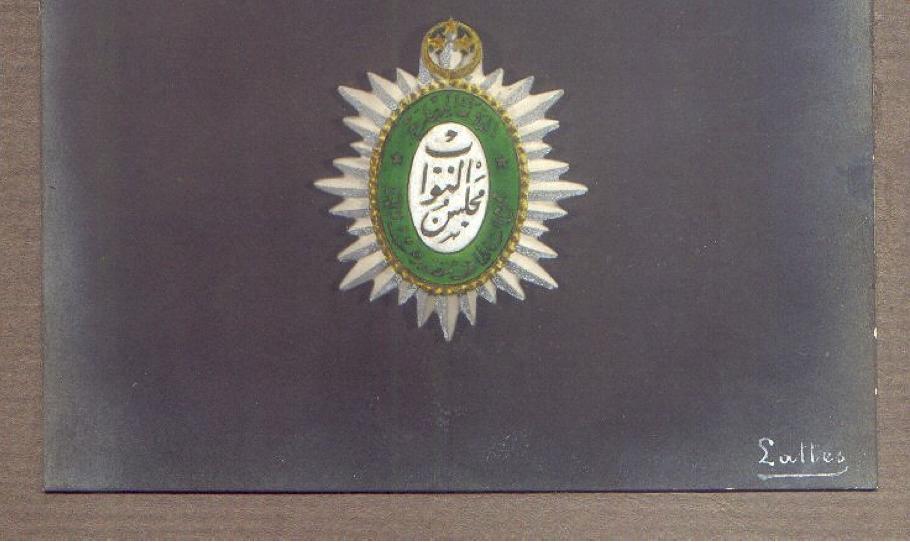
Close-up detail of the lapel badge design for the Chamber of Deputies from the same J. Lattes design illustration (https://www.flickr.com/photos/kelisli/3049733656/in/photostream/).

Illustration of the design for the Chamber of Senators insignia by J. Lattes (https://www.flickr.com/photos/kelisli/3048892191/in/photostream/). This shows the form of the neck badge and lapel badge that was adopted for the Chamber of Senators, as seen in the eMedals set illustrated above (without the crescent & 3 stars). Note the Arabic script name of Lattes in the lower left of this illustration that matches the marks on the reverse of the neck example from The Oriental Treasures and on the reverse of the eMedals sash badge that are shown above.

Detail of the lapel badge from this same illustration by Lattes (https://www.flickr.com/photos/kelisli/3049734076/in/photostream/).
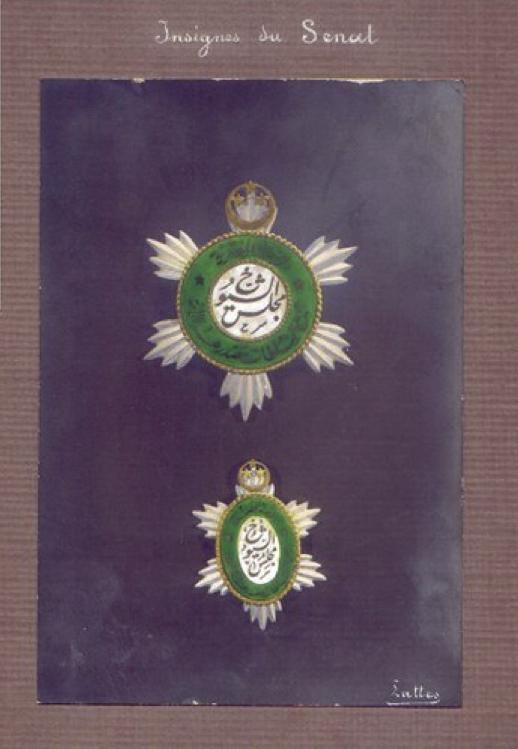
Illustration of a different design version of the insignia of the Chamber of Senators by J. Lattes that includes the crescent & 3 stars addition, contrasting with the design shown the Chamber of Deputies illustration above, that was apparently never adopted for either House of Parliament (https://www.flickr.com/photos/kelisli/3048891967/in/photostream/).
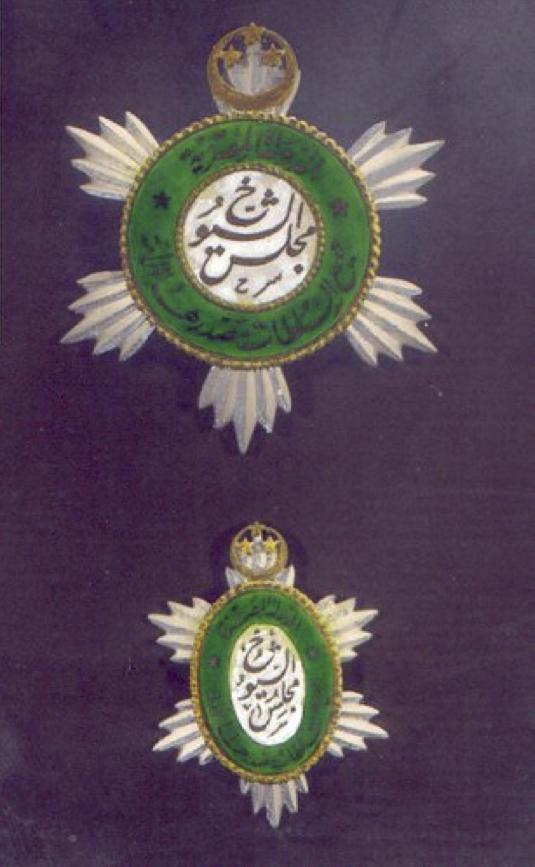
Detail close-up of the design for the Chamber of Senators badges from the same Lattes illustration (https://www.flickr.com/photos/kelisli/3049733852/in/photostream/).
Below are 3 portraits from past eBay auctions of individuals wearing either the Egyptian Parliamentary insignia or that of Libya. The eBay seller who offered these specializes in Egyptian portrait photographs, but also sells material from other Middle Eastern countries. He identified all of these portraits as Egyptians (but mistakenly as judges). There are elements in the costume that make it difficult to be certain these are Egyptian members of Parliament (as the only sash I have been able to check is the eMedals example, and whether that is associated with the Chamber of Deputies as indicated by the attached sash badge or with the Chamber of Senators because of the "associated" neck badge and lapel badge in the set is unclear; and if Egyptian, these may be portraits of individuals in the Chamber of Deputies, based on the form of the lapel badges). Unlike the eMedals sash shown above with no border, all of the sashes worn in these portraits have borders of contrasting colors. All wear a lapel badge of the form that Owain illustrated above as that of the Chamber of Deputies, but none are wearing neck badges. Unfortunately the resolution of these portraits does not permit comparisons of the inscriptions on the badge to Egyptian and Libyan Parliamentary insignia. I discussed these portraits near the end of my post of 7 November, 2018 on the thread "Egyptian Khedival Judges Badge question" that I stated on 17 November, 2016 here in the "Middle East & Arab States" section, to correct the identifications I had previously mistakenly made by included their portraits in other posts as "judges".
Studio portrait of an individual who may be a member of the Egyptian Parliament showing the sash with crescent & star pin, sash badge, and lapel badge. This could be a member of the Libyan Parliament, although the eBay source of this portrait identified it as that of an Egyptian, although mistakenly stated to be that of a judge. I contacted the seller and he changed part of the identification to a member of Parliament, as can be seen in the former link: https://www.ebay.com/itm/Armenian-photographer-in-Egypt-member-of-the-Egyptian-Upper-House-of-Parliament/273500928337 to this image own eBay. The form of the lapel badge is similar to that illustrated by Owain (and in the Lattes design illustrations) above for the Egyptian Chamber of Deputies, not the Egyptian Chamber of Senators.The dark border of the sash is not seen on the Parliamentary sash from the eMedals auction set above. Was there a different border for the sashes worn by the Chamber of Deputies compared with that of the Chamber of Senators? No neck badge is present. The photo above was identified as an 18 x 13 cm original print from Egypt, taken by an Armenian studio, K. Papazian in Cairo. I previously illustrated this portrait as the 6th photo in my post of 7 November, 2018 on the Mixed Courts of Egypt.
Another image of an individual who may be a member of the Egyptian Chamber of Deputies, from the same eBay seller as for the individual portrait shown above (https://www.ebay.com/itm/EGYPT-OLD-VINTAGE-PHOTOGRAPH-Judge-with-the-scarf-/273105393192?nordt=true&orig_cvip=true&rt=nc&_trksid=p2047675.m43663.l44720). This 14 x 9 cm original print was from a past eBay auction with the identification: "Egypt old vintage photo of judge with scarf". His sash has an identical dark border to that shown above, the crescent & 3 stars pin, and he wears the same form of lapel badge as shown in Owain's post above and in the Lattes designs identifying the Chamber of Deputies. He also is not wearing a neck badge. I included this image as the 4th photo in my post of 7 November, 2018.
Another eBay photo of a man who may be a member of the Egyptian Parliament (https://www.ebay.com/itm/EGYPT-OLD-VINTAGE-PHOTOGRAPH-Judge-With-a-medal-and-scarf/273500915471). I previously used this image as the 7th photo in my post of 7 November, 2018. His sash shows what appears to be a lighter border than the two portraits above (although it can be quite difficult to distinguish actual colors in black & white images depending on lighting, etc.), it also exhibits the same crescent & 3 stars pin. His lapel badge is the same form shown in Owain's post above and the Lattes design illustrations for the Chamber of Deputies. No neck badge is present. Unlike the 2 portraits above, this man wears a turban and gallibaya. This 22 x 15 cm original print was described as from Egypt, but no studio was identified. This portrait also was mistakenly identified by the eBay seller as that of an Egyptian judge (understandably, as judges of the Egyptian Indigenous Courts wore a sash with a crescent and 1-9 stars [and 3 was a common configuration], although some scrutiny is need to see that the form of that sash and the configuration of the crescent & stars is quite different than the pins in these portraits and the one shown attached to the emedals Parliamentary sash).
0 -
Amidst the COVID-19 troubles to health and the global economy, scofflaws who think masks & other health measure infringe on their "personal freedoms" (especially here in the US), ethnic injustice, political selfishness, and global warming that fill the news, this is a piece of well-needed joyous celebration about an honour recognizing Capt Tom as a Knight Bachelor. This whole story has been a very moving demonstration of selflessness & personal duty (See, among others: https://www.telegraph.co.uk/news/2020/07/17/captain-tom-moore-knighthood-sir-knighted-queen-ceremony/). Three cheers for Capt Sir Tom Moore!
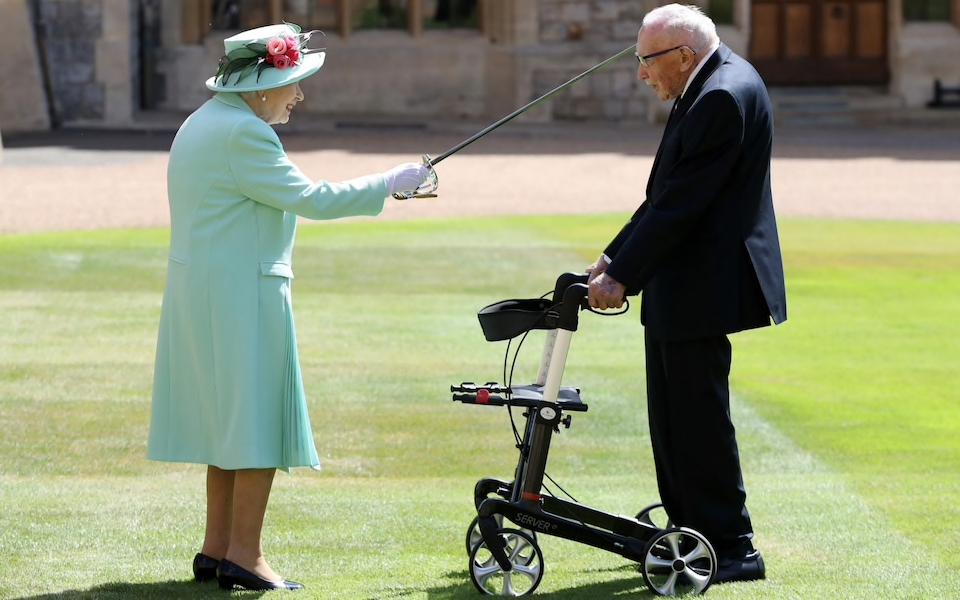
CREDIT: Chris Jackson
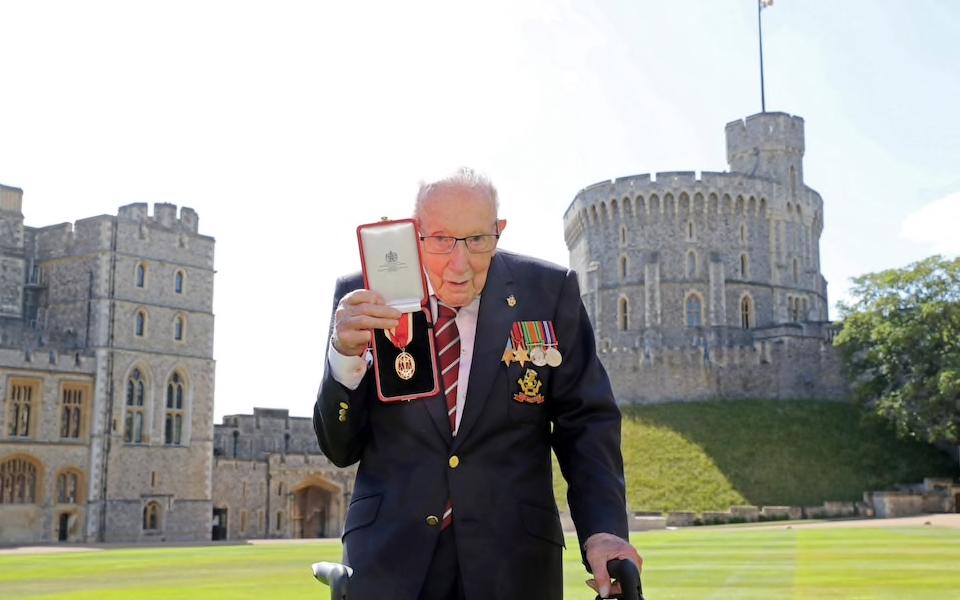
CREDIT: Chris Jackson/Pool via Reuters
0




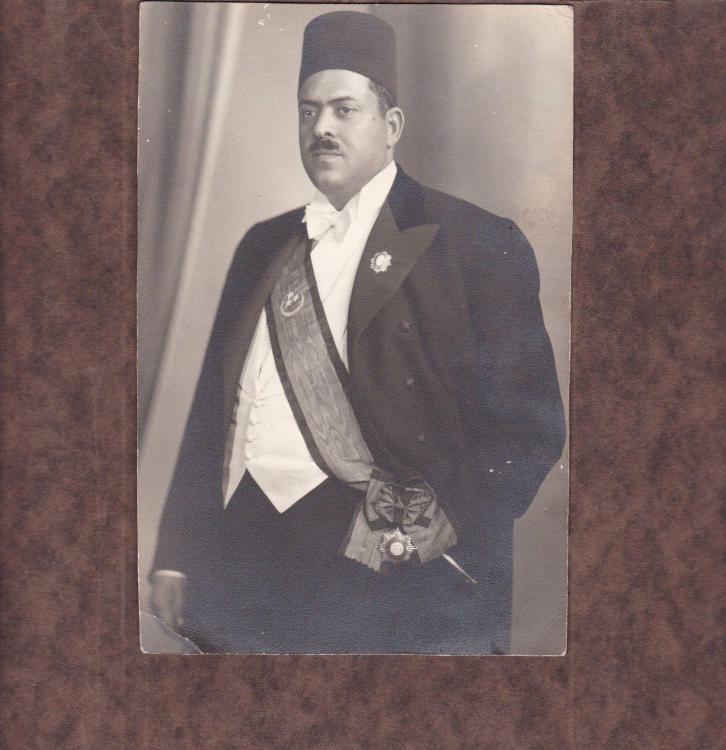
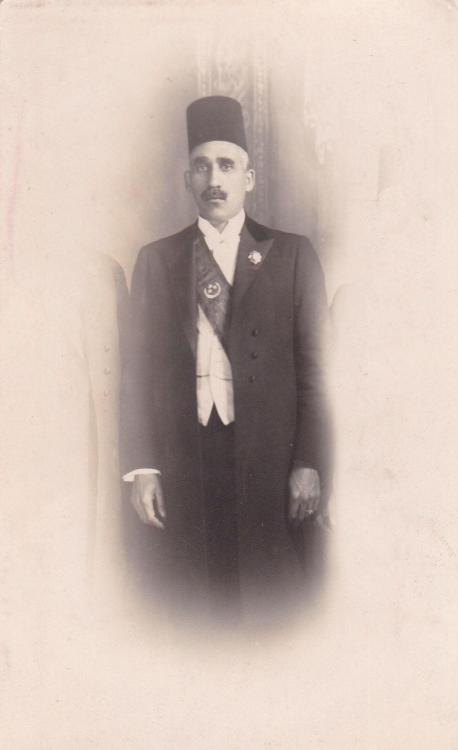
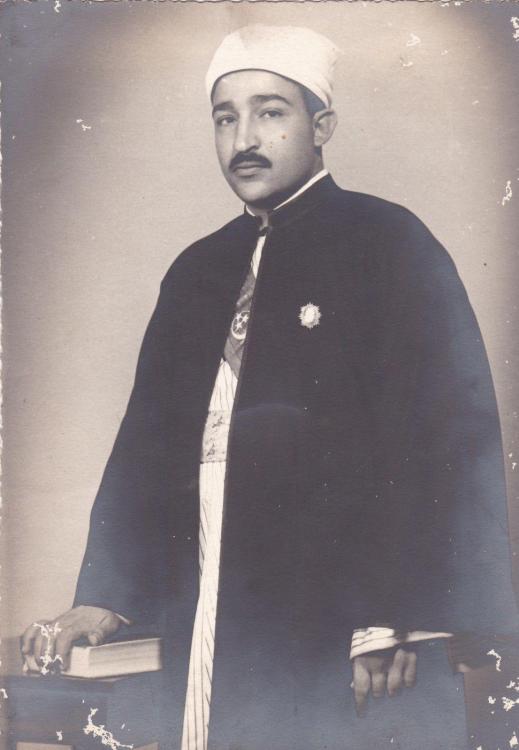
SIR HARRY SMITH 1851 MEDAL
in Great Britain: Empire: Colonial Including South Africa & India: Awards, Militaria & History
Posted · Edited by Rusty Greaves
Above is a moderate-resolution photo from a Spink archive (https://www.spink.com/lot/18002000236) of a 24 July, 2018 auction (18002, Lot 236), of a Sir Harry Smith Medal for Gallantry 1851 to John Keilberg. The Spink listing states that: "31 such medals are believed to have been awarded and, of the 22 known surviving examples, 11 are unnamed; this suggests that they were issued thus." Higher resolution versions of this same image can be viewed & zoomed on the salesroom website (https://www.the-saleroom.com/en-gb/auction-catalogues/spink/catalogue-id-srspi10178/lot-65be9677-5c0a-4733-836e-a914011ee946), but are hard to download.
Above is a high-resolution image of an unnamed award of a Sir Harry Smith Medal for Gallantry 1851 with ribbon suspension that is archived on the salesroom website (https://www.the-saleroom.com/en-us/auction-catalogues/baldwins/catalogue-id-srbal10030/lot-a5fa926f-6706-4a9b-960d-a5df00c0c0b7). That medal comes from a 3 May, 2016 auction (98) by Baldwin's, Lot 2029 (https://issuu.com/baldwinscoins/docs/baldwins_auction_98_-_3_may_2016_-_/21). The above image can be zoomed for greater detail.
Above is a high-resolution image that can be zoomed for greater detail of a named award to Girt Roots, without suspension device or ribbon. This comes from a 19 July, 2017 auction of Dix Noonan Webb, Lot 862 (https://www.dnw.co.uk/auction-archive/lot-archive/lot.php?lot_uid=295314). The DNW listing also includes the footnote: "Provenance: Spink, 27 March 1992 (Lot 31) ‘A previously unrecorded Harry Smith Medal struck from Obverse Die Number 1 and Reverse Die Number 1.’" The same listing is archived on the salesroom website (https://www.the-saleroom.com/en-gb/auction-catalogues/dixnoonanwebb/catalogue-id-dix-no10037/lot-516a6fbd-dc6d-42d5-8f0b-a7a200bbc33a).